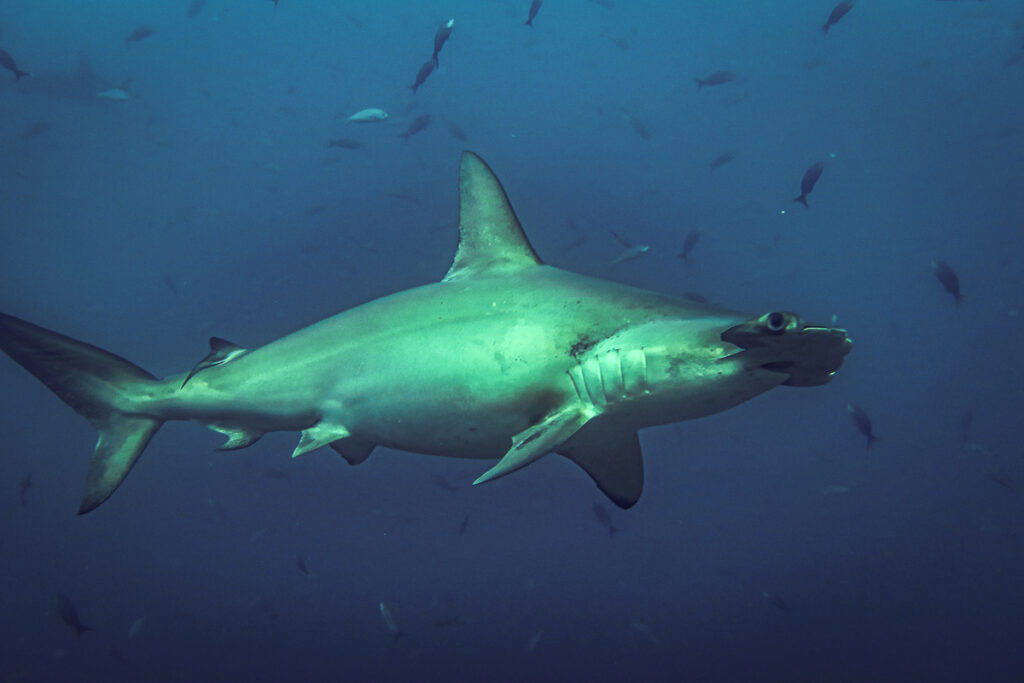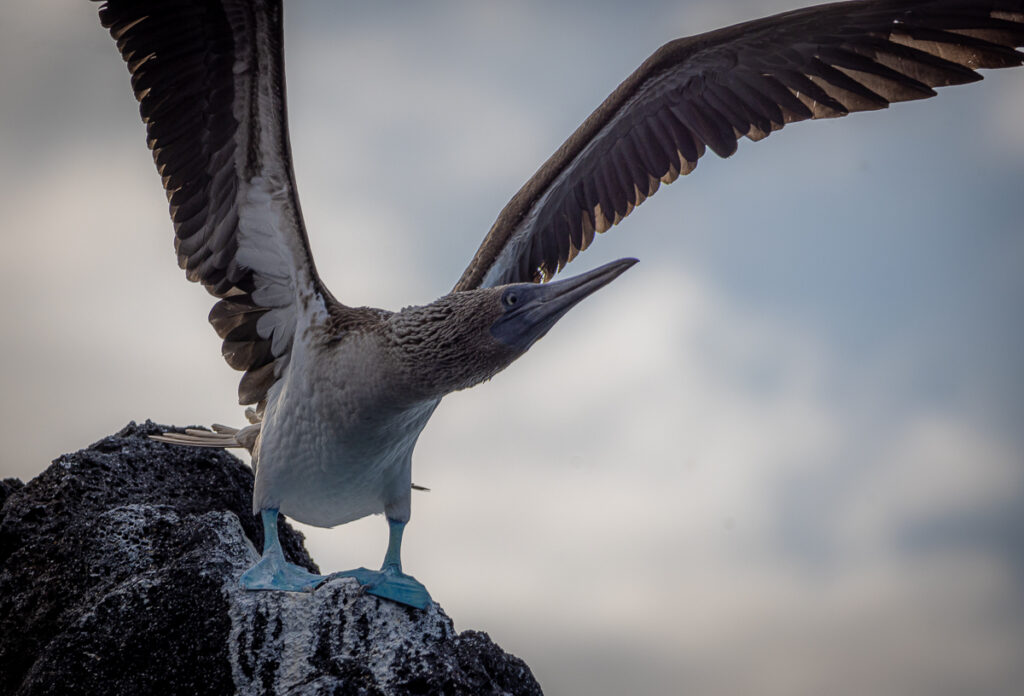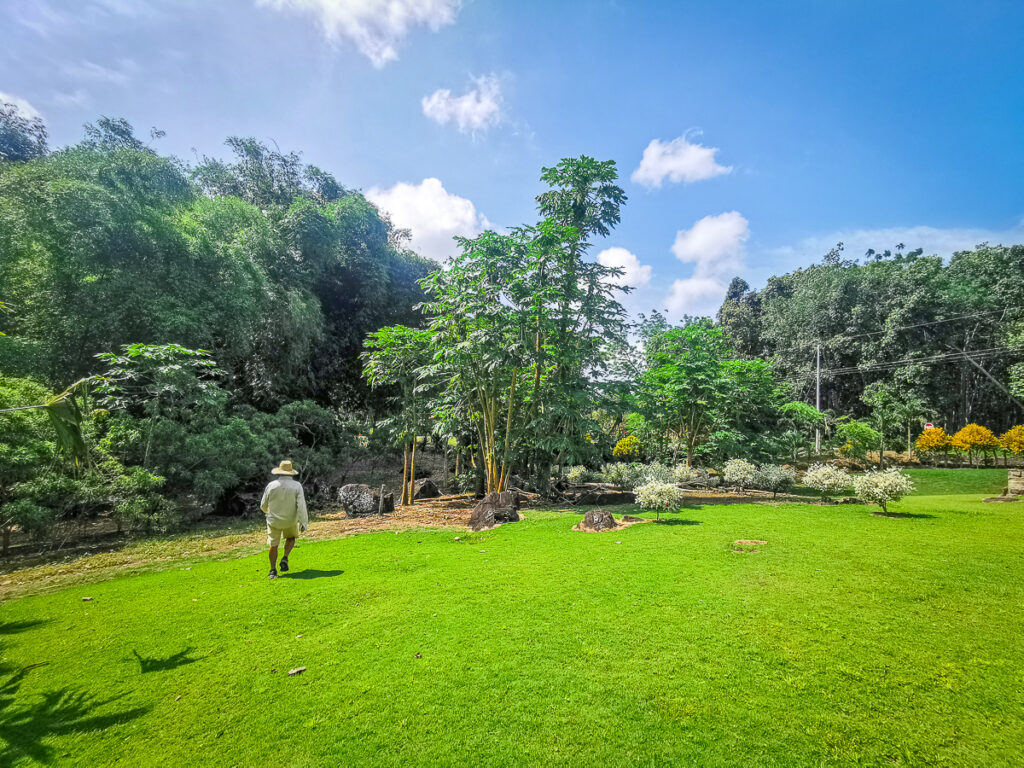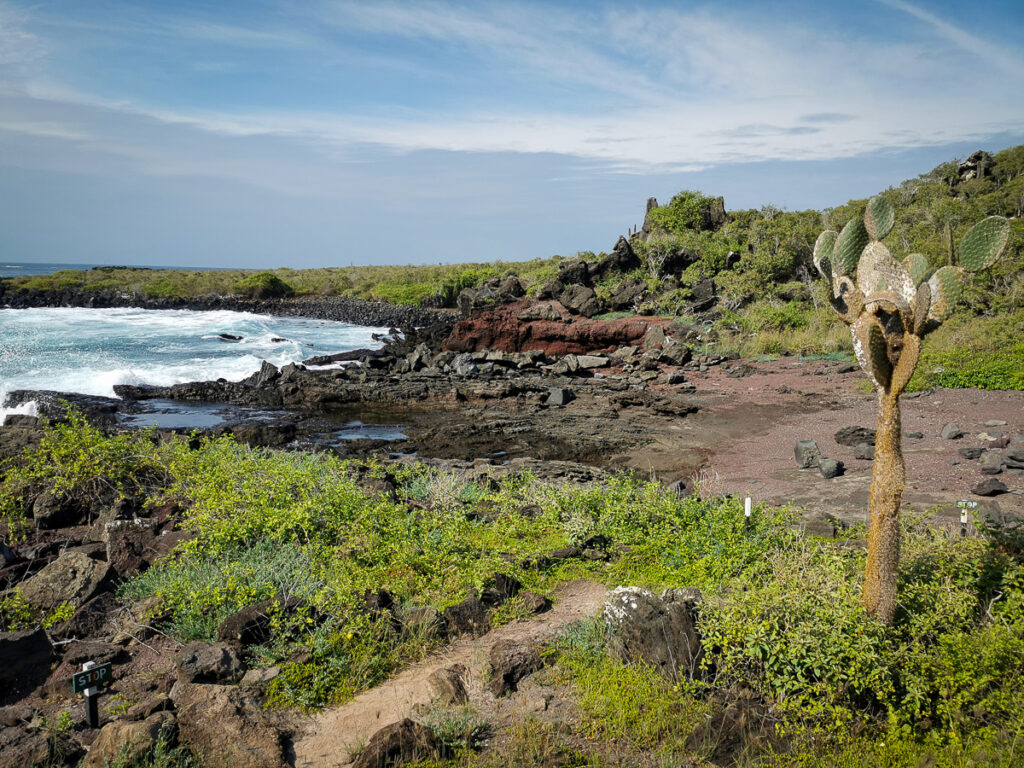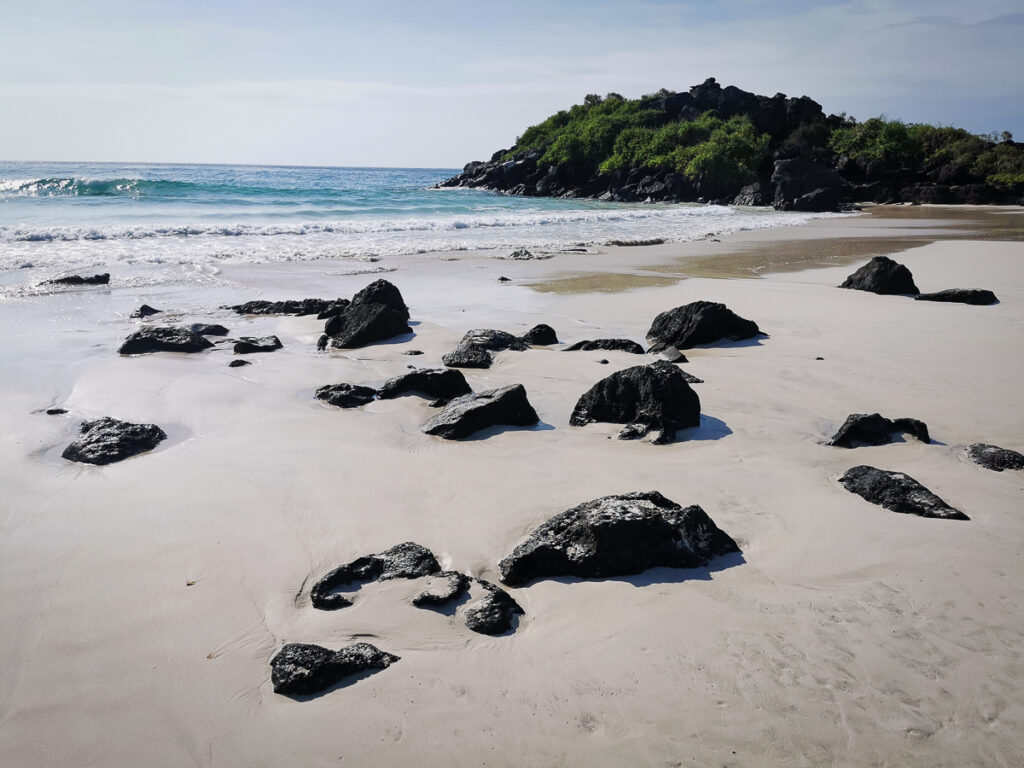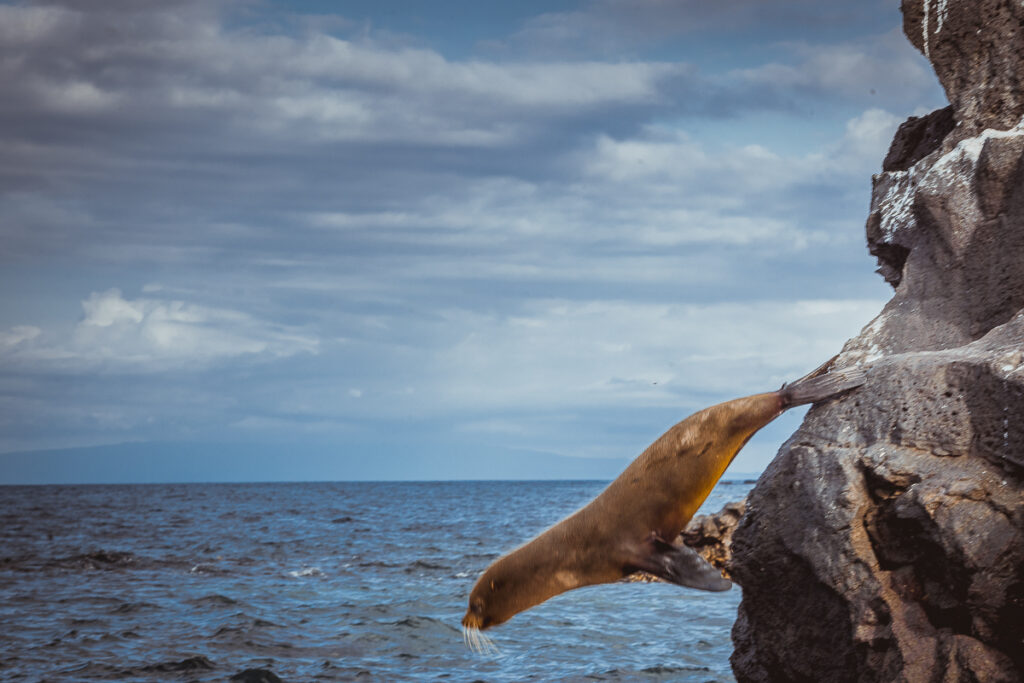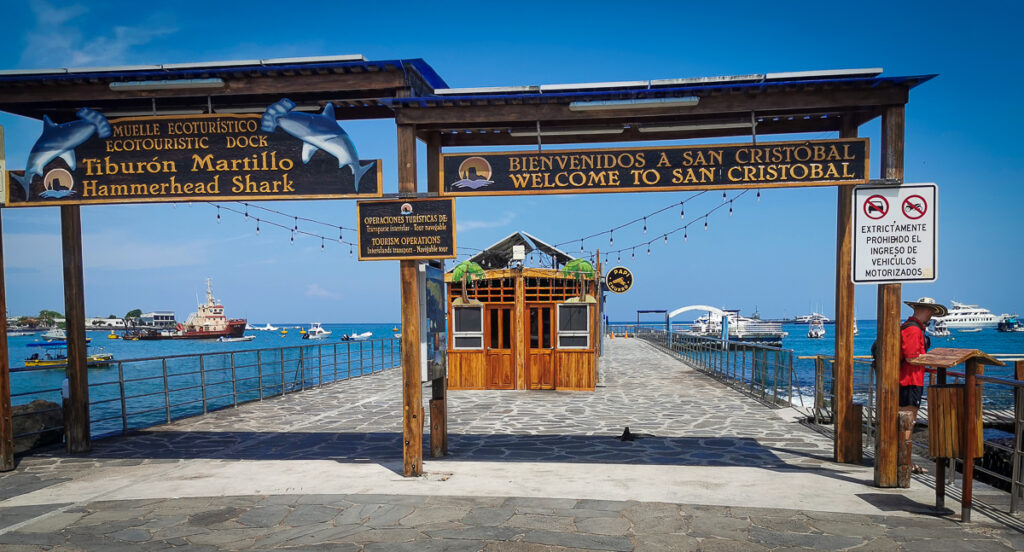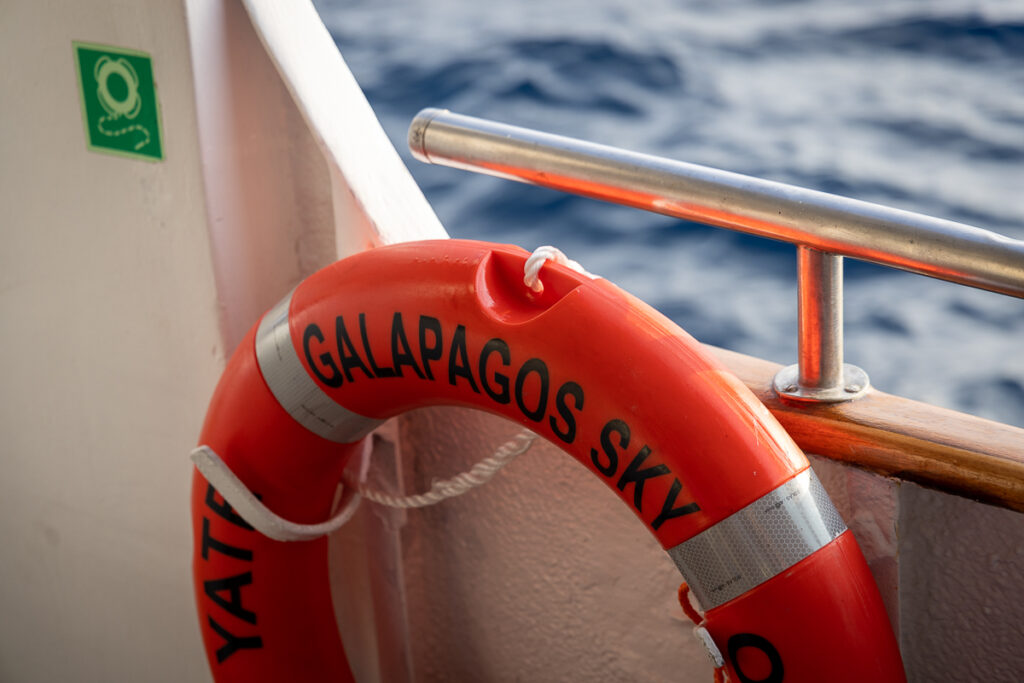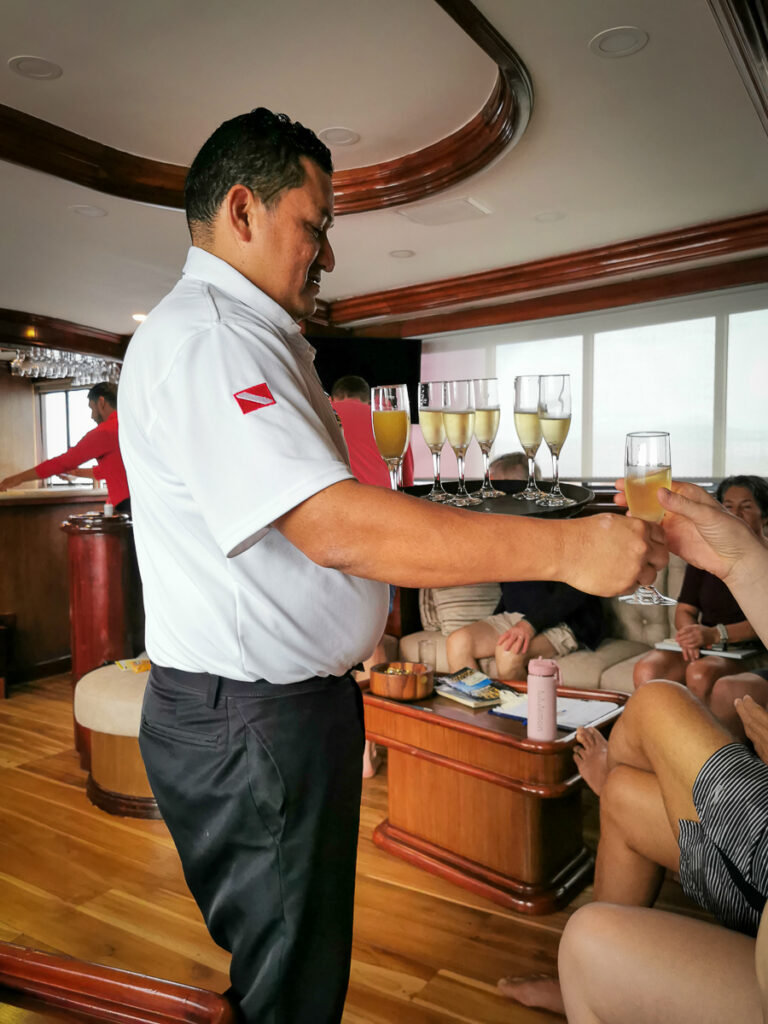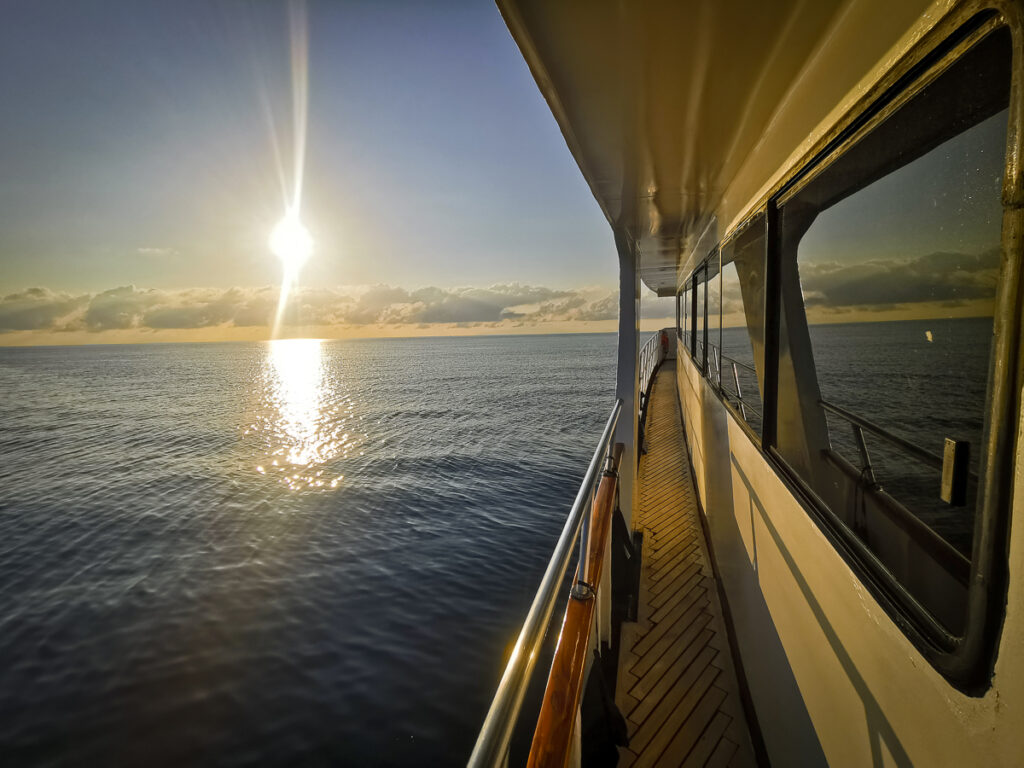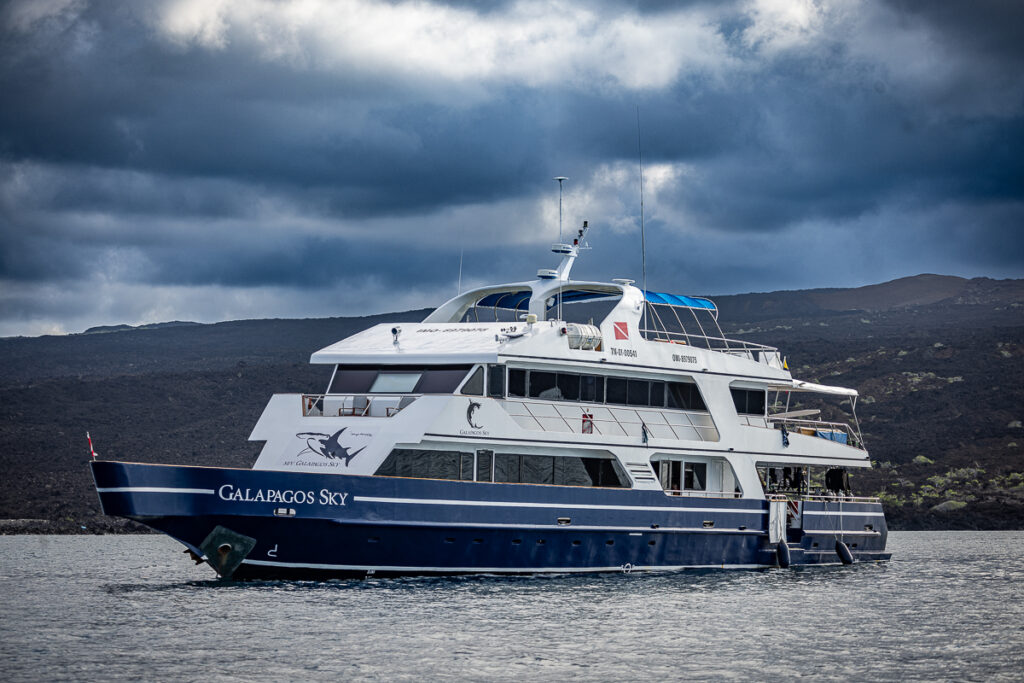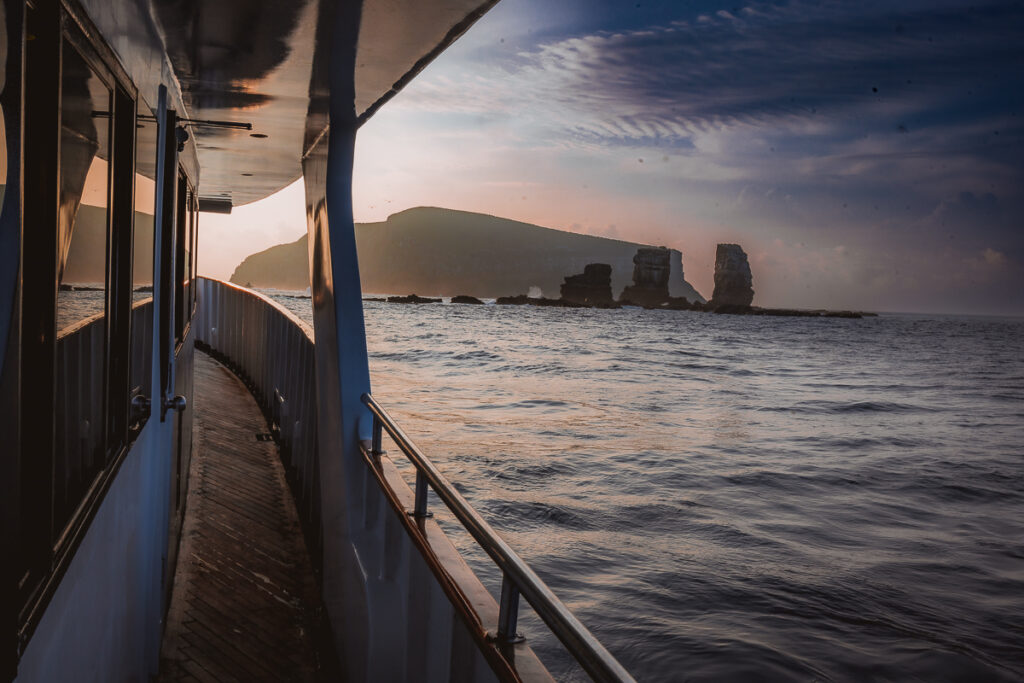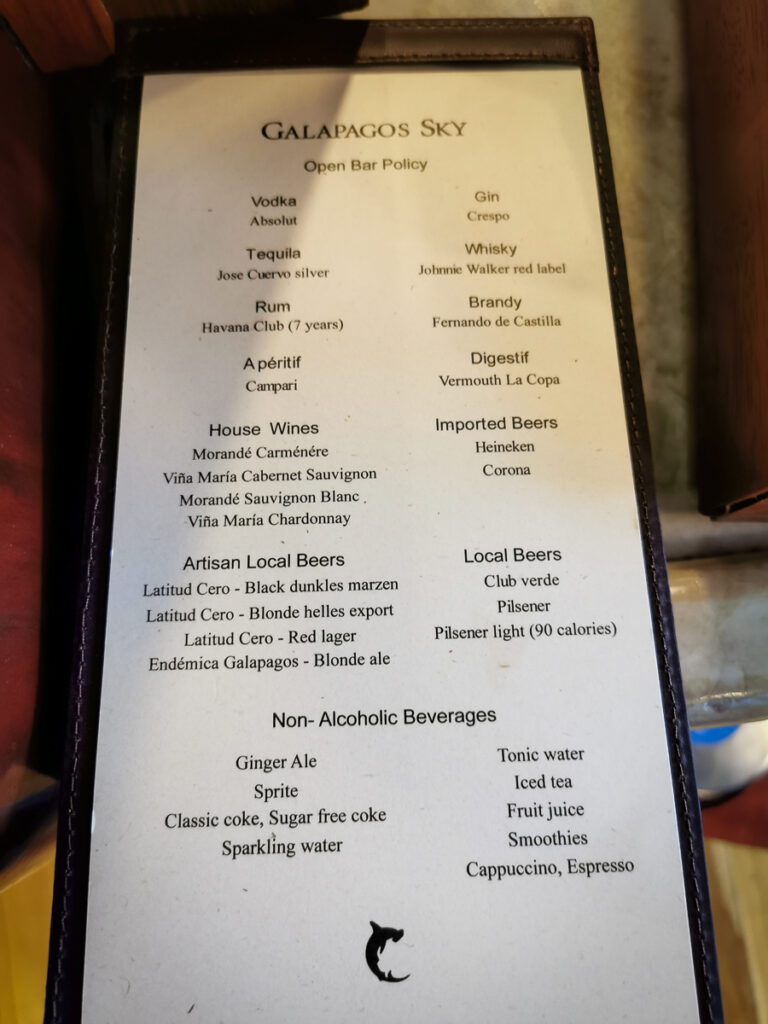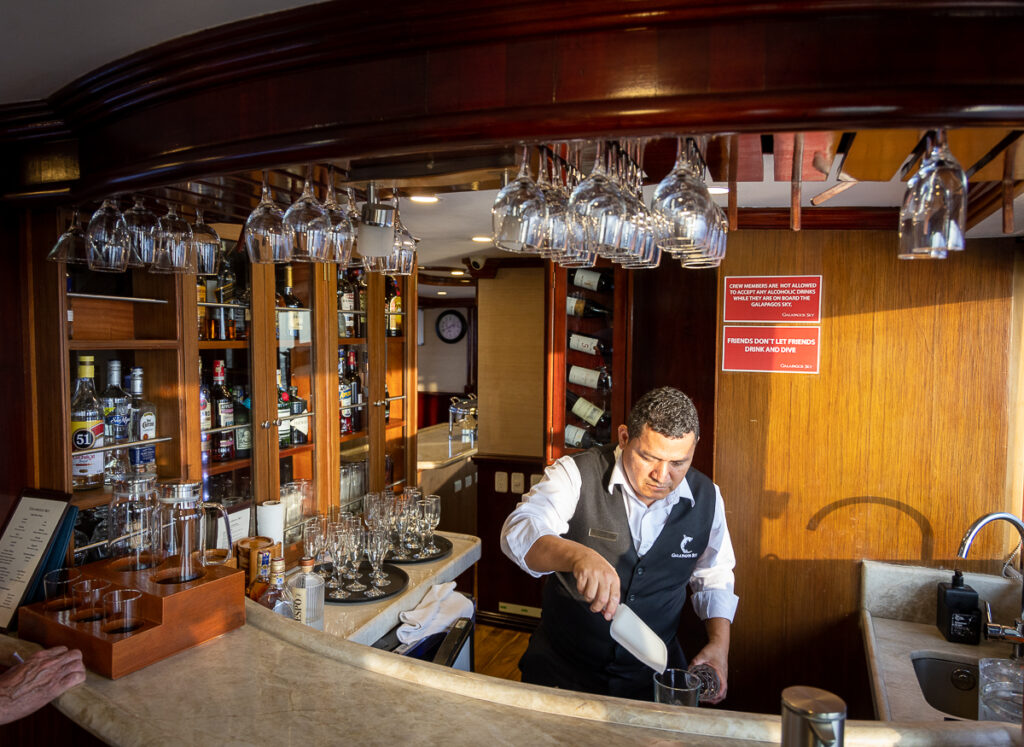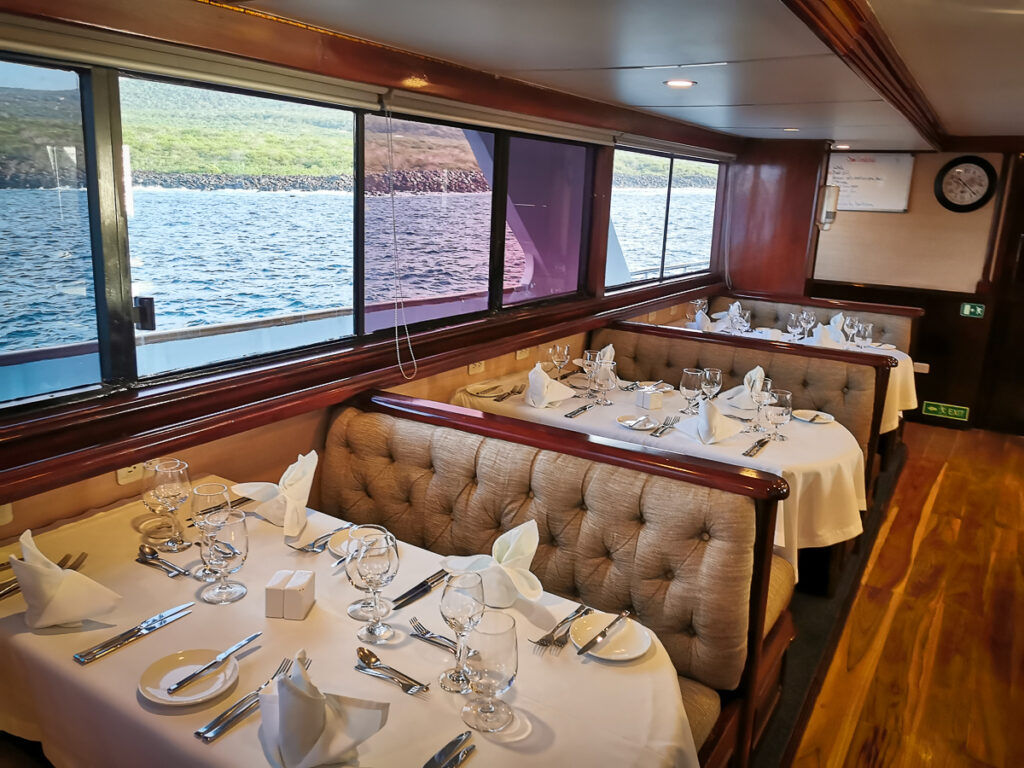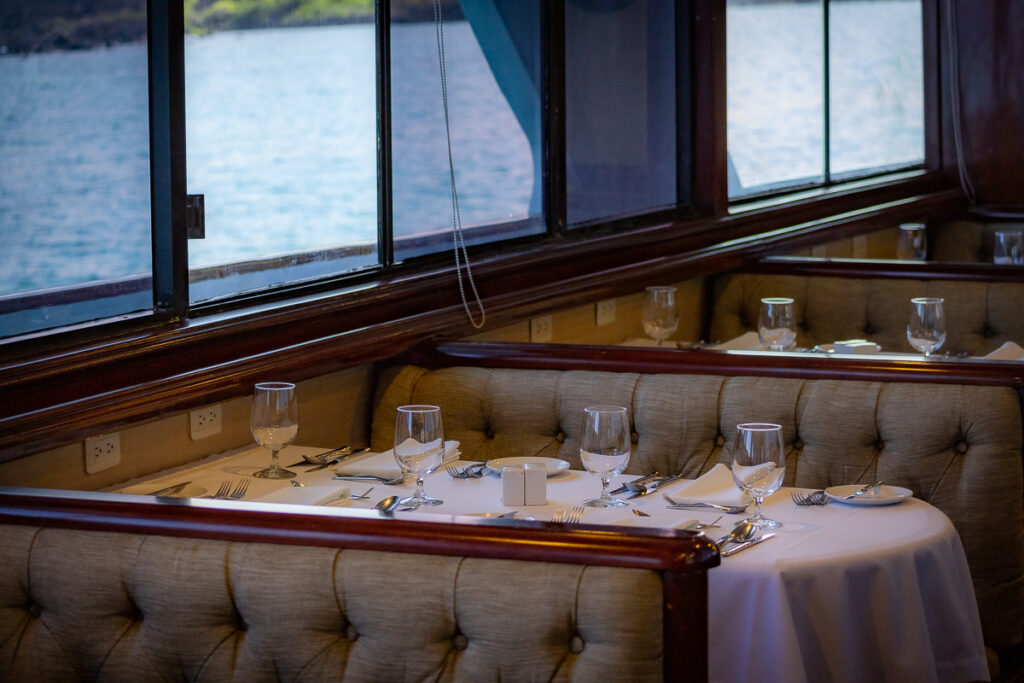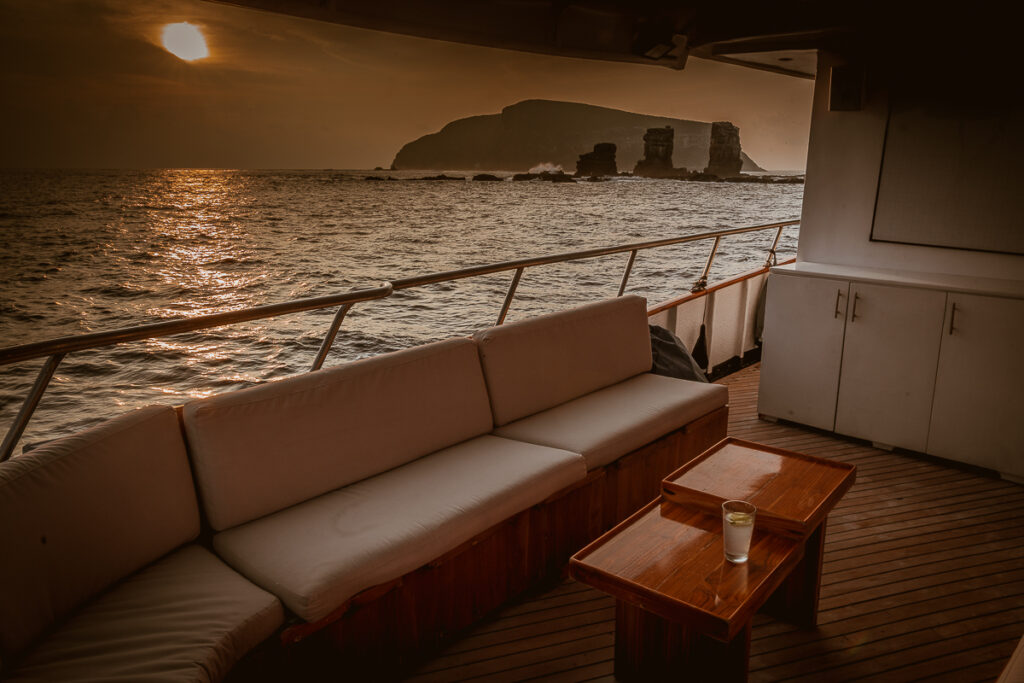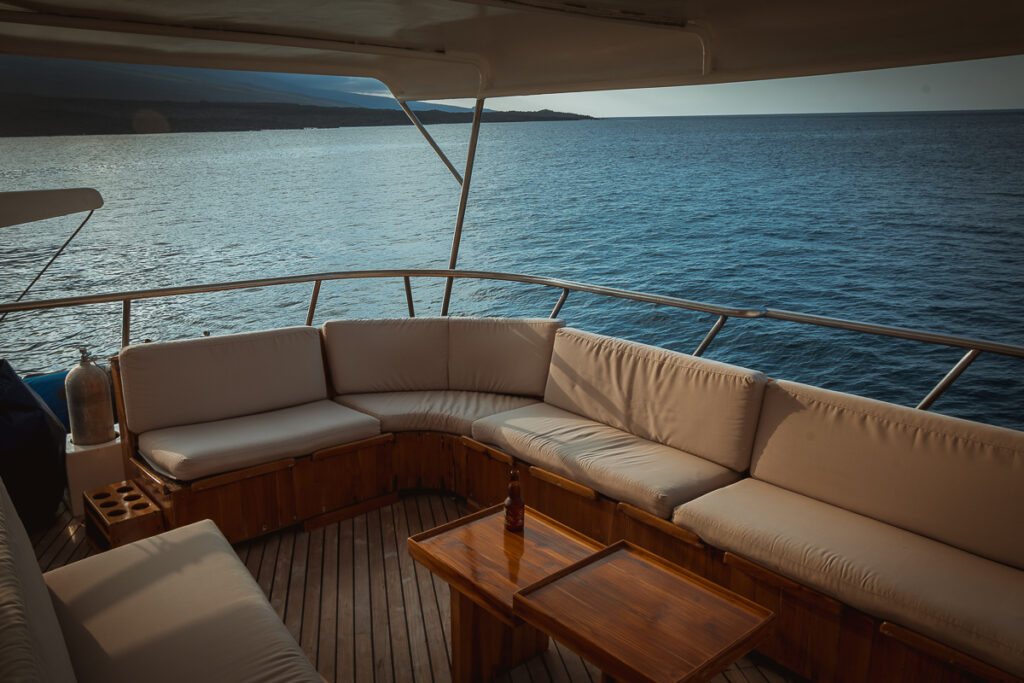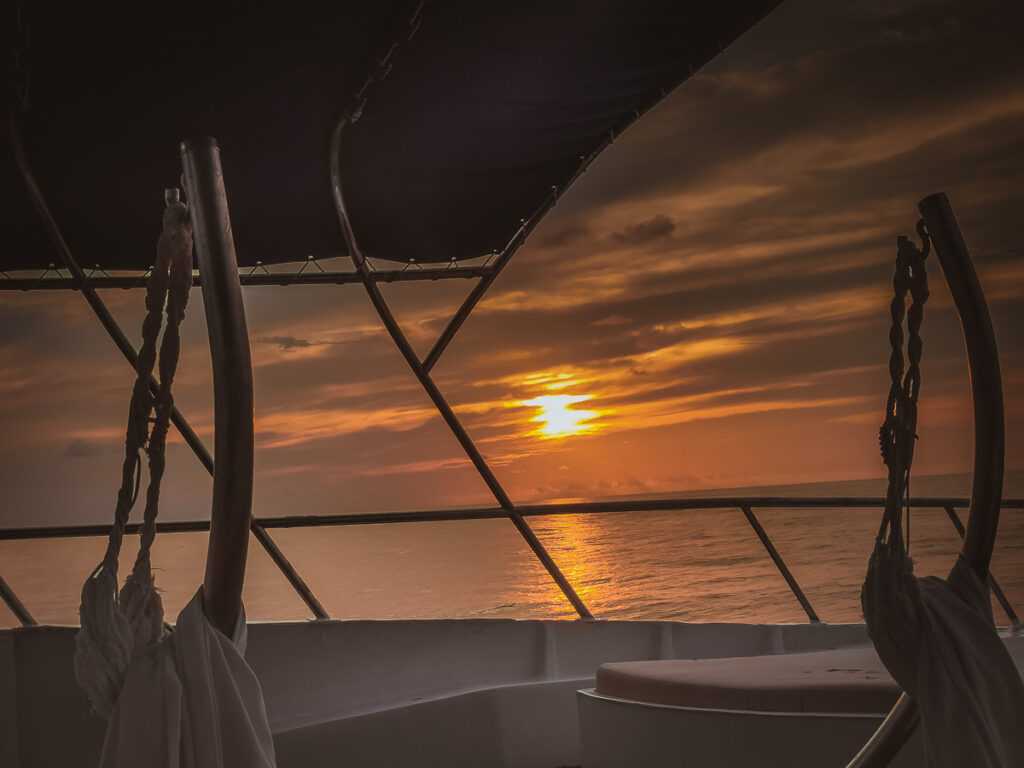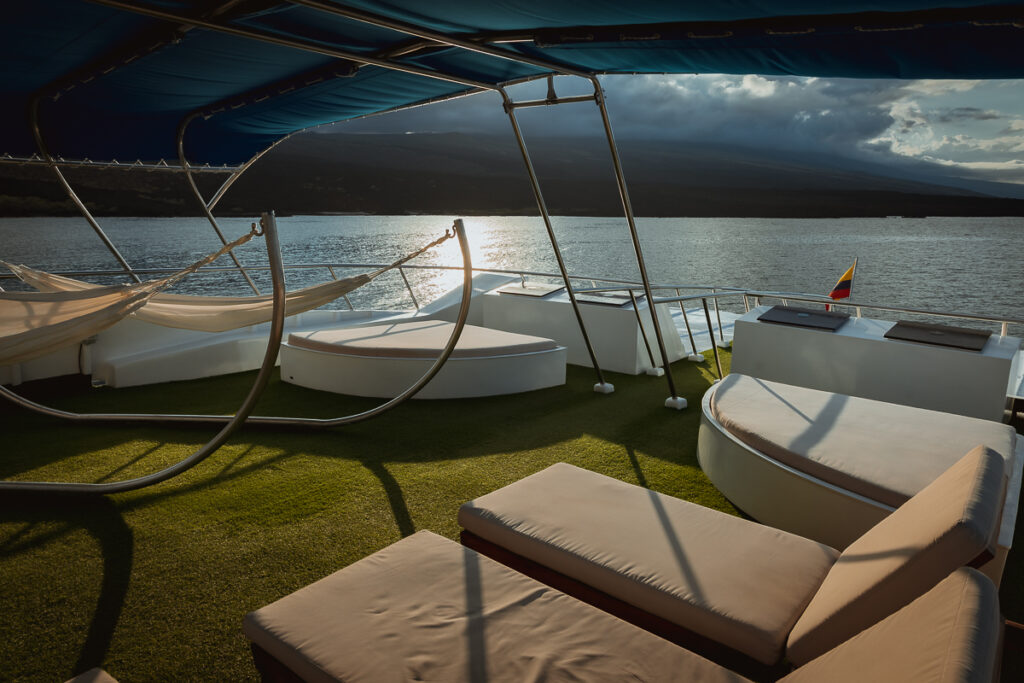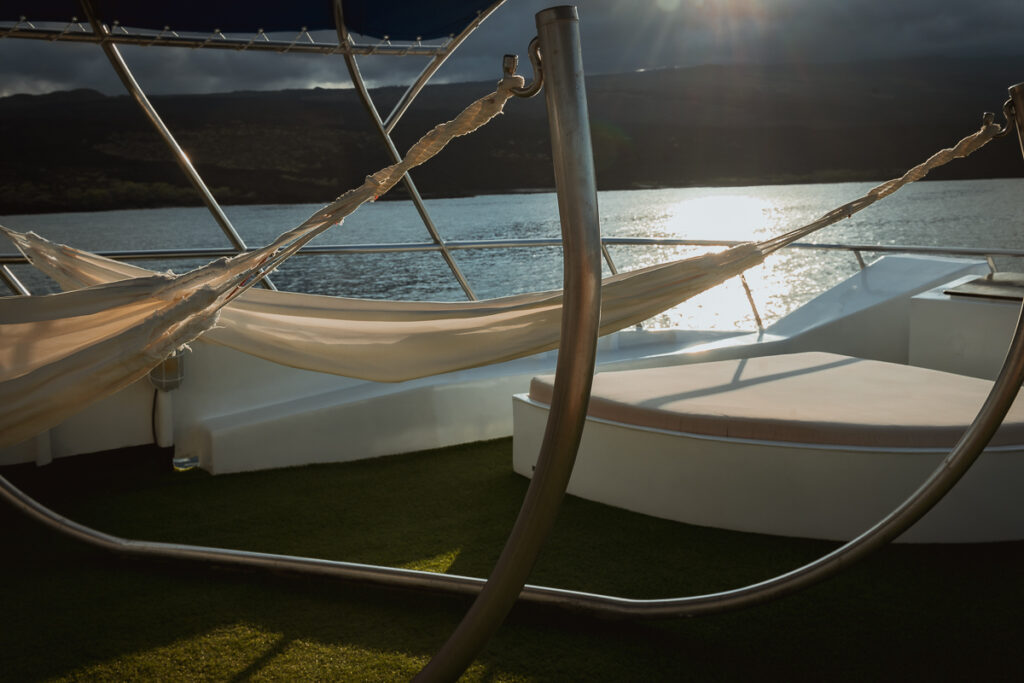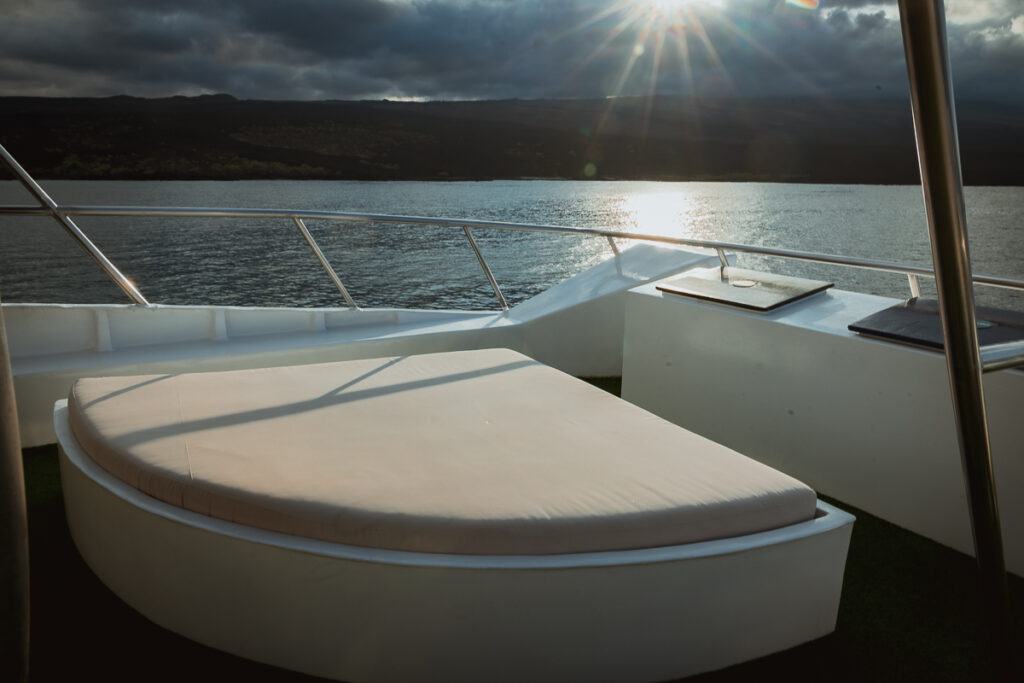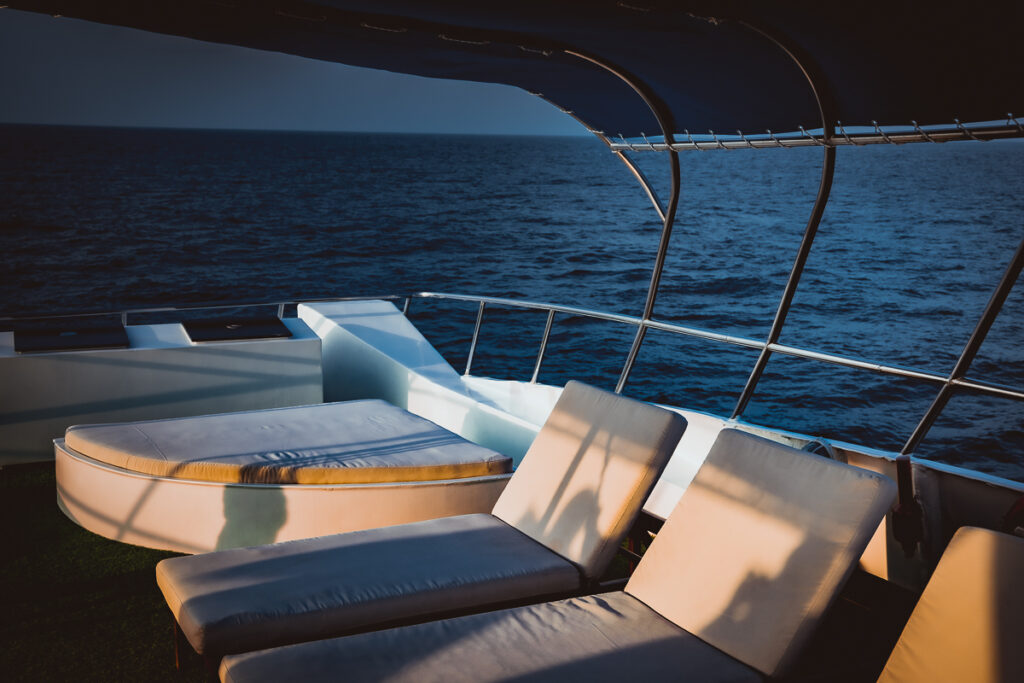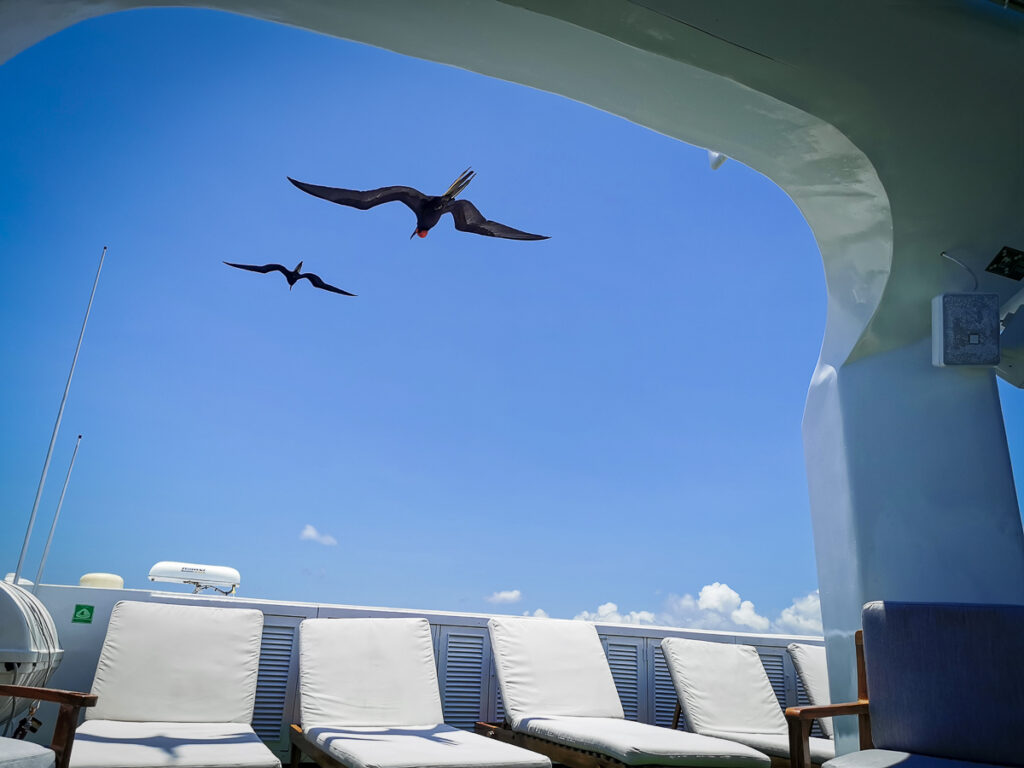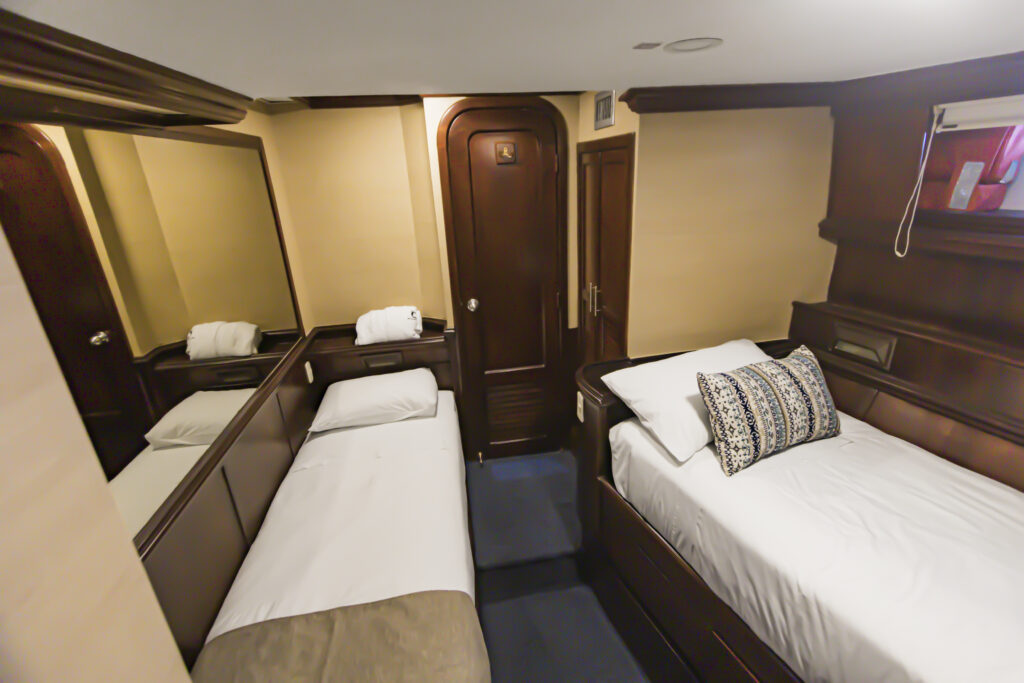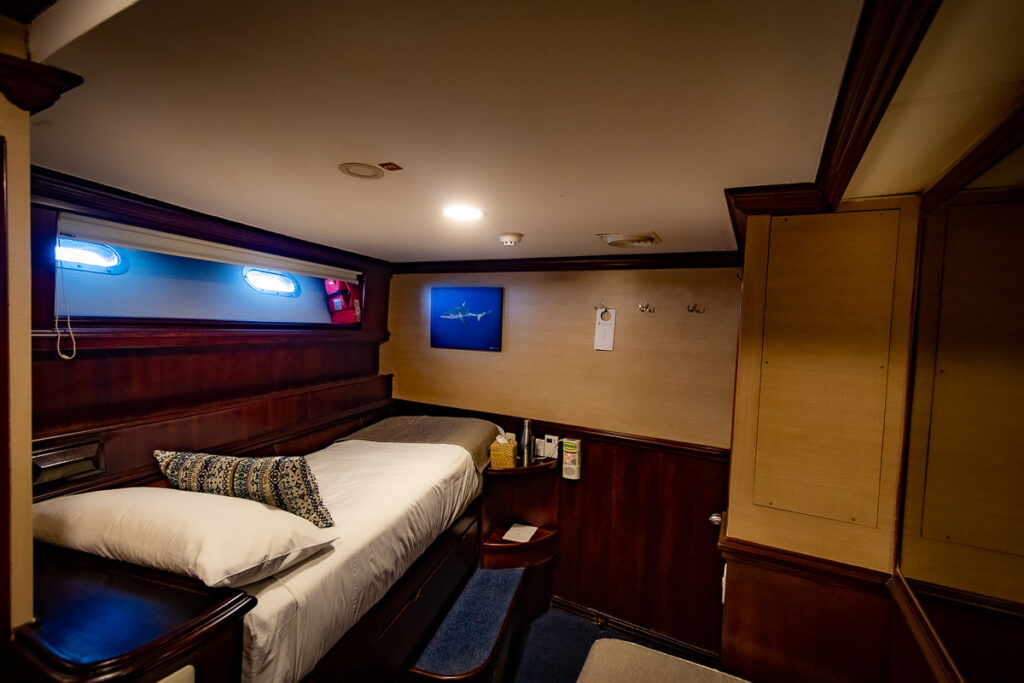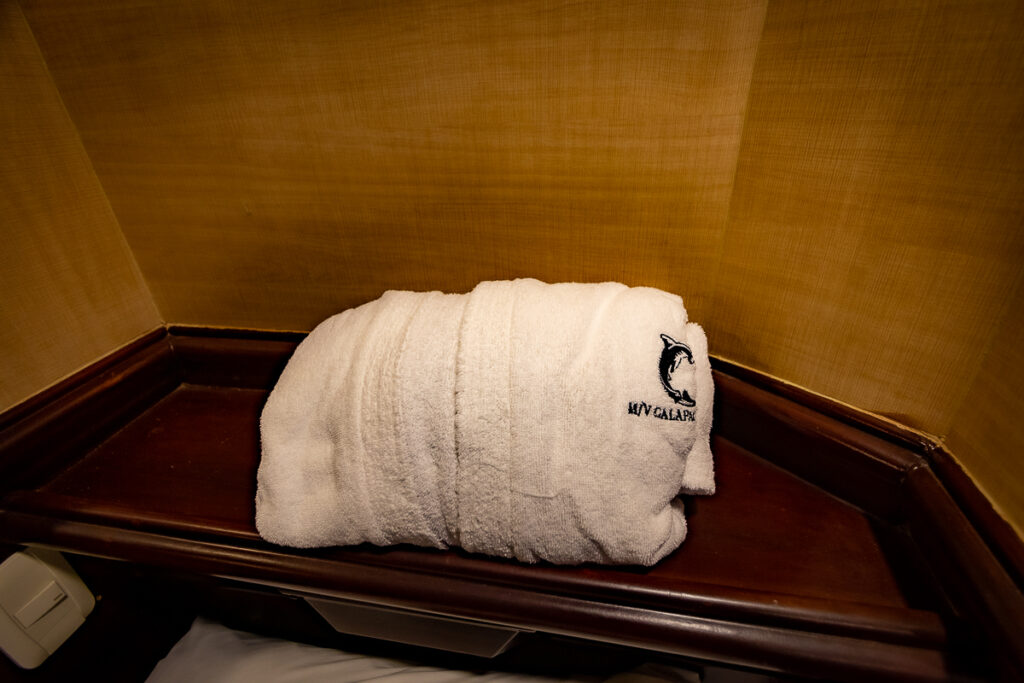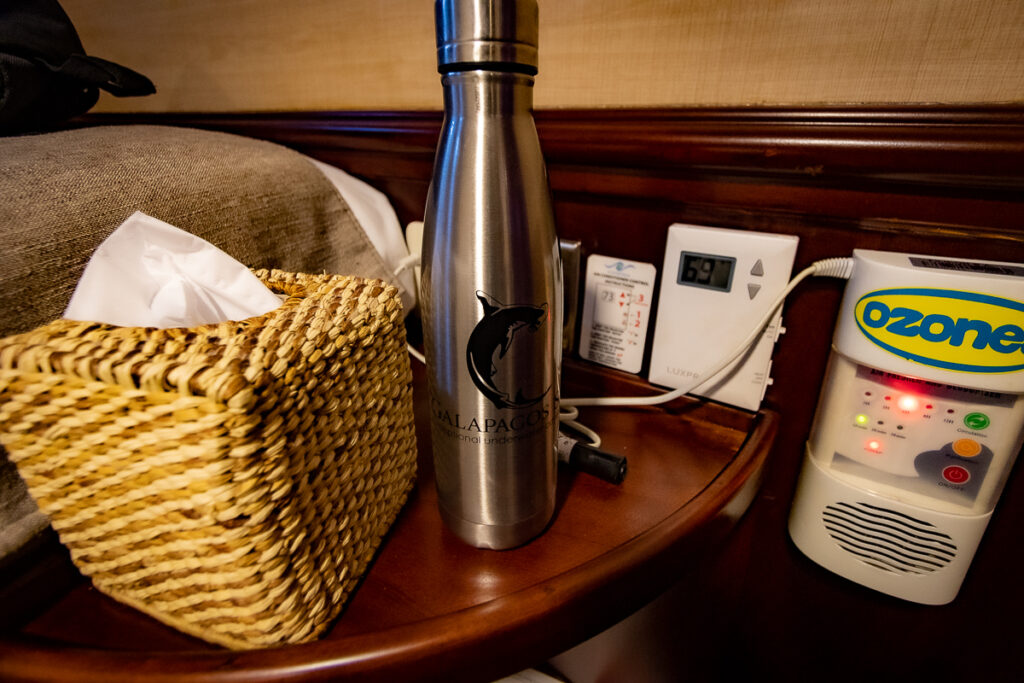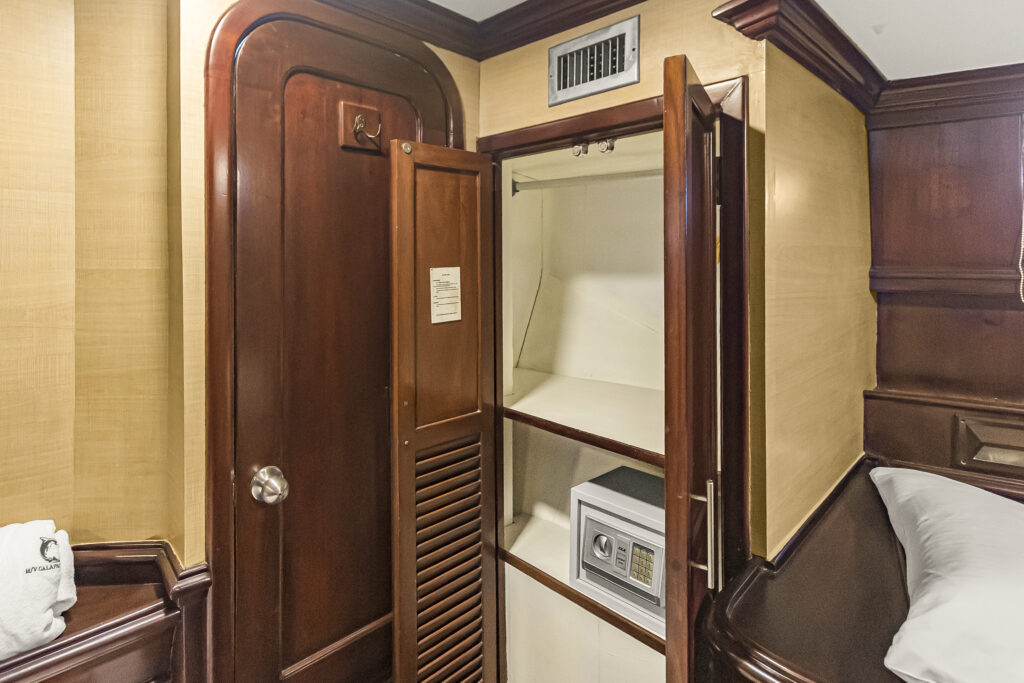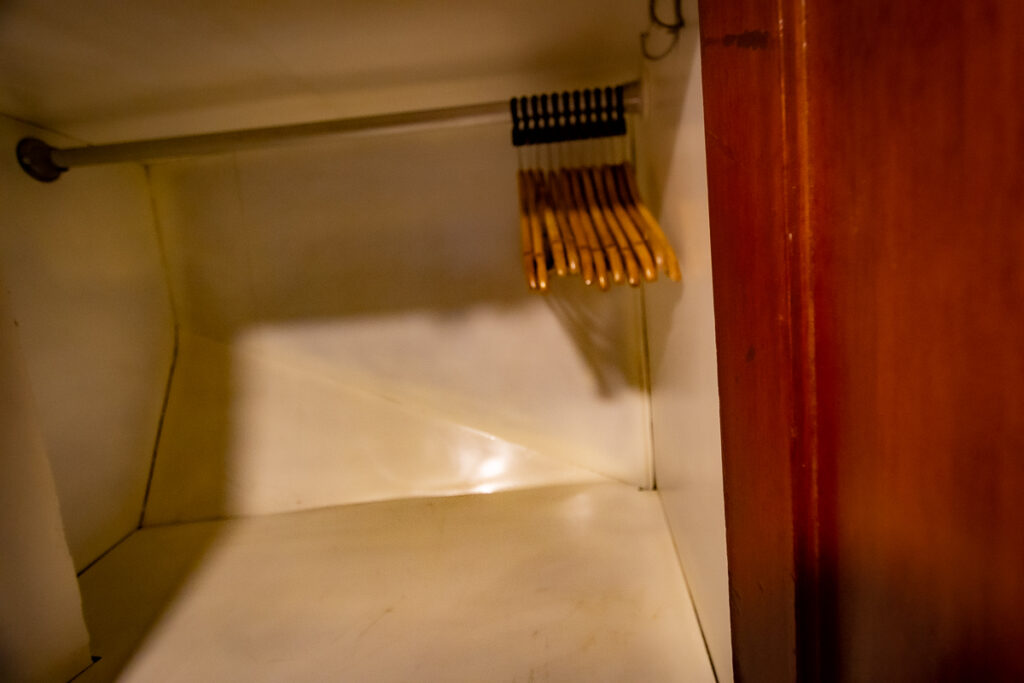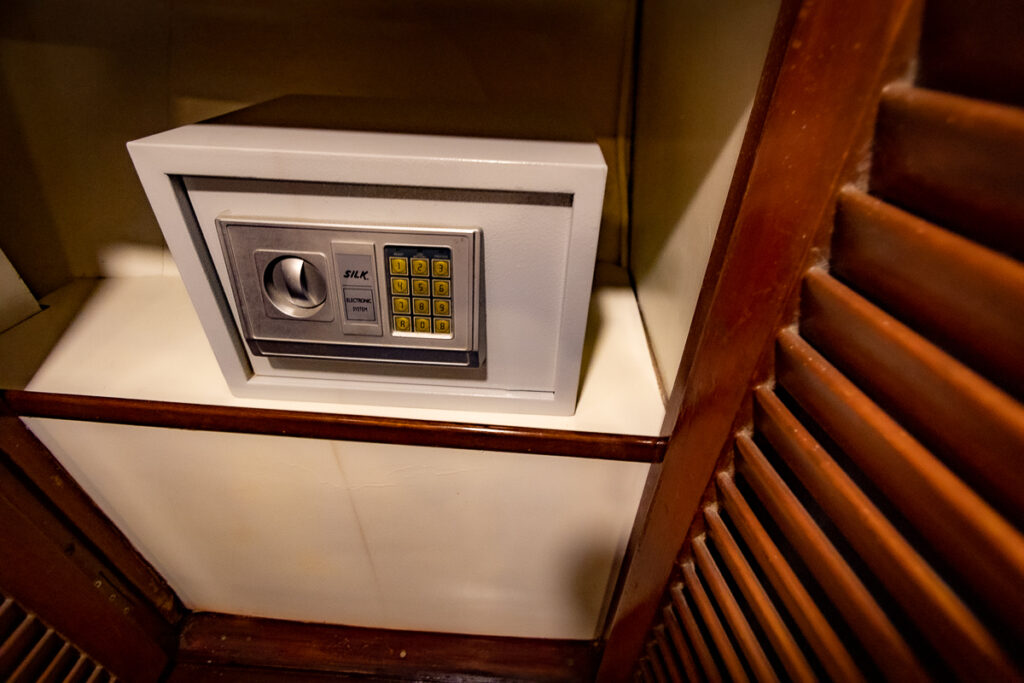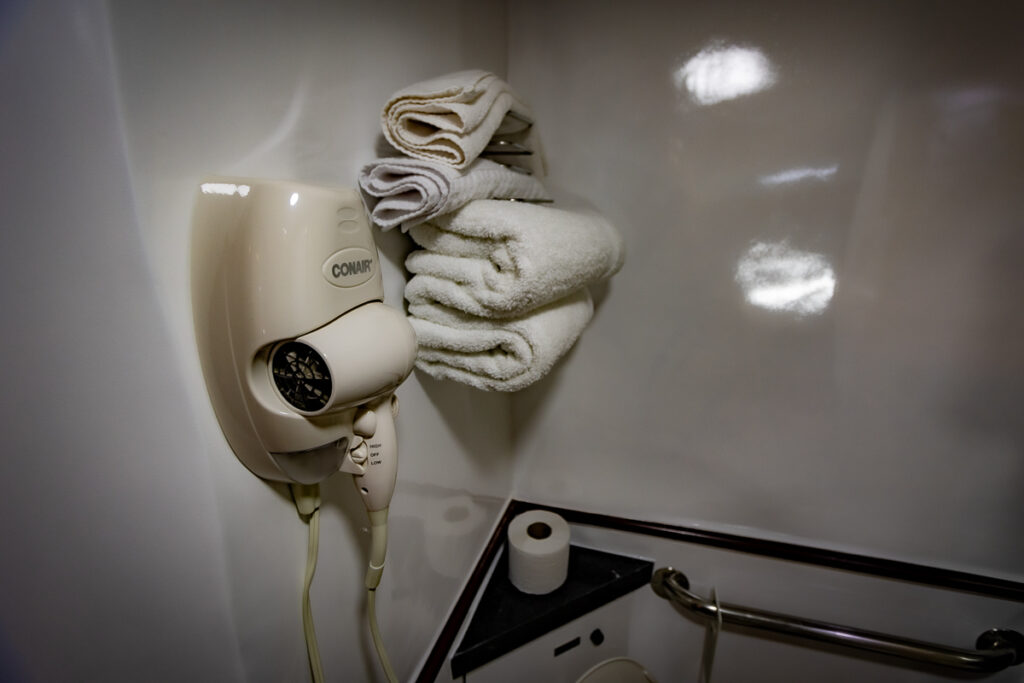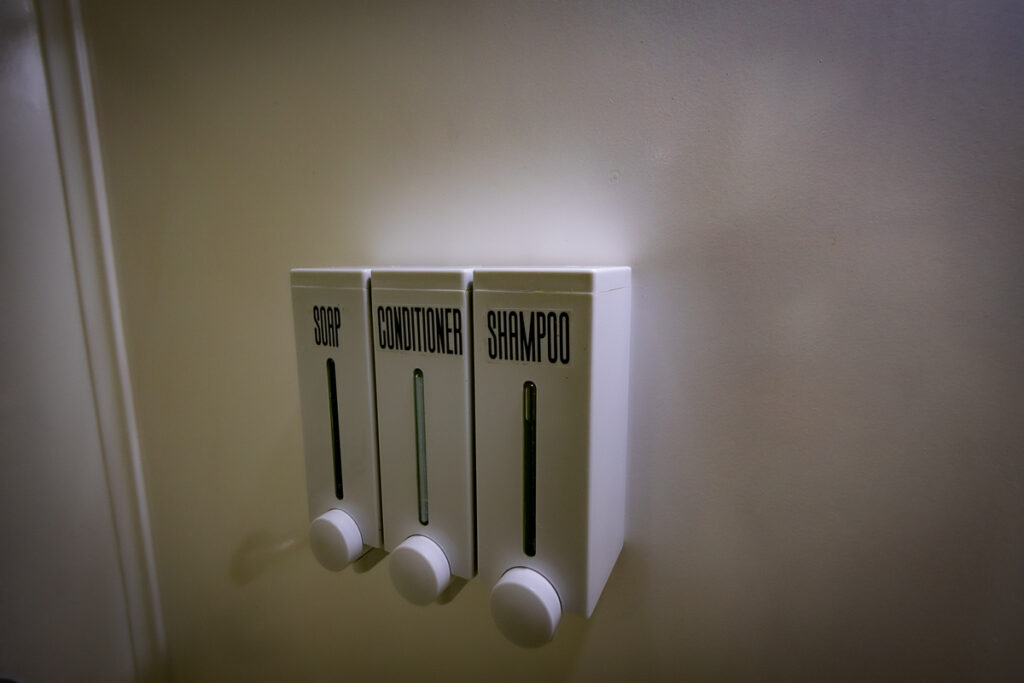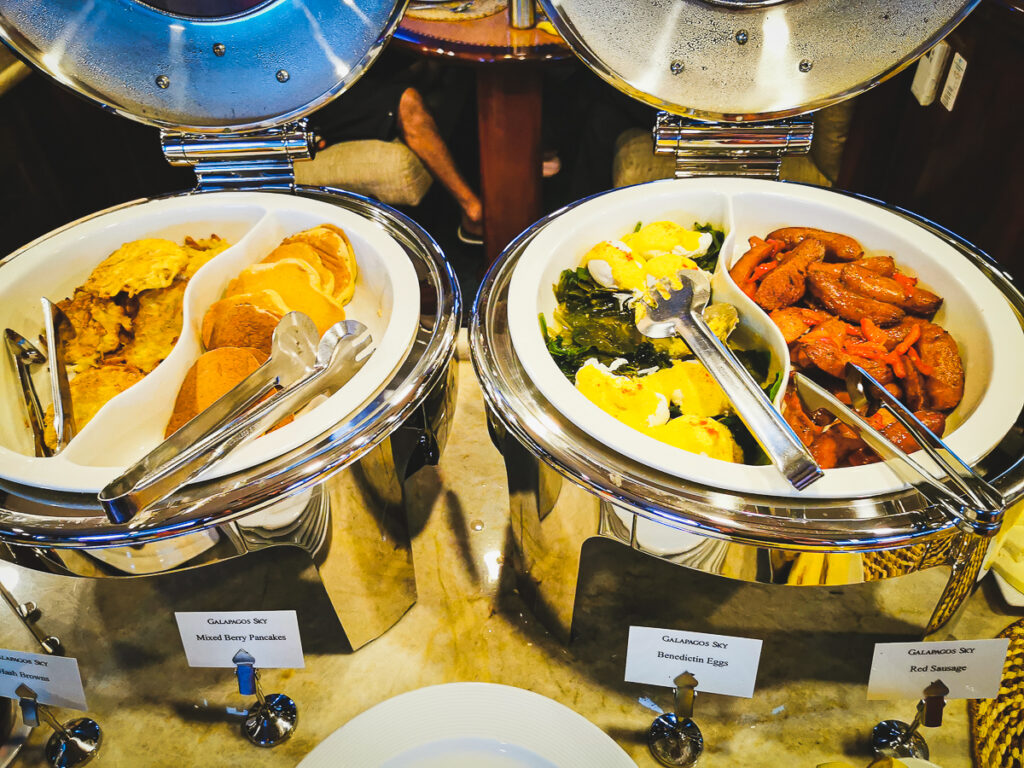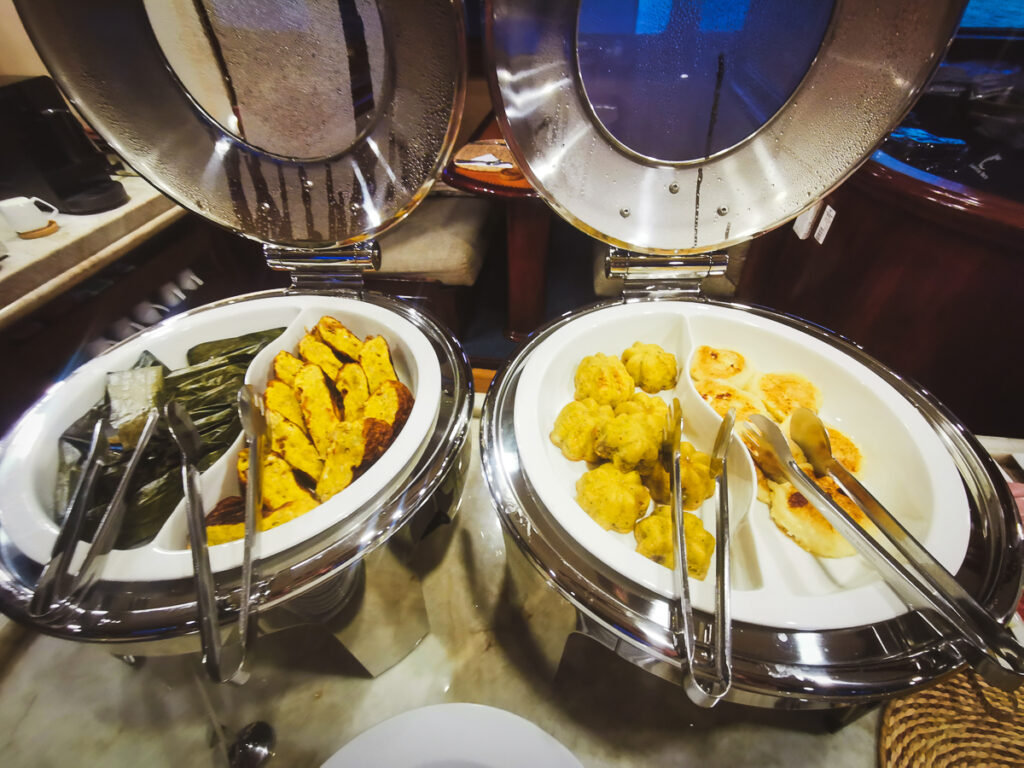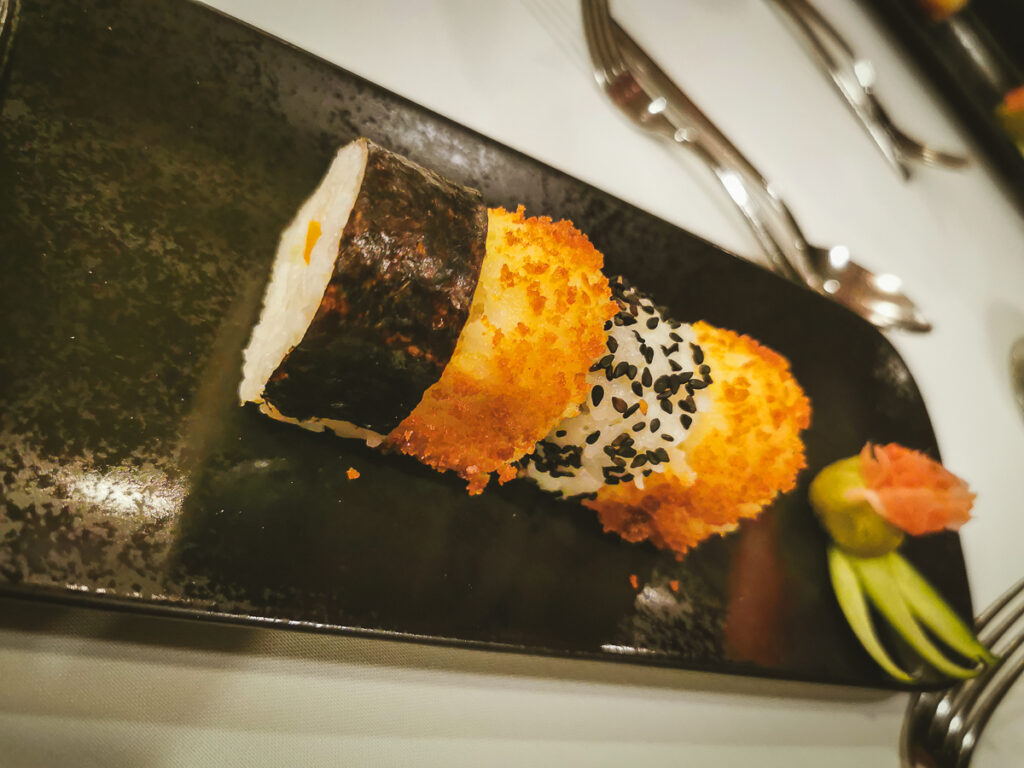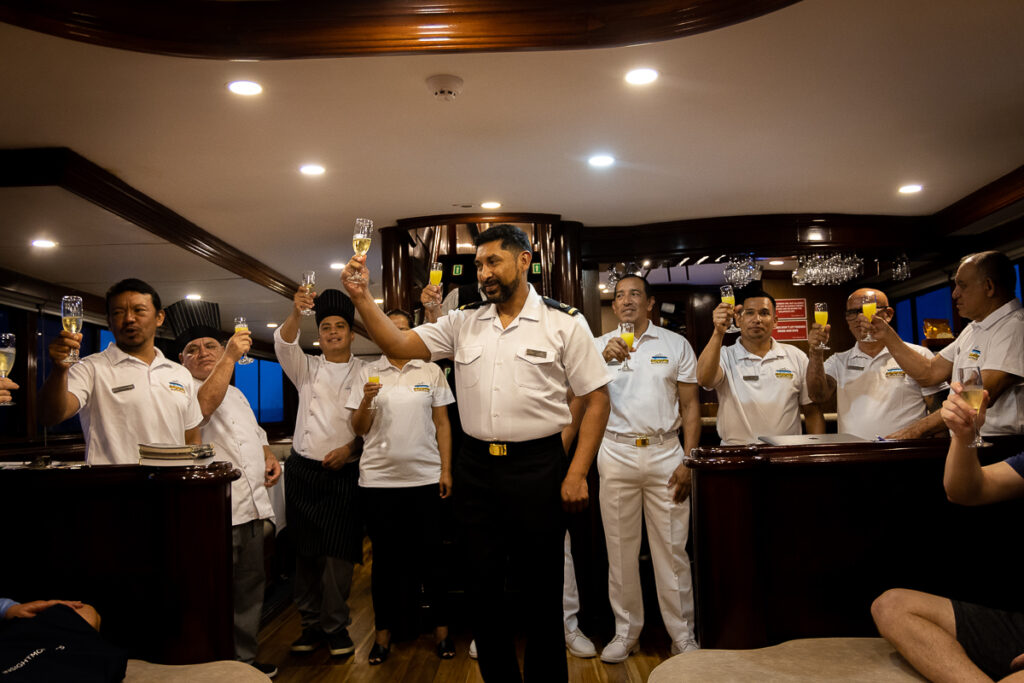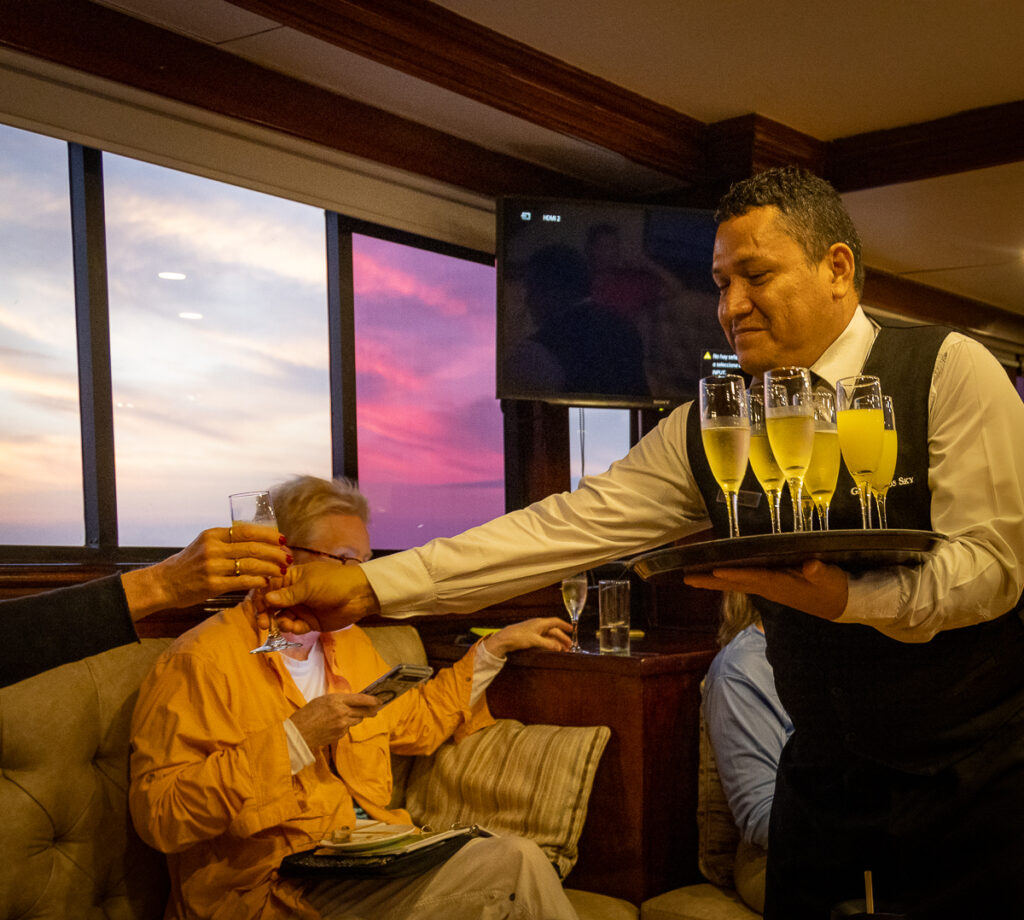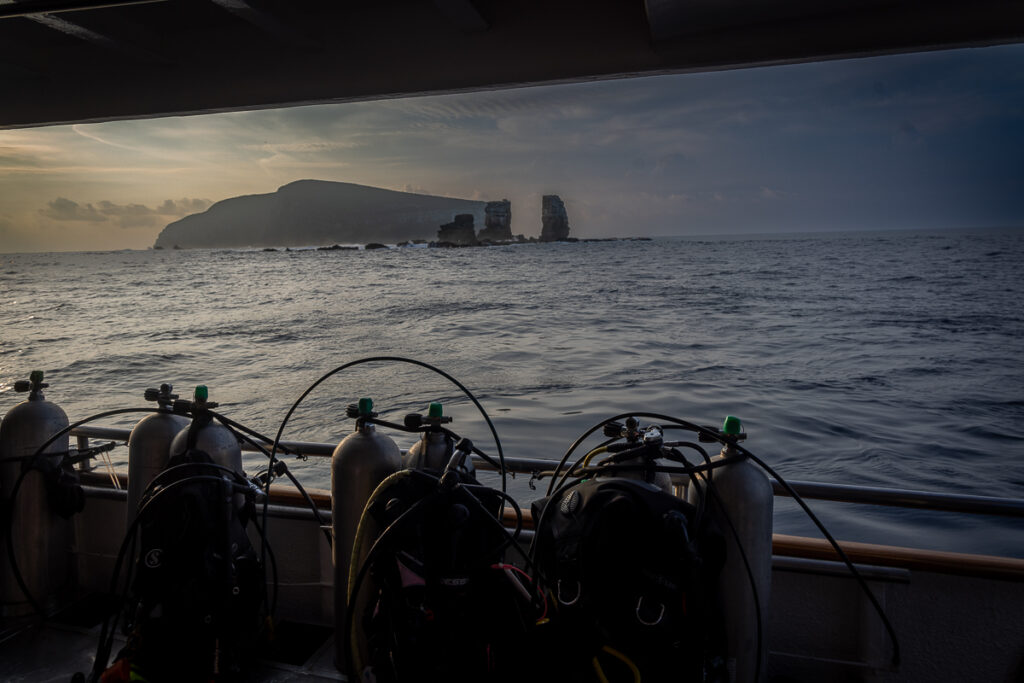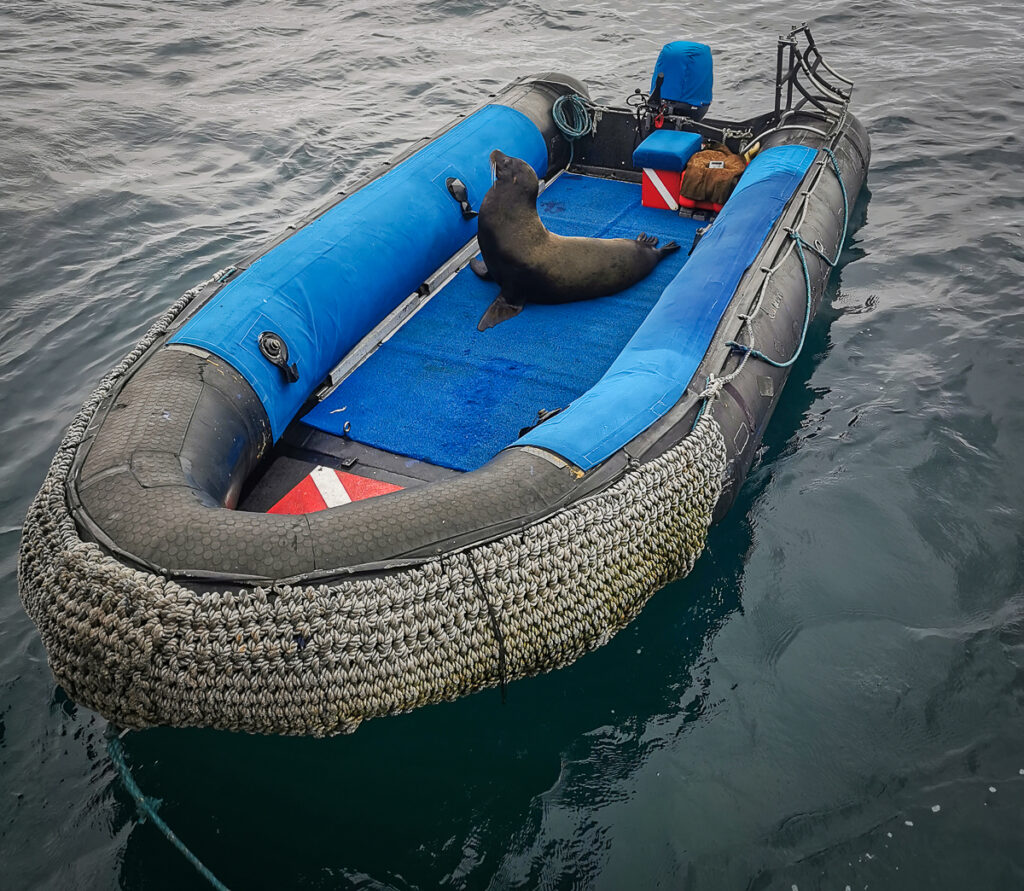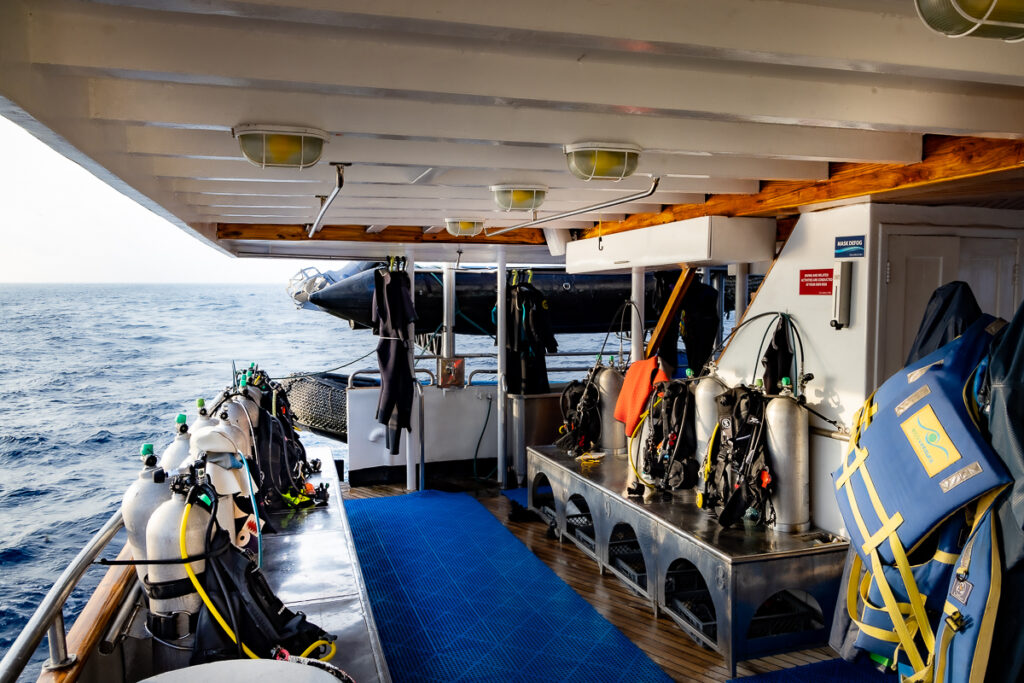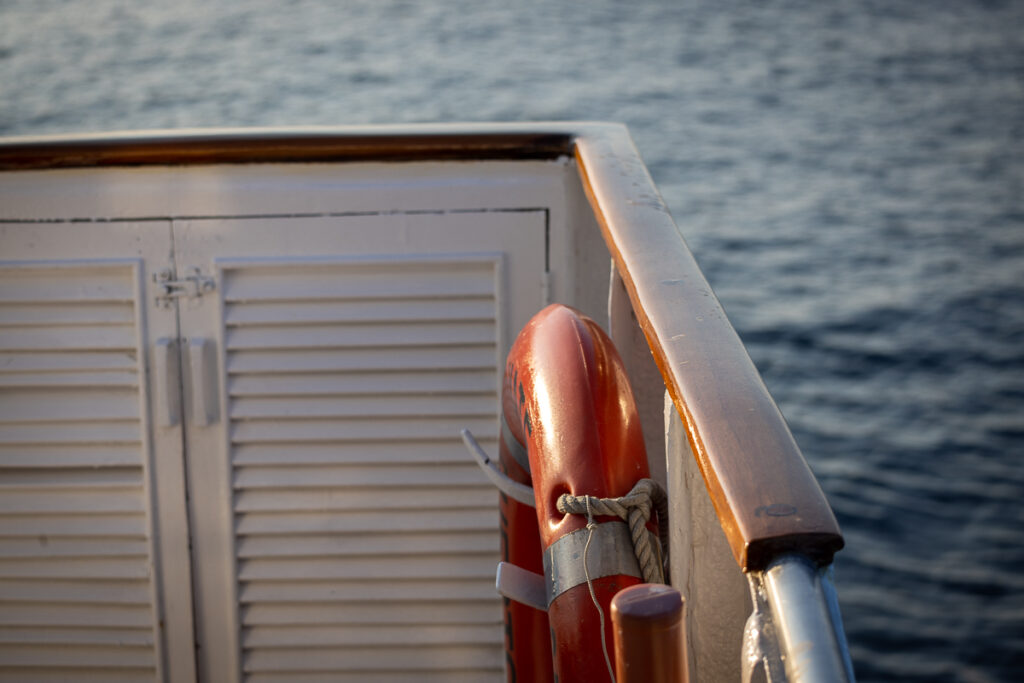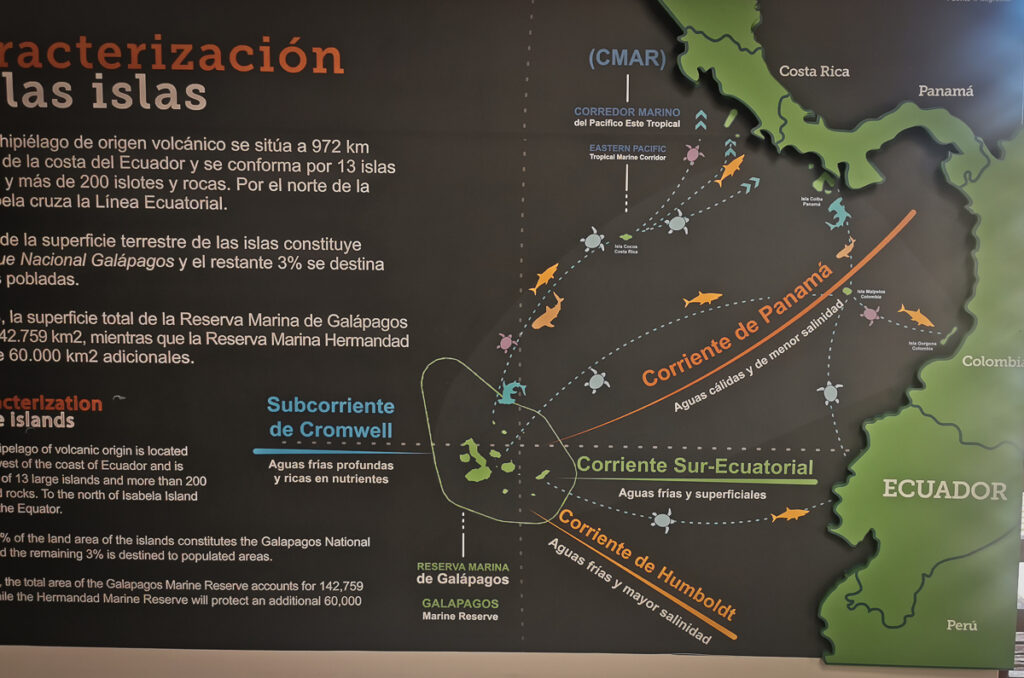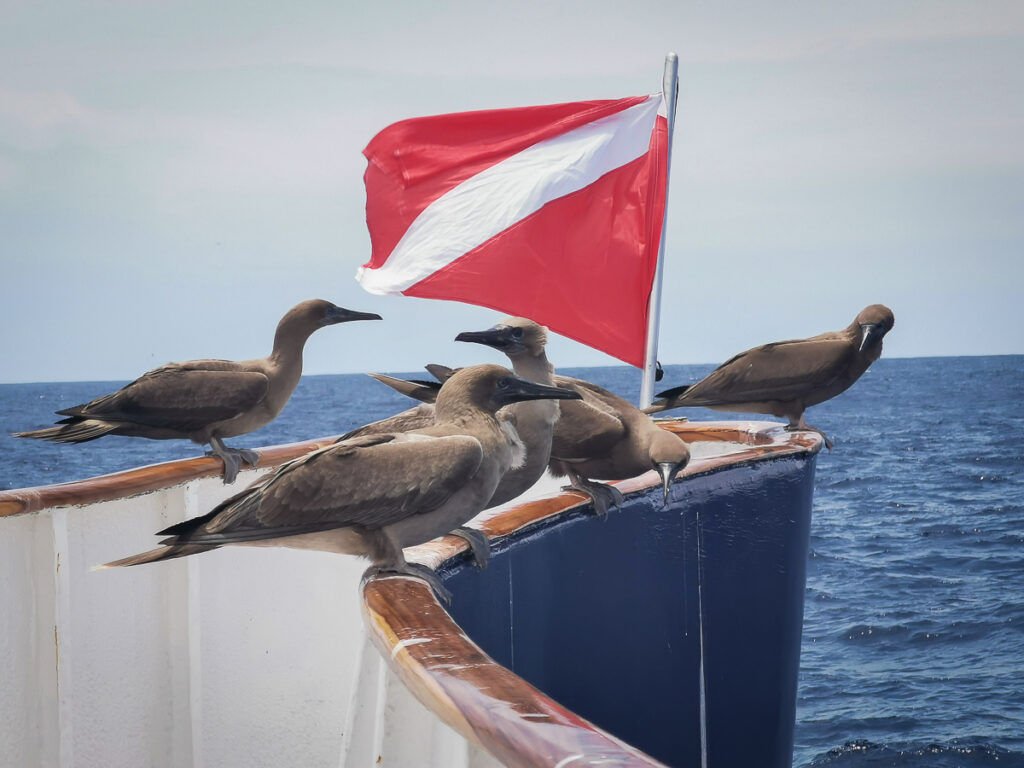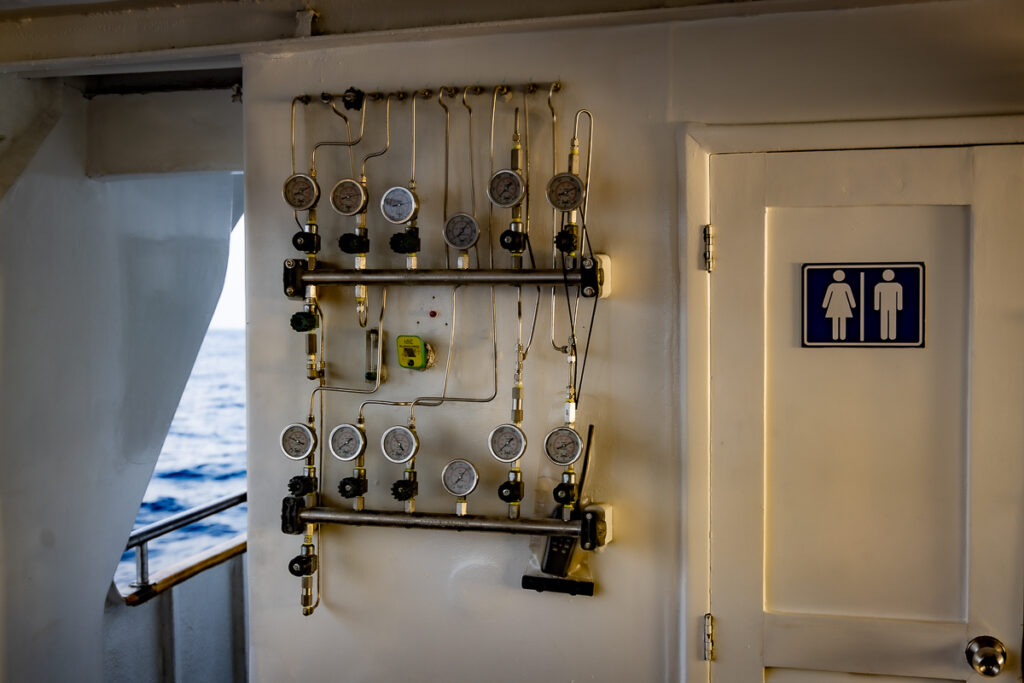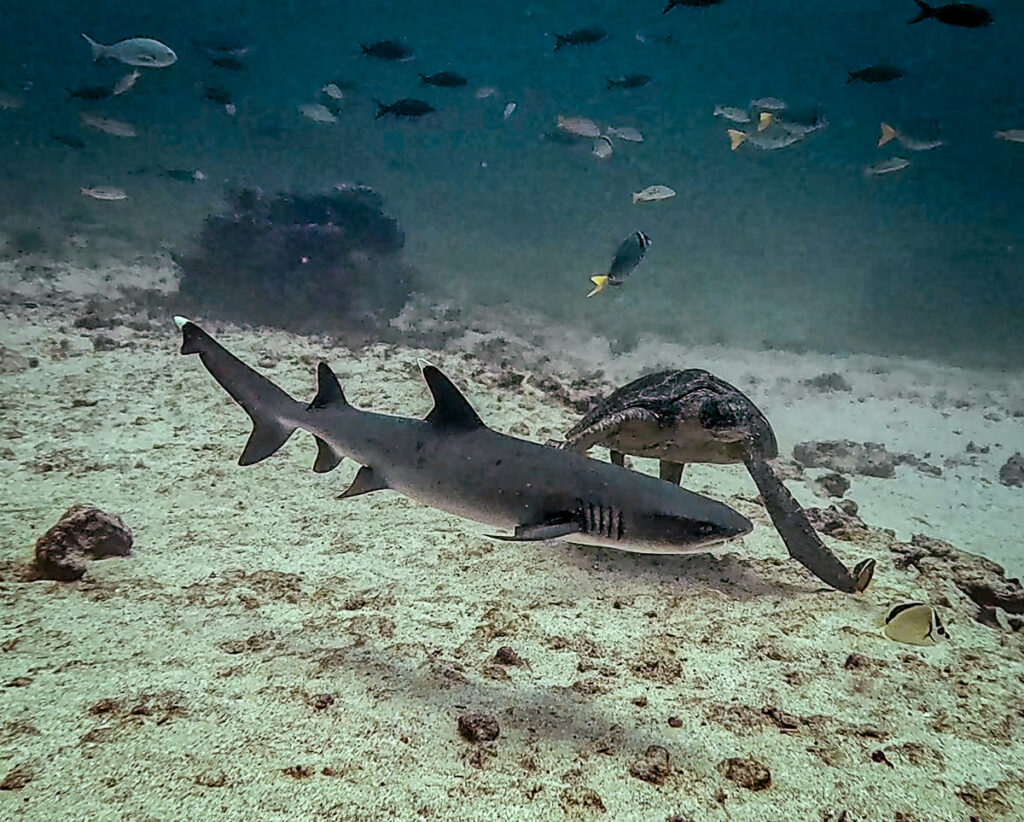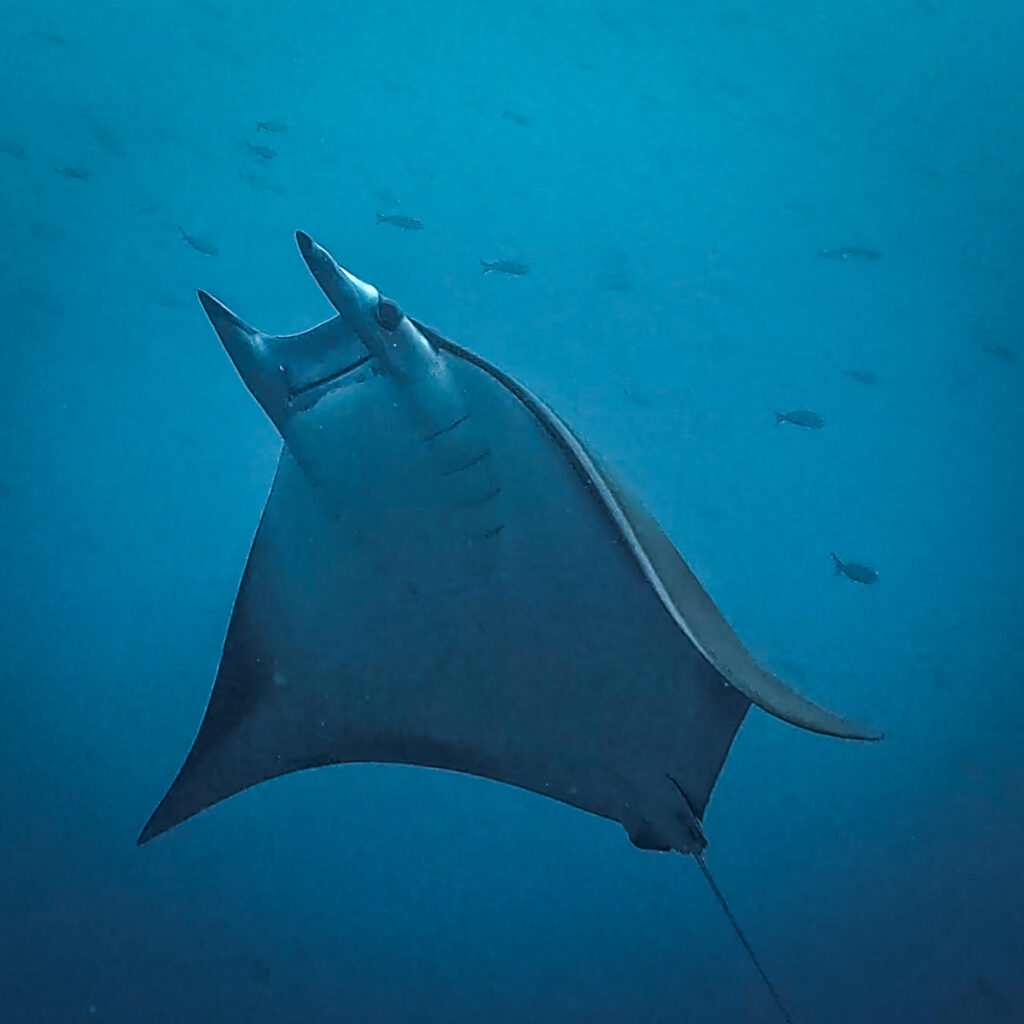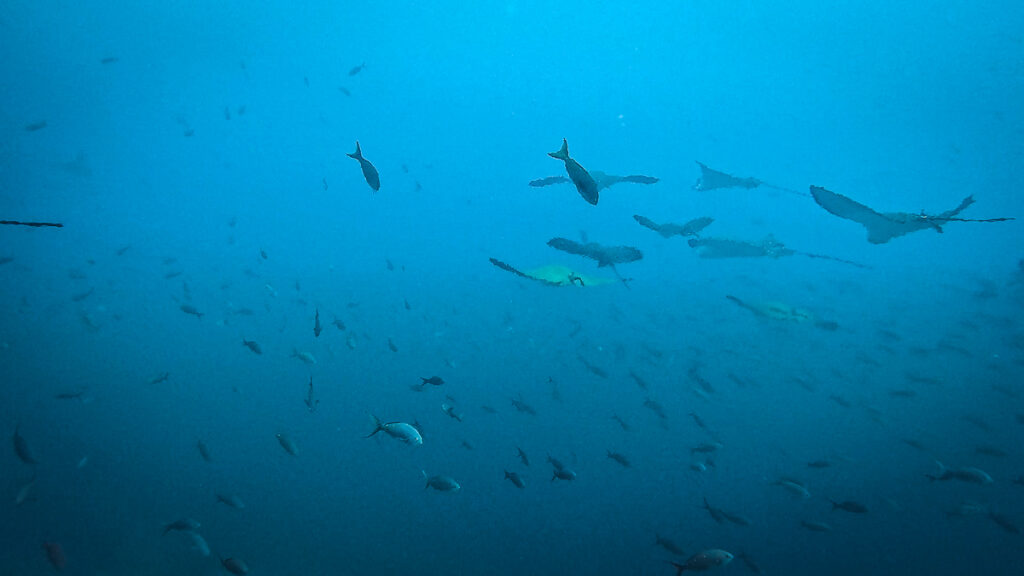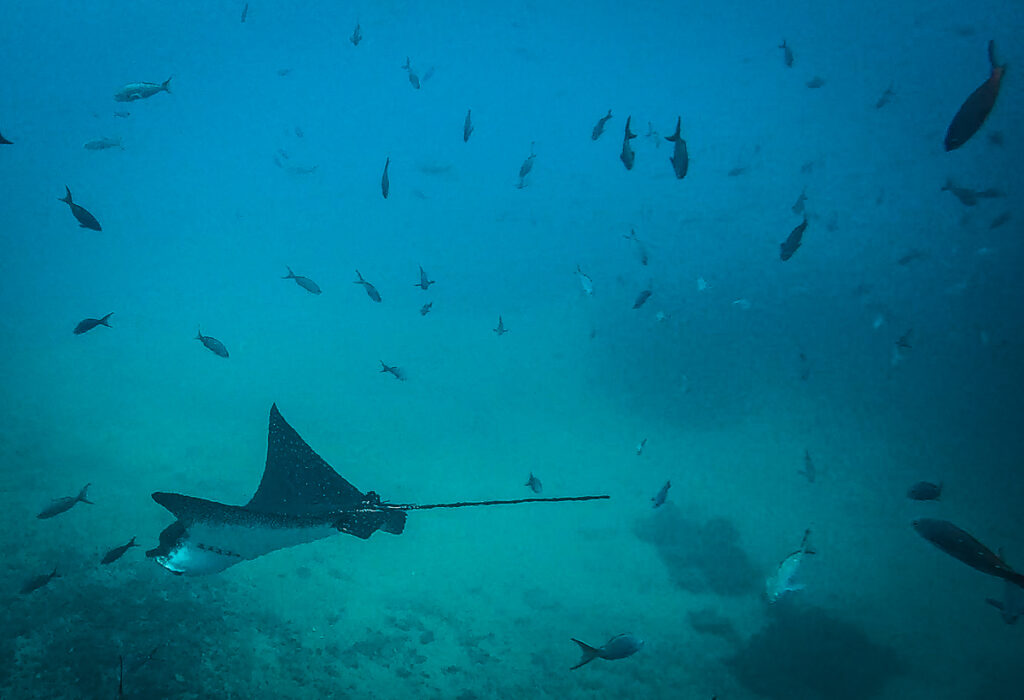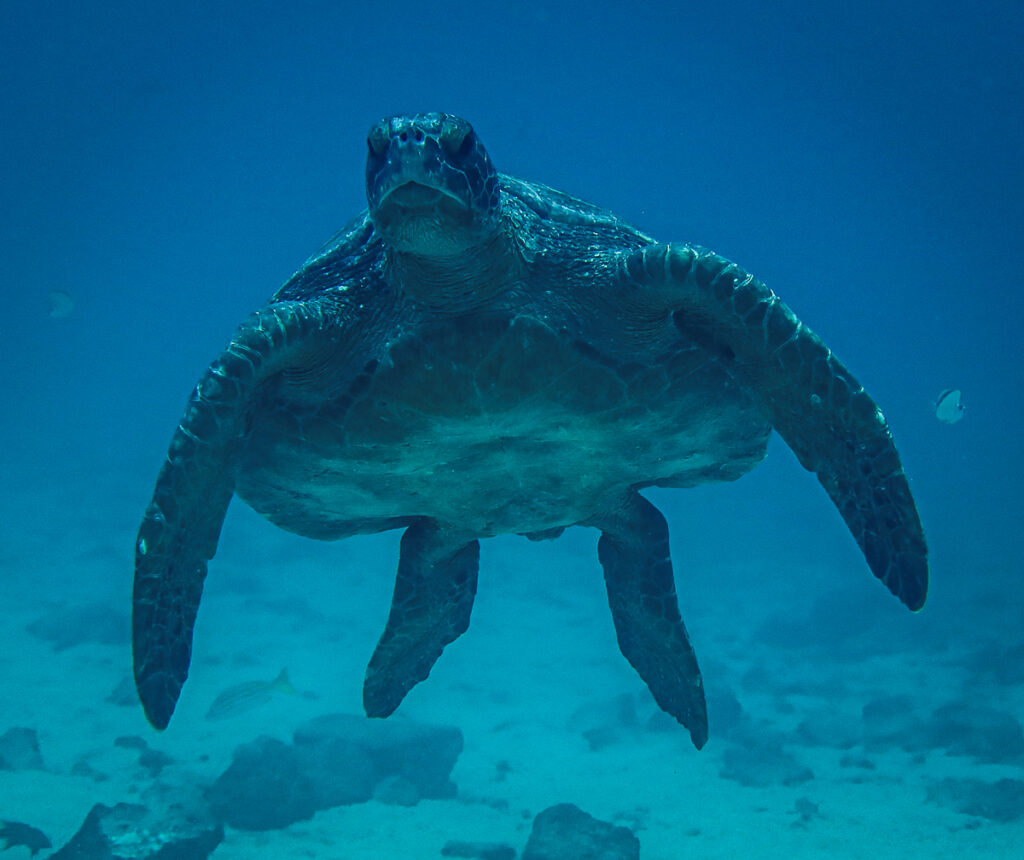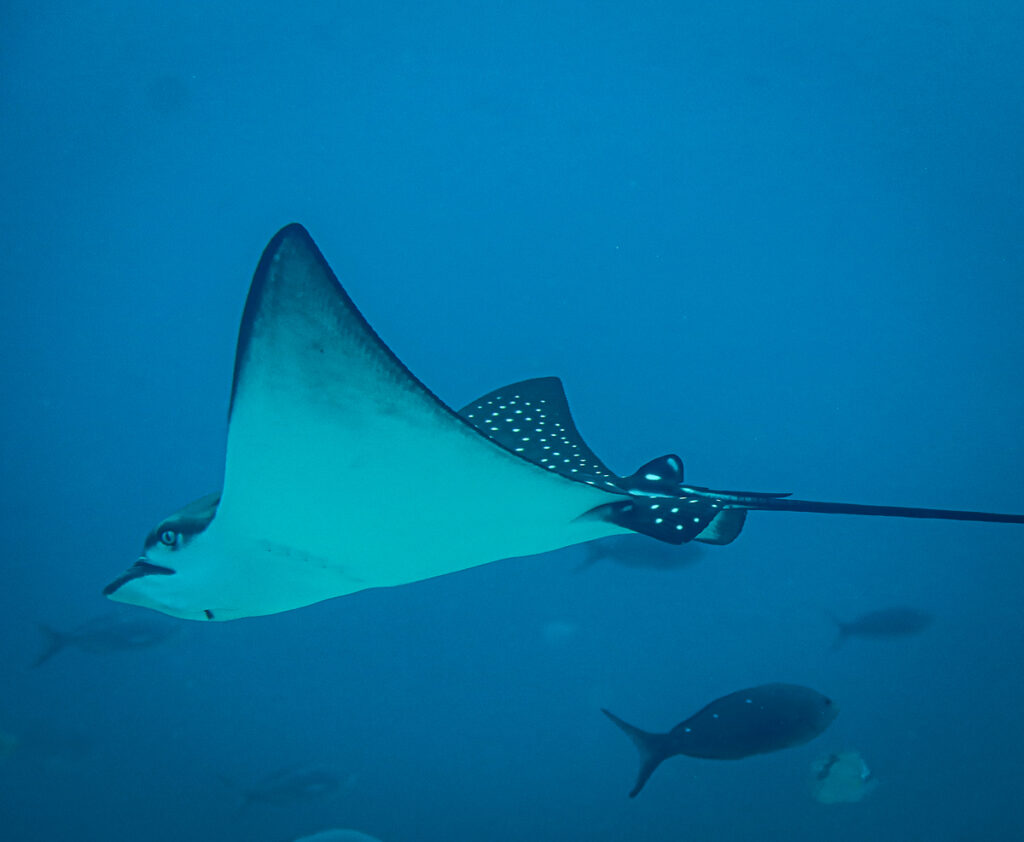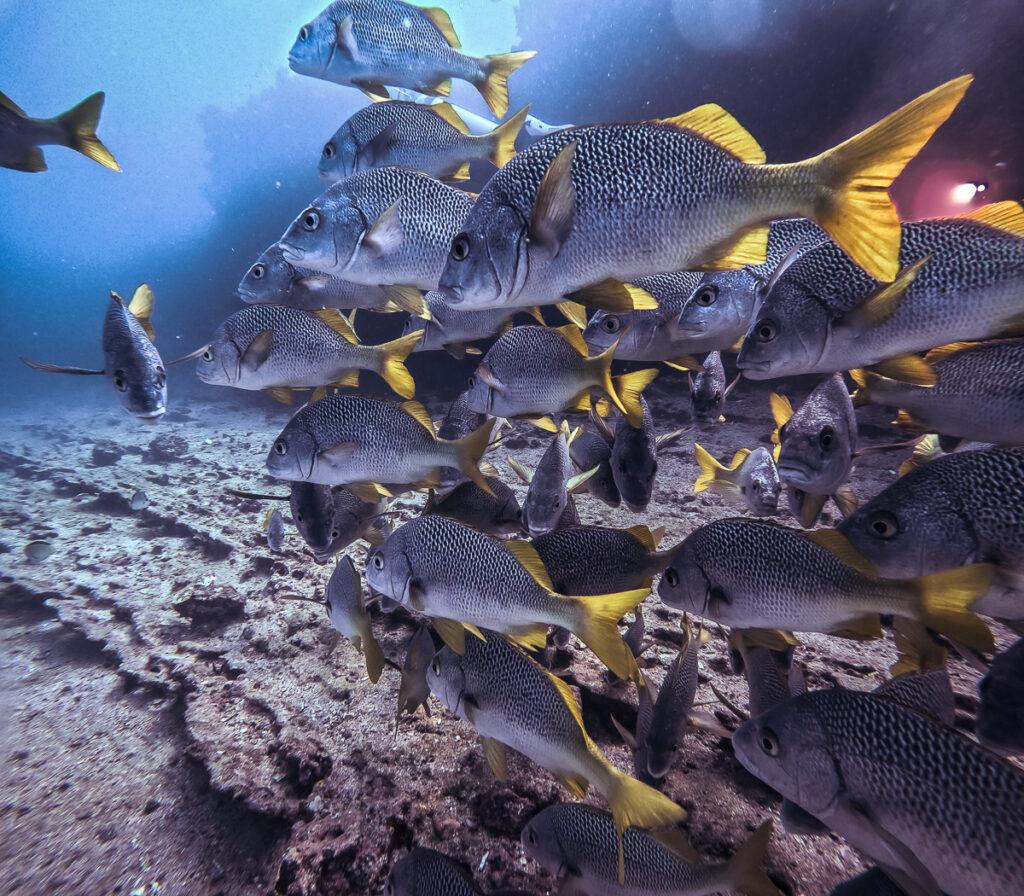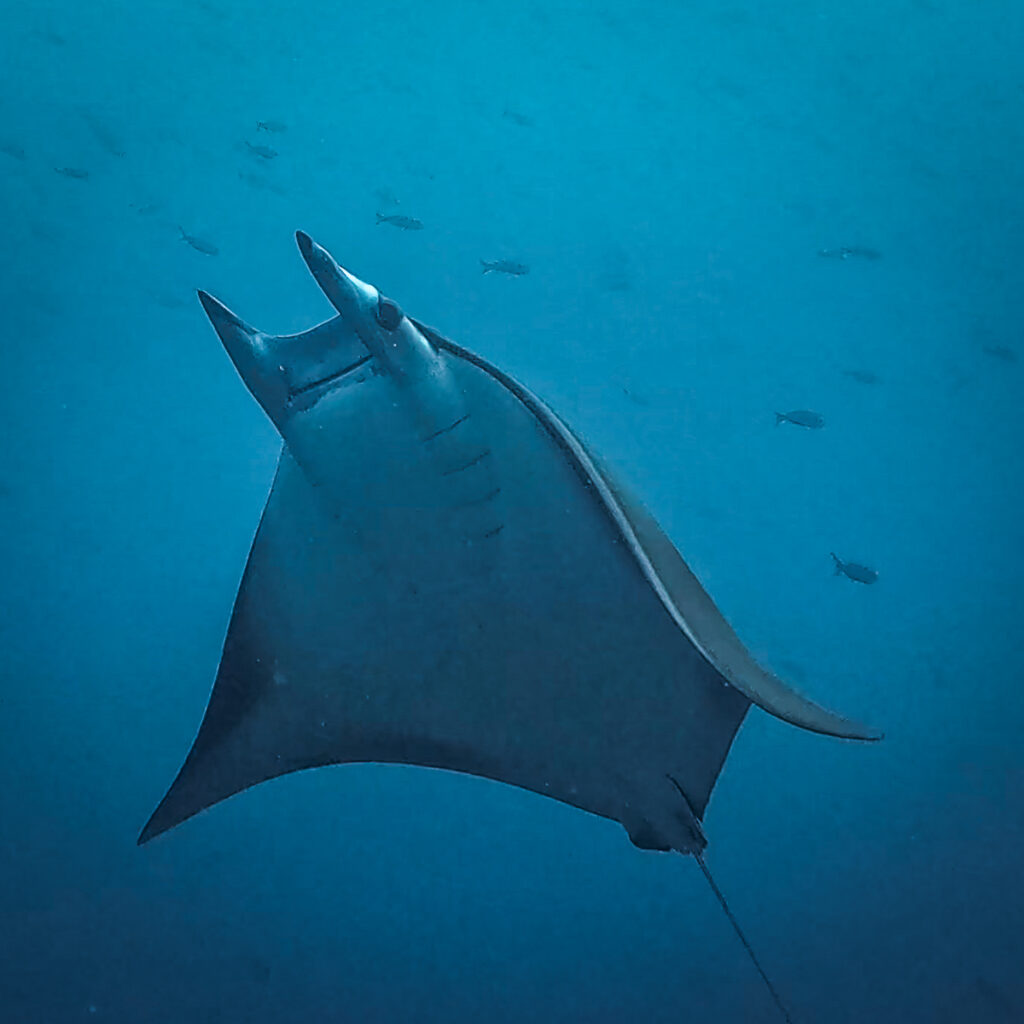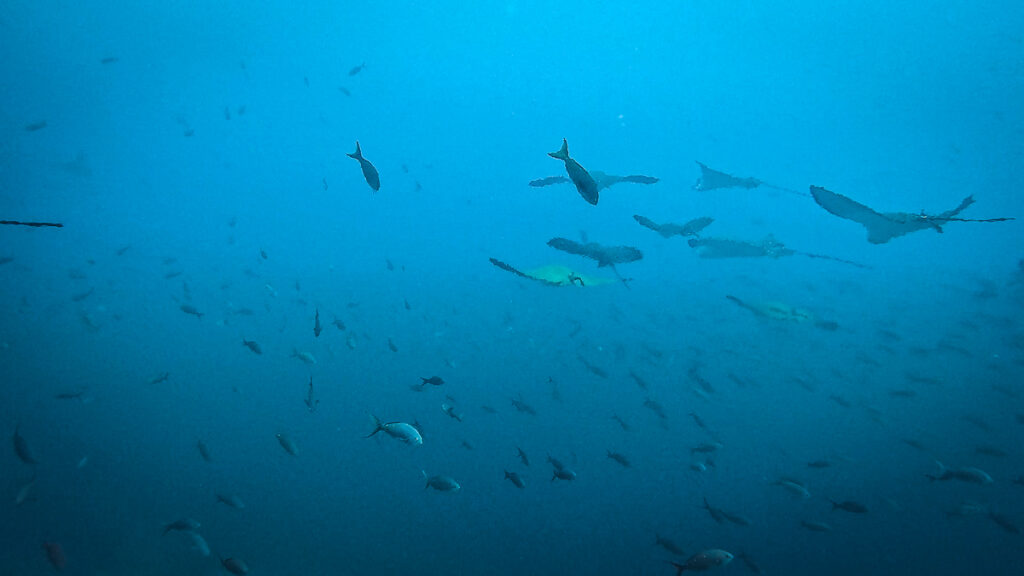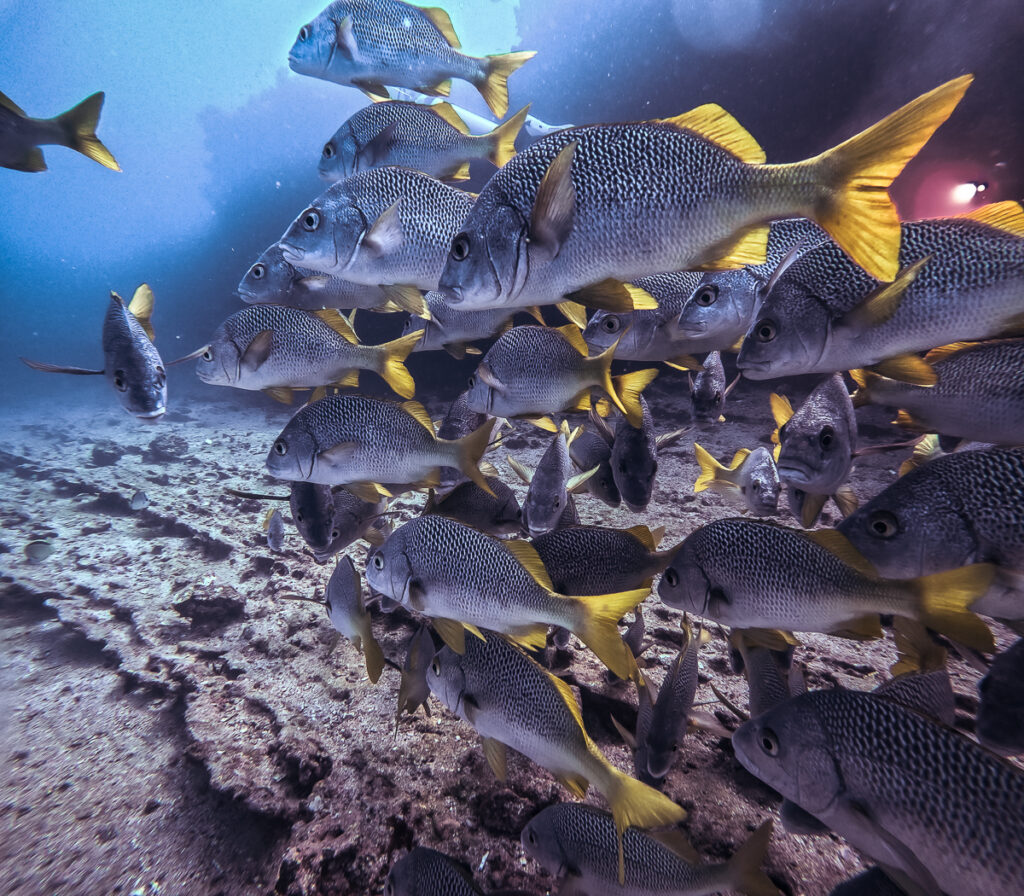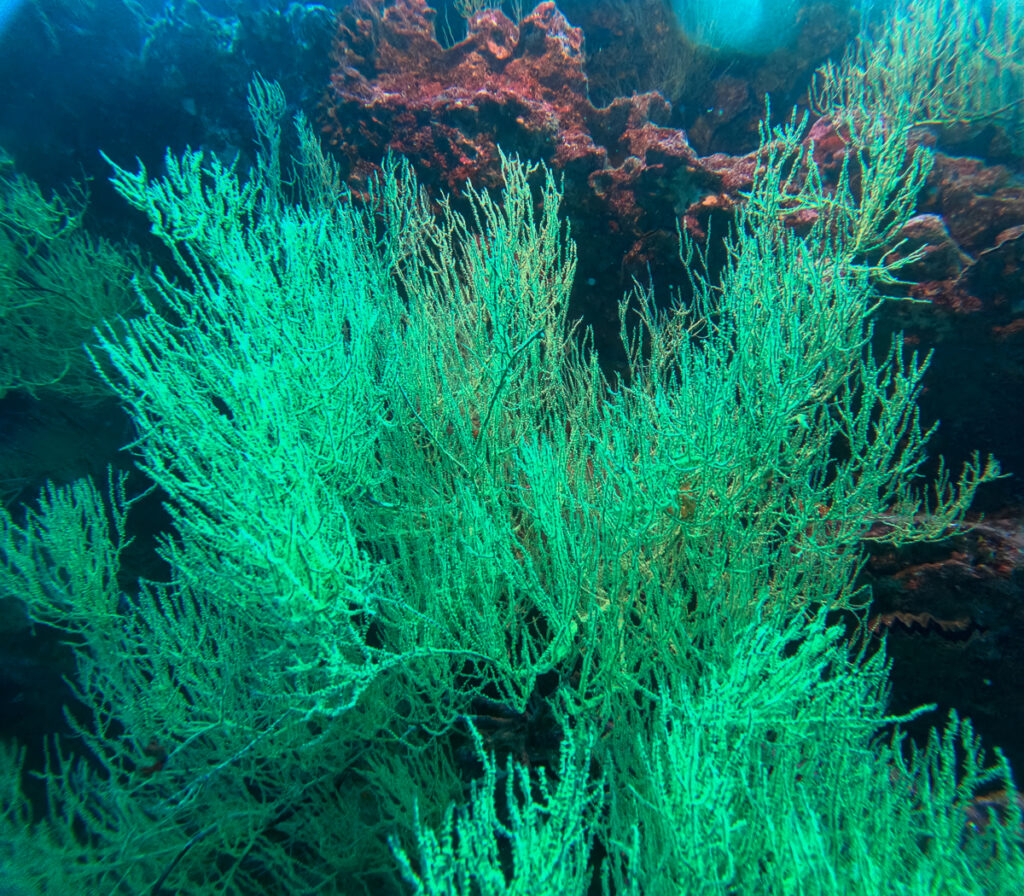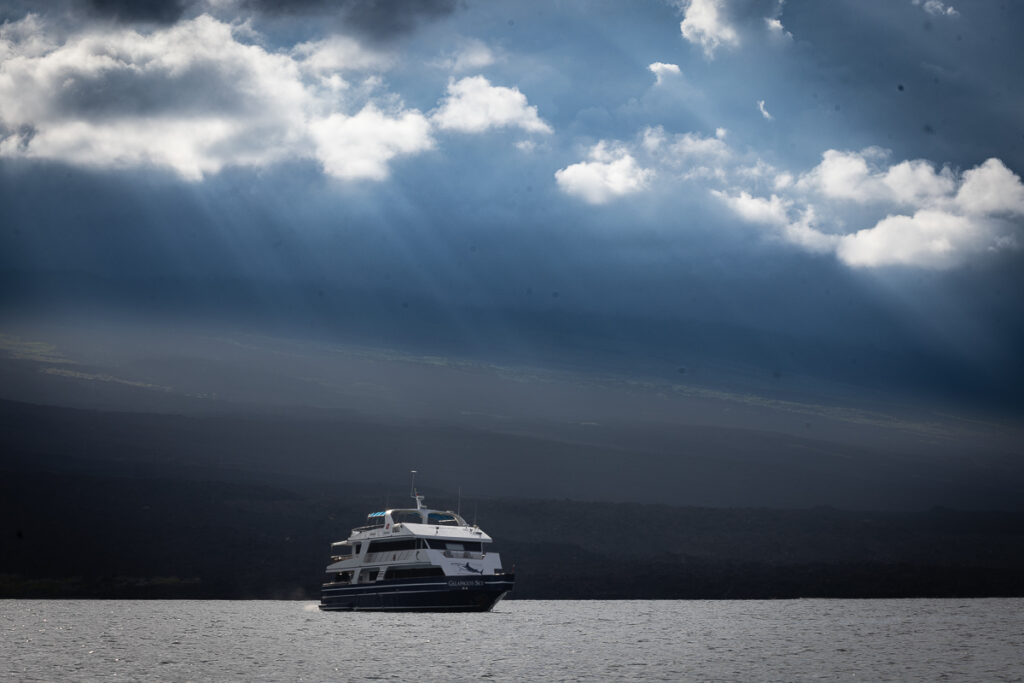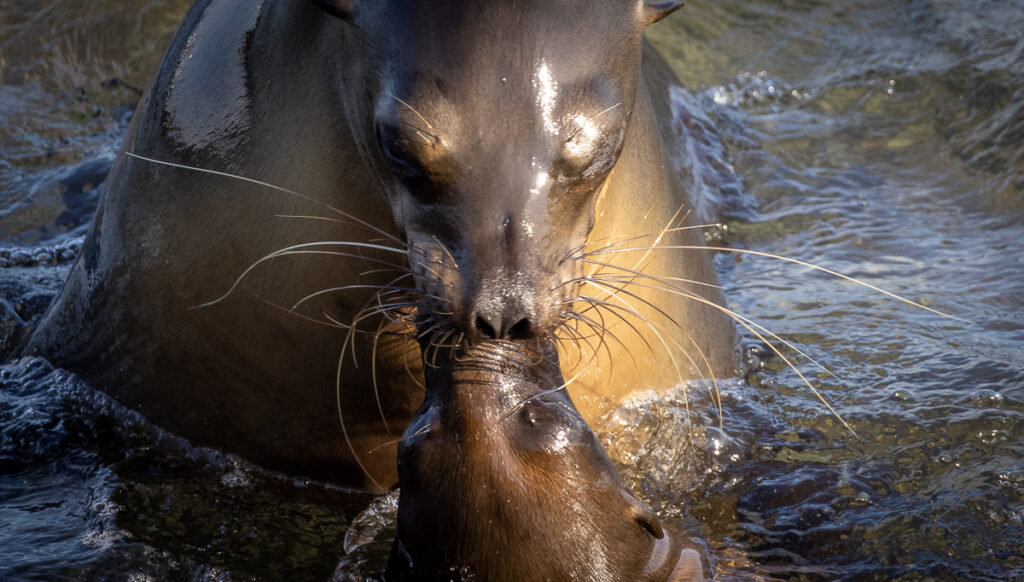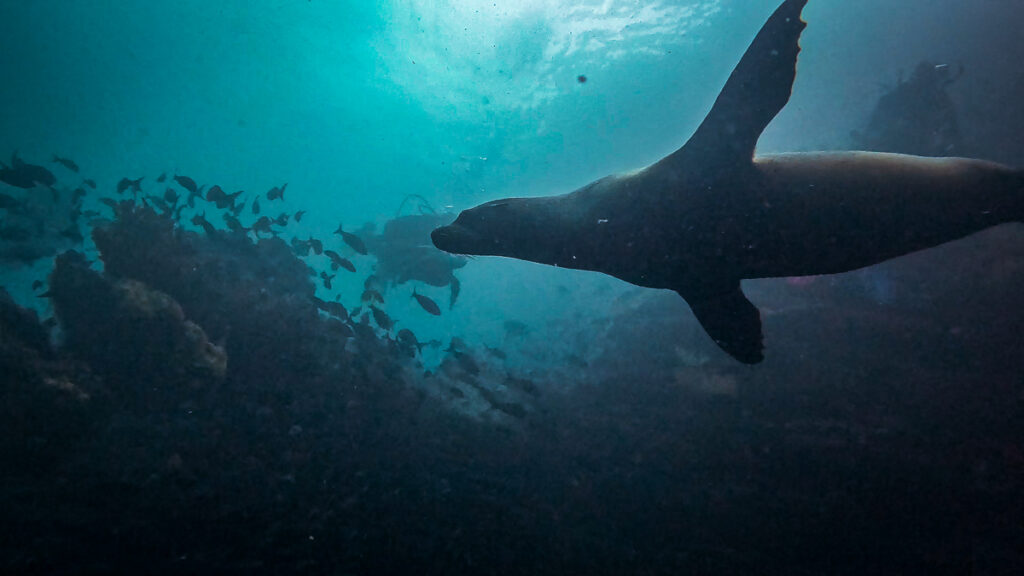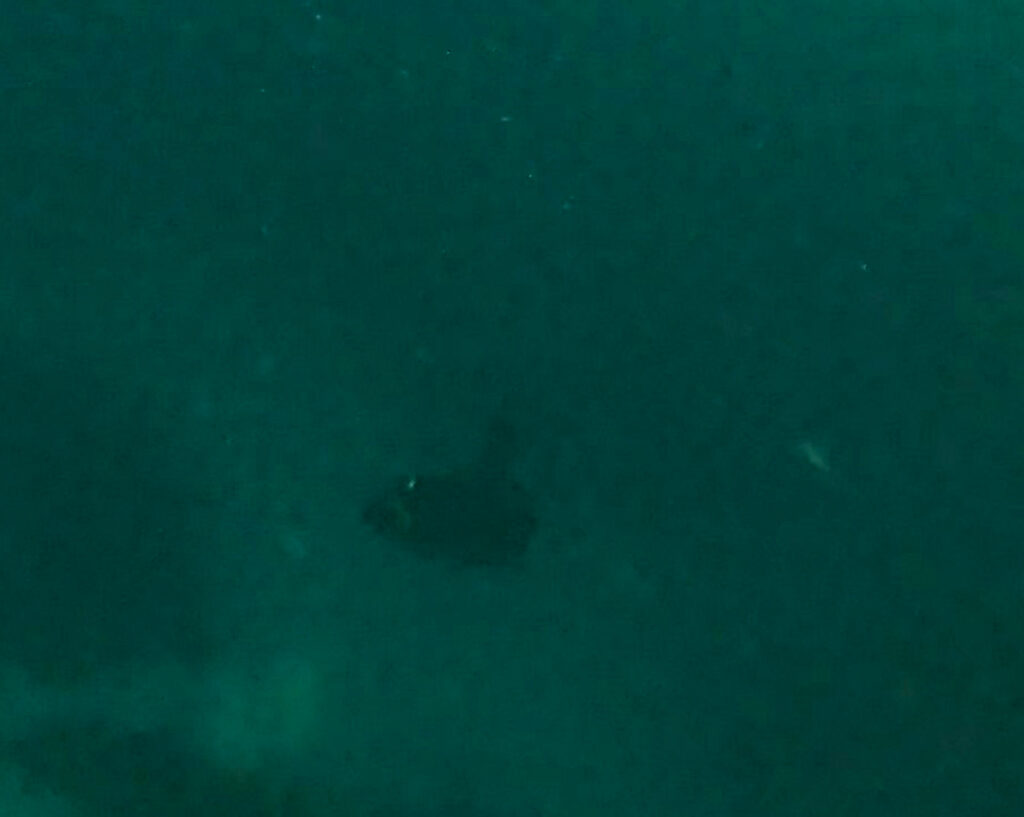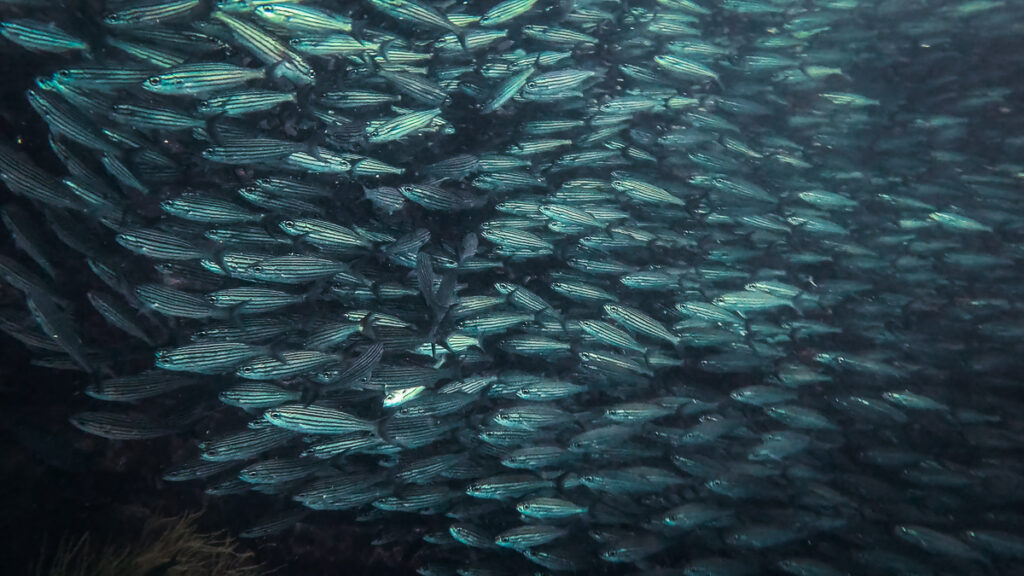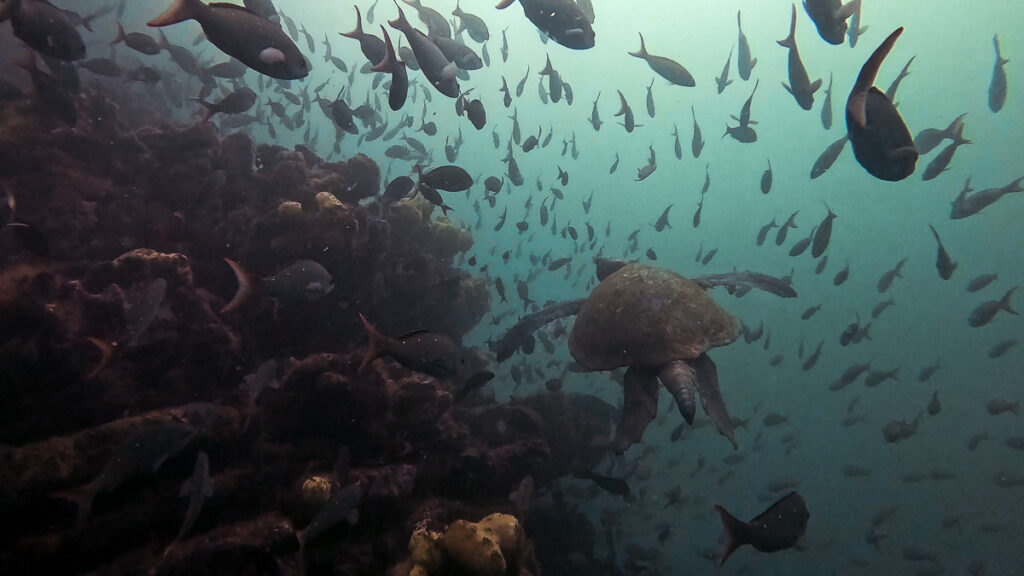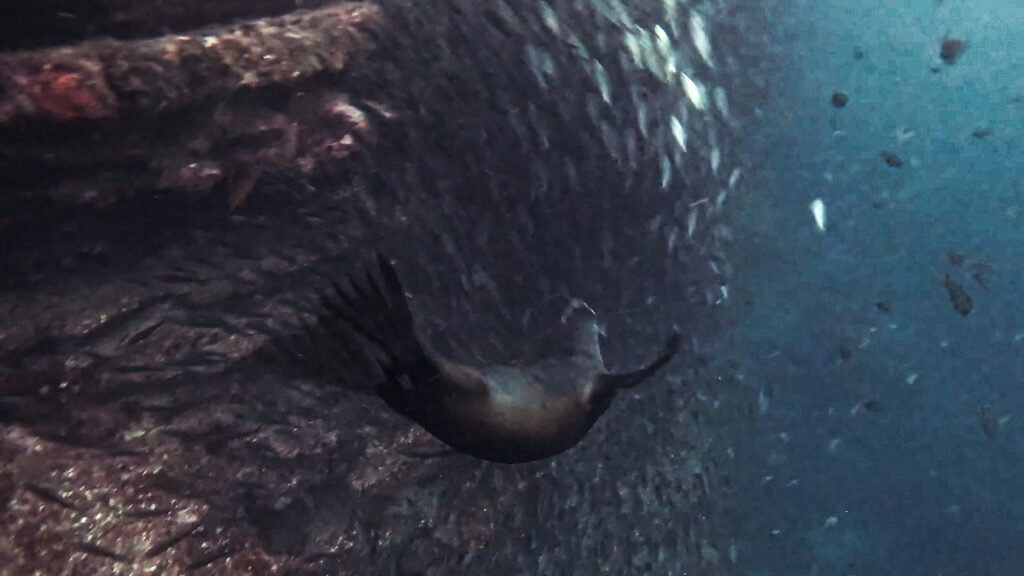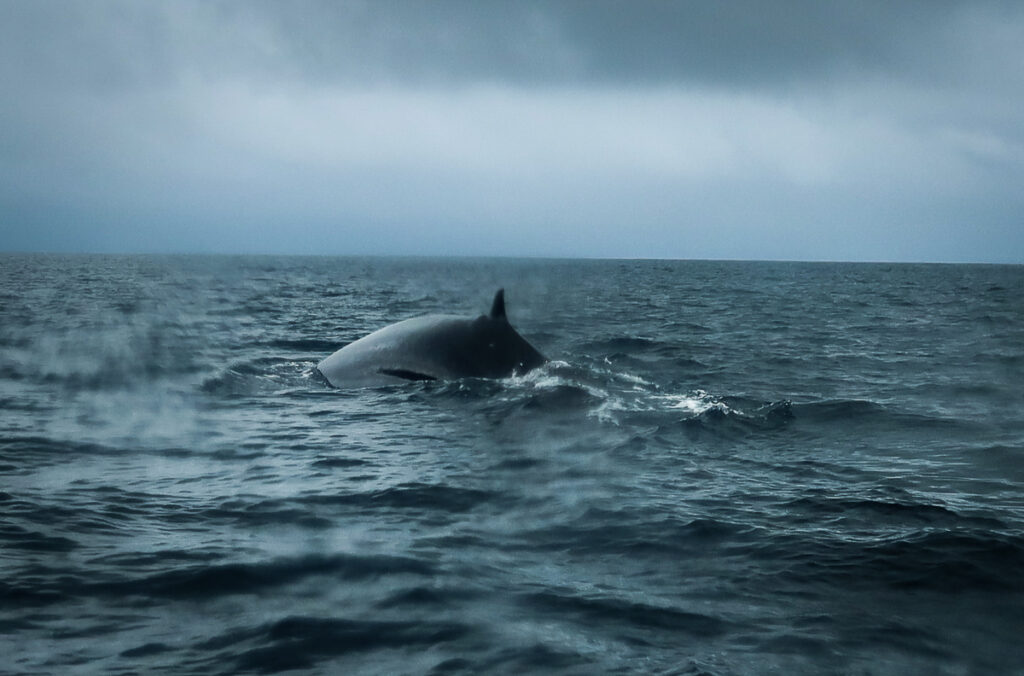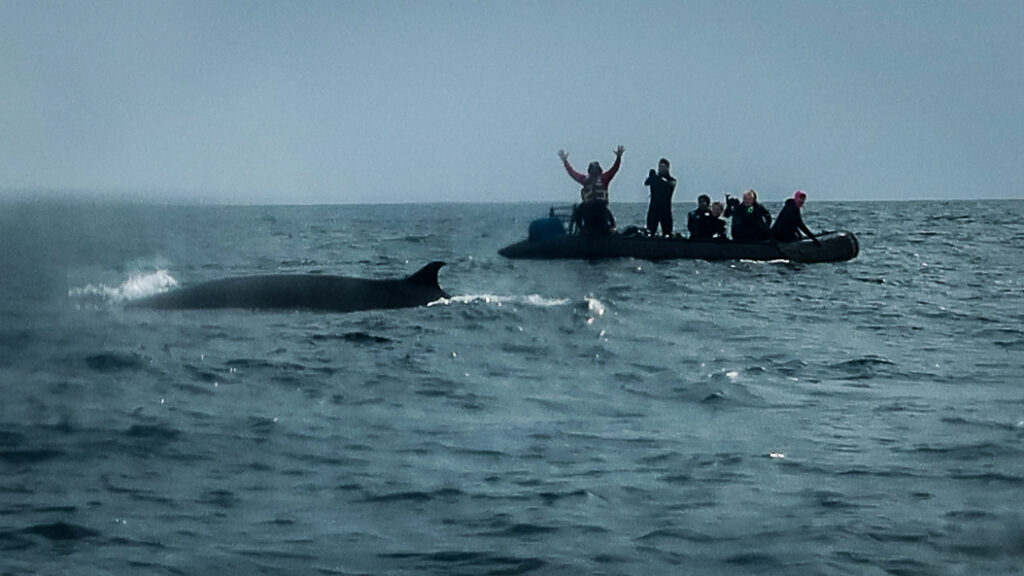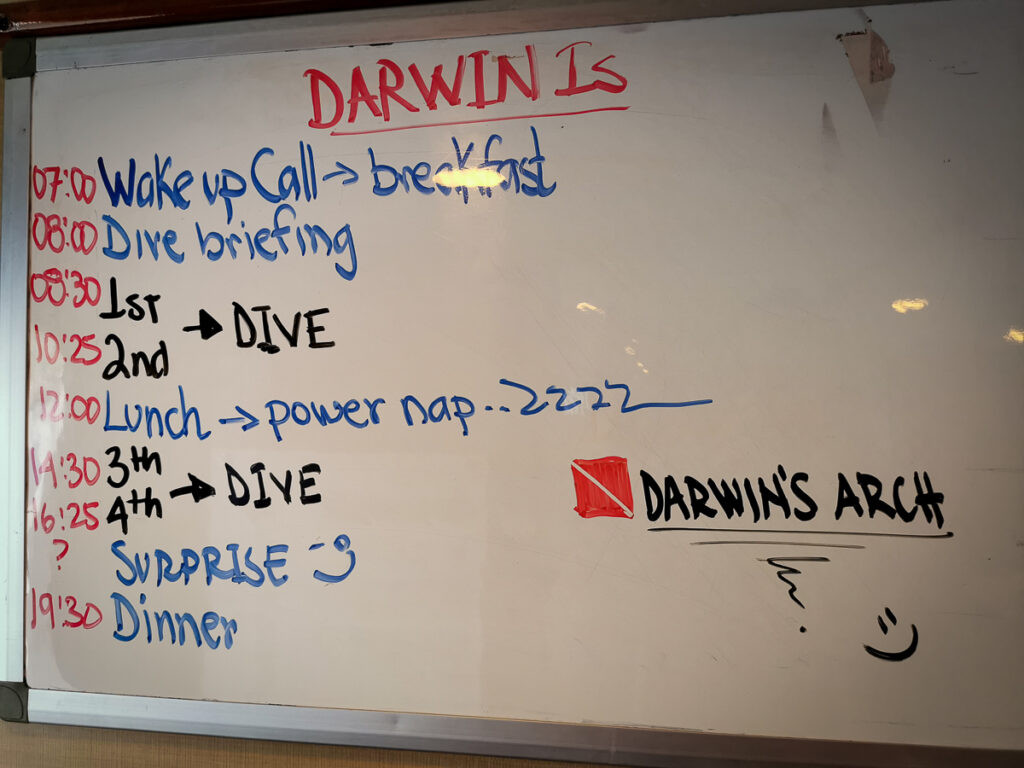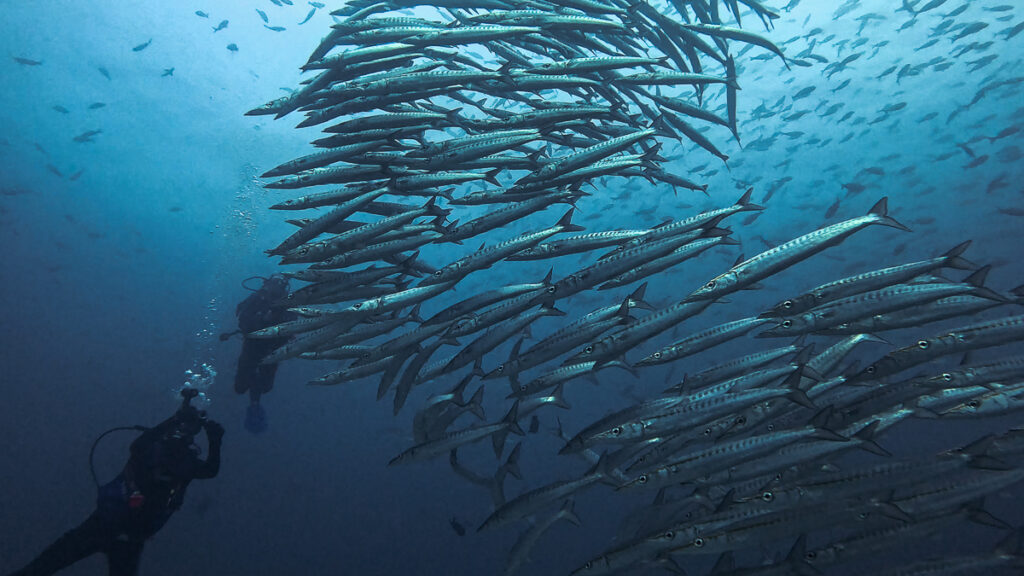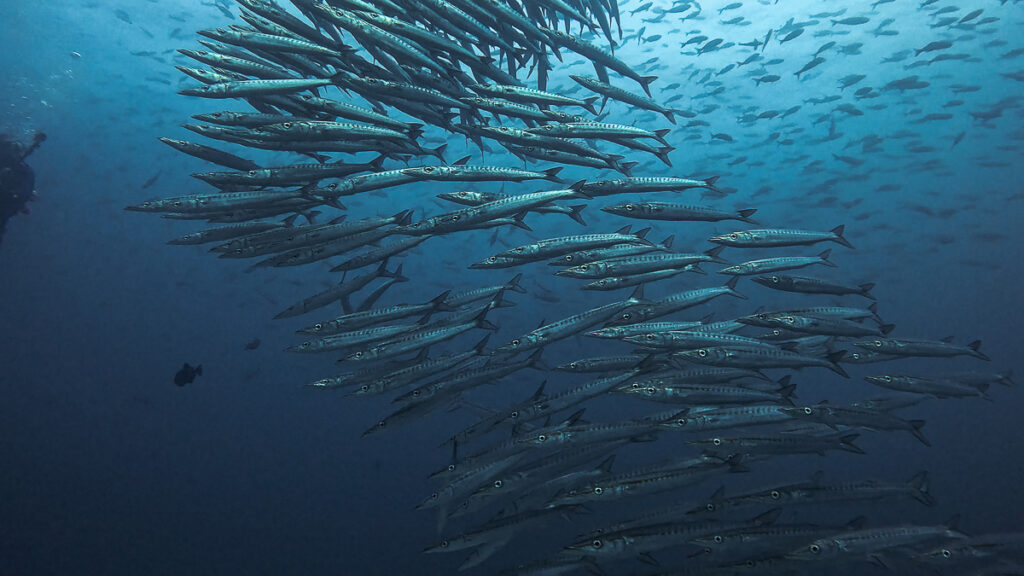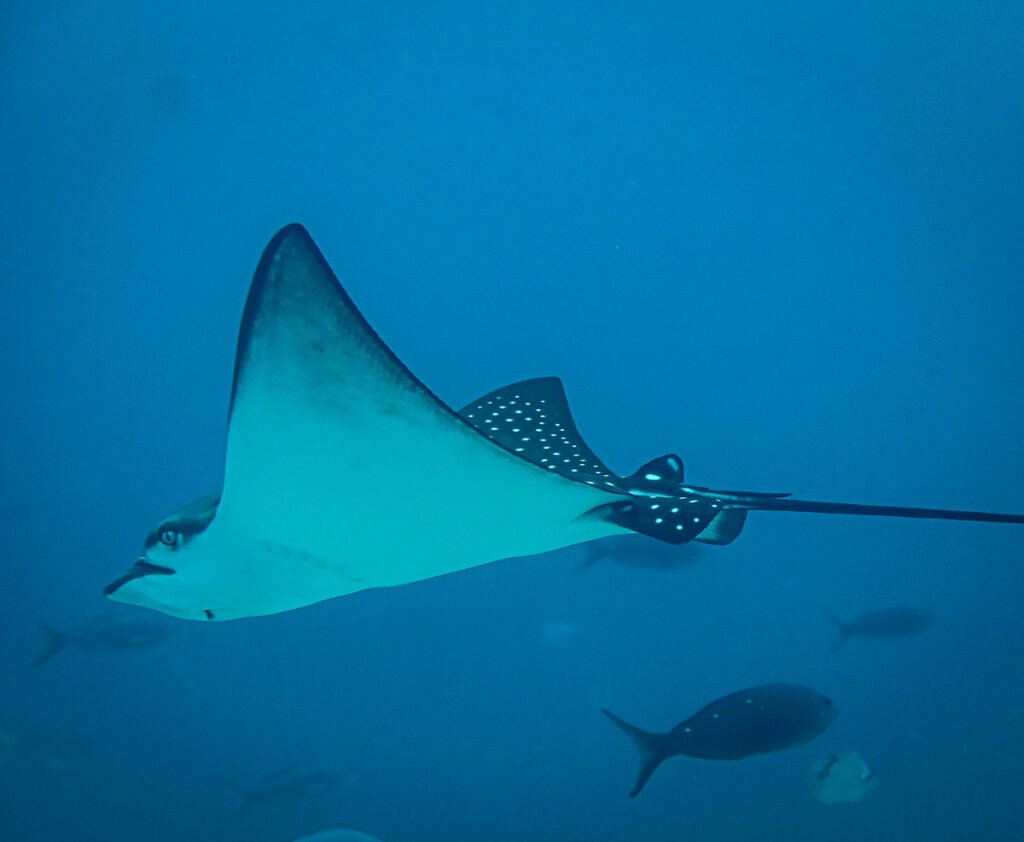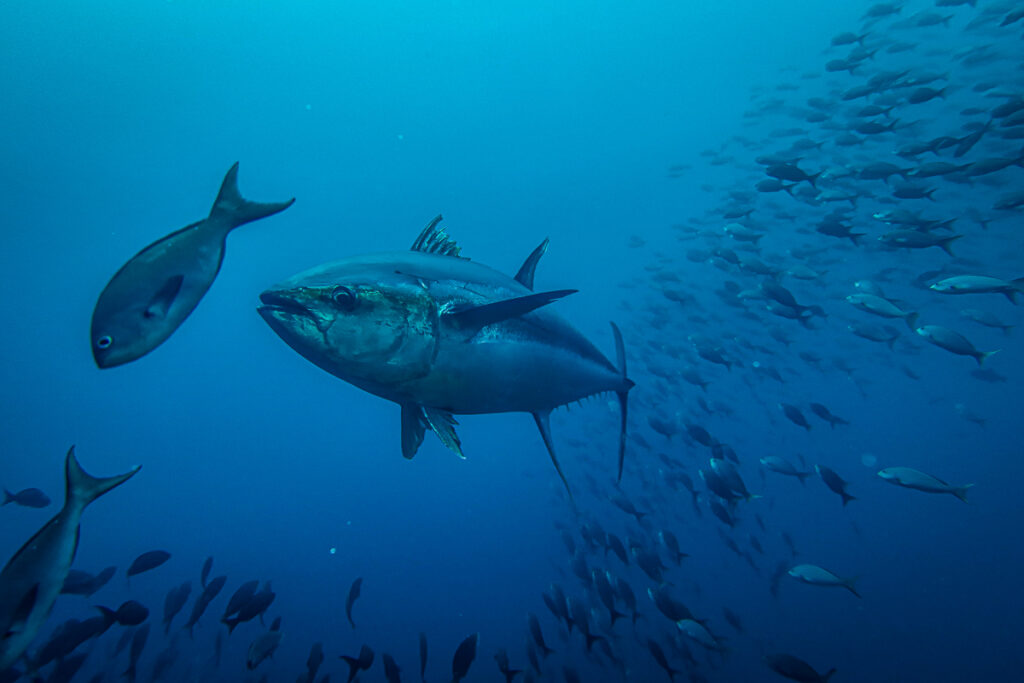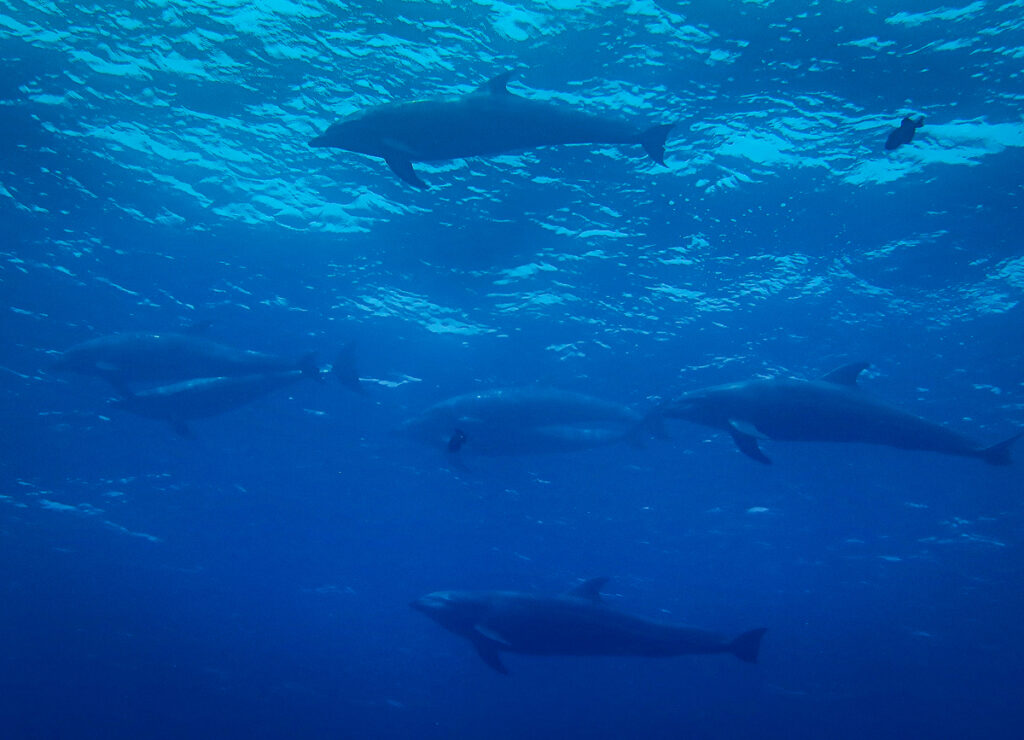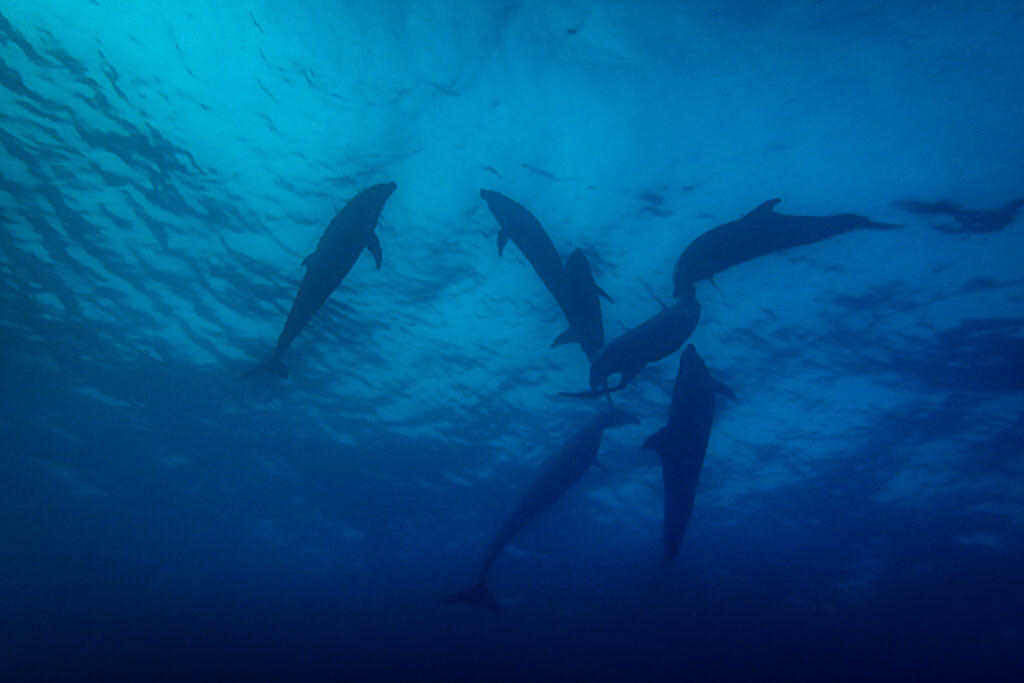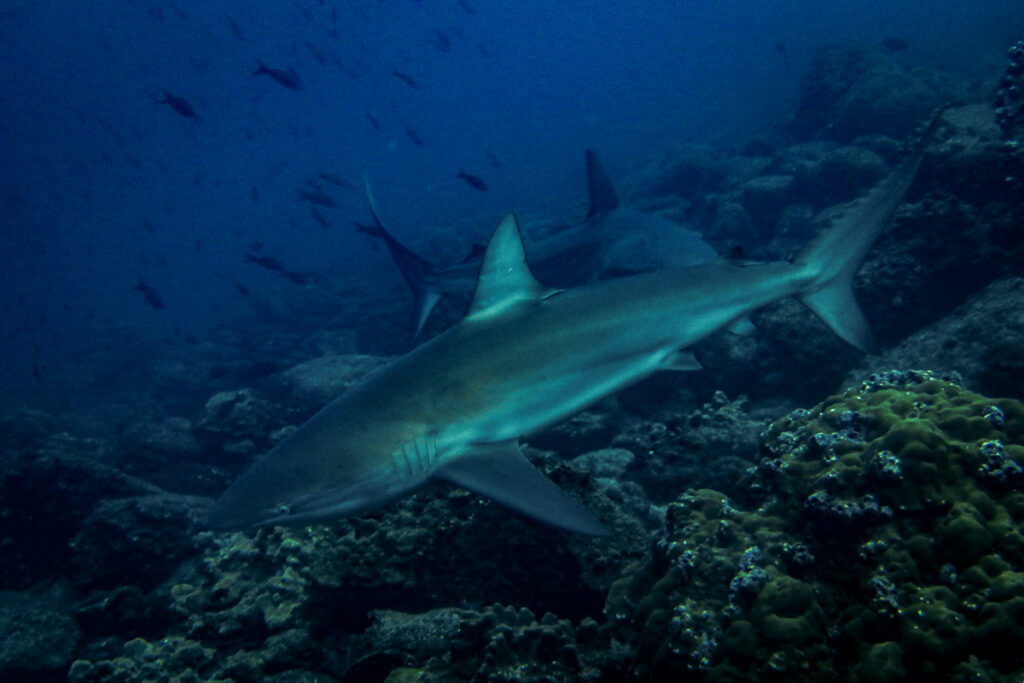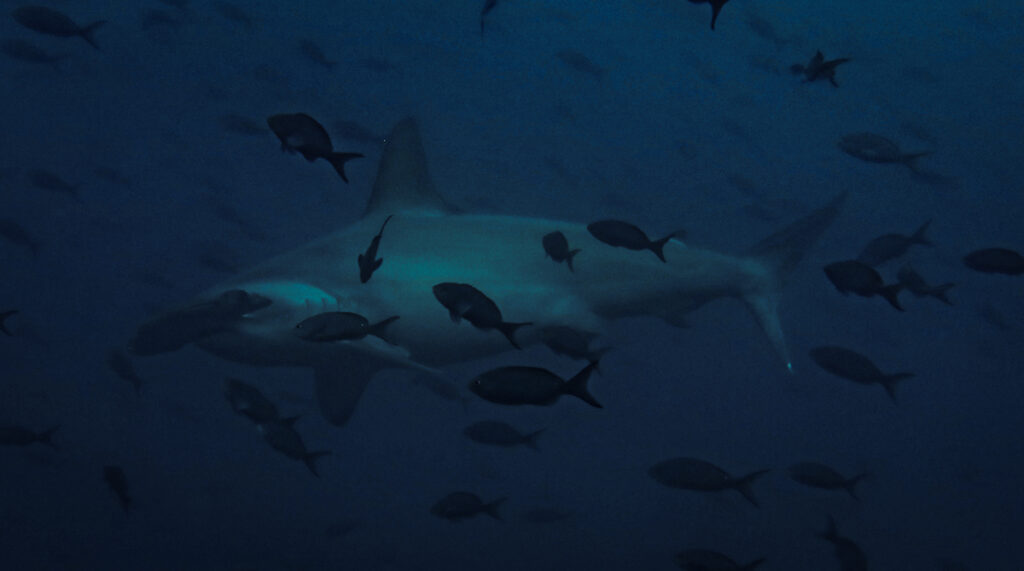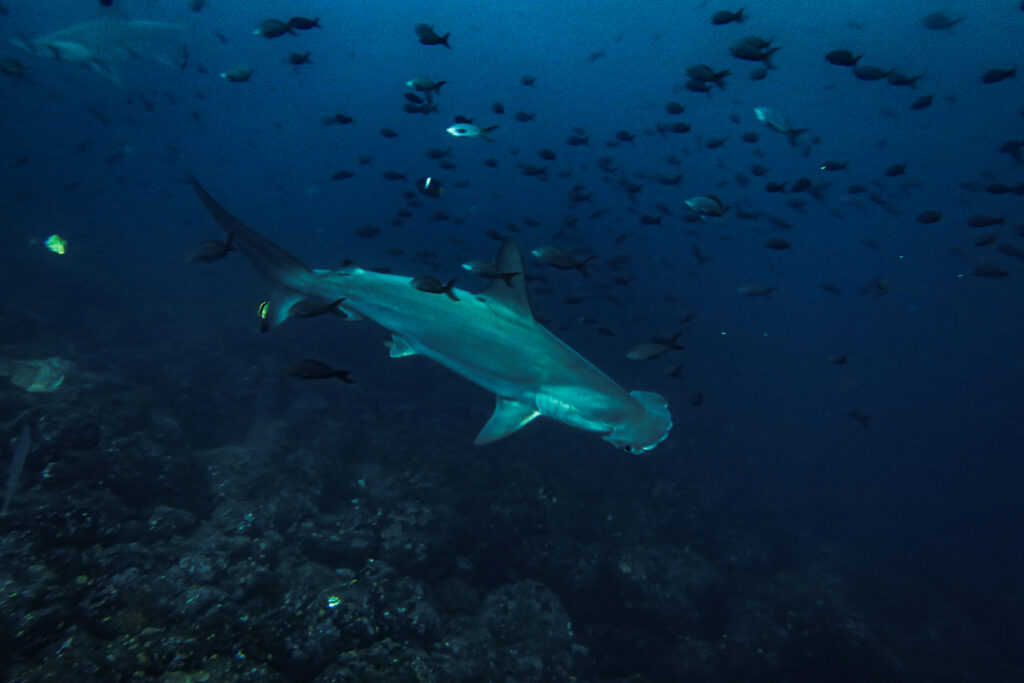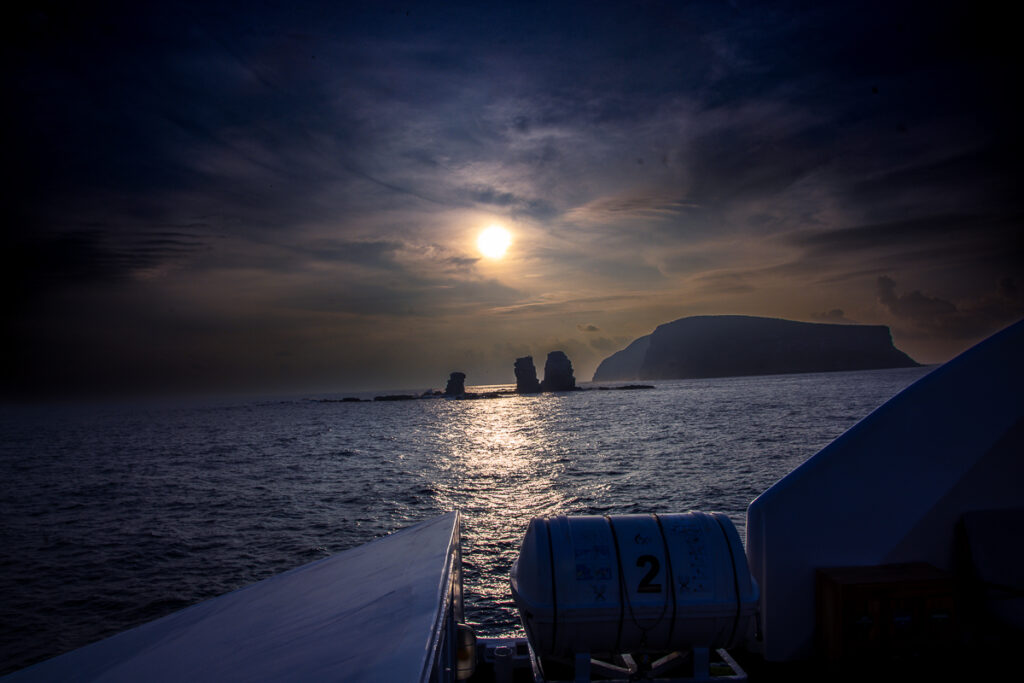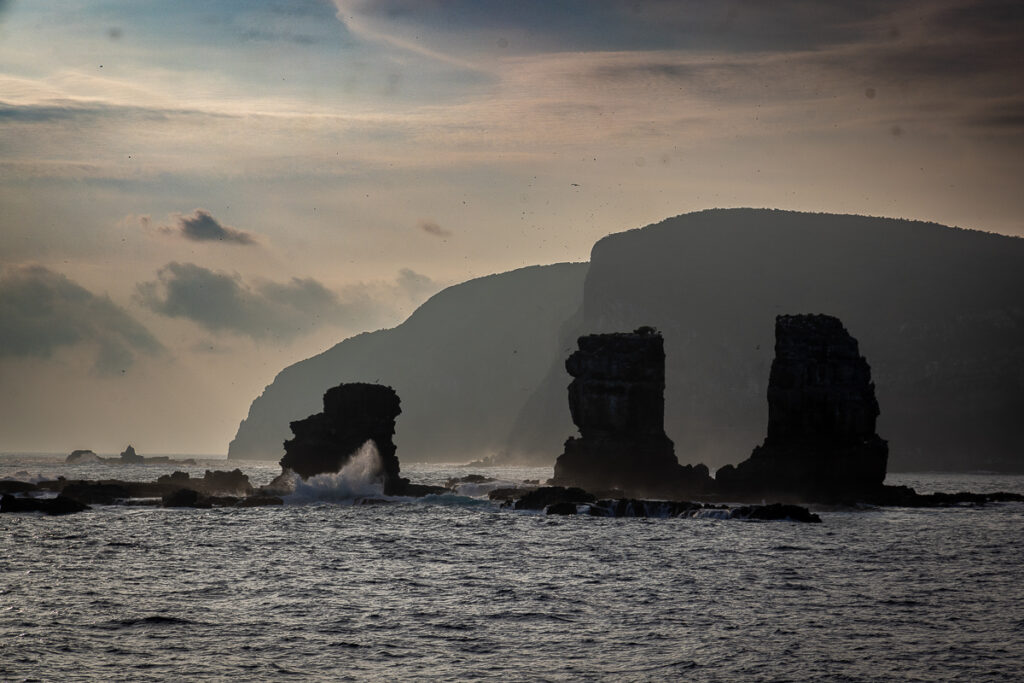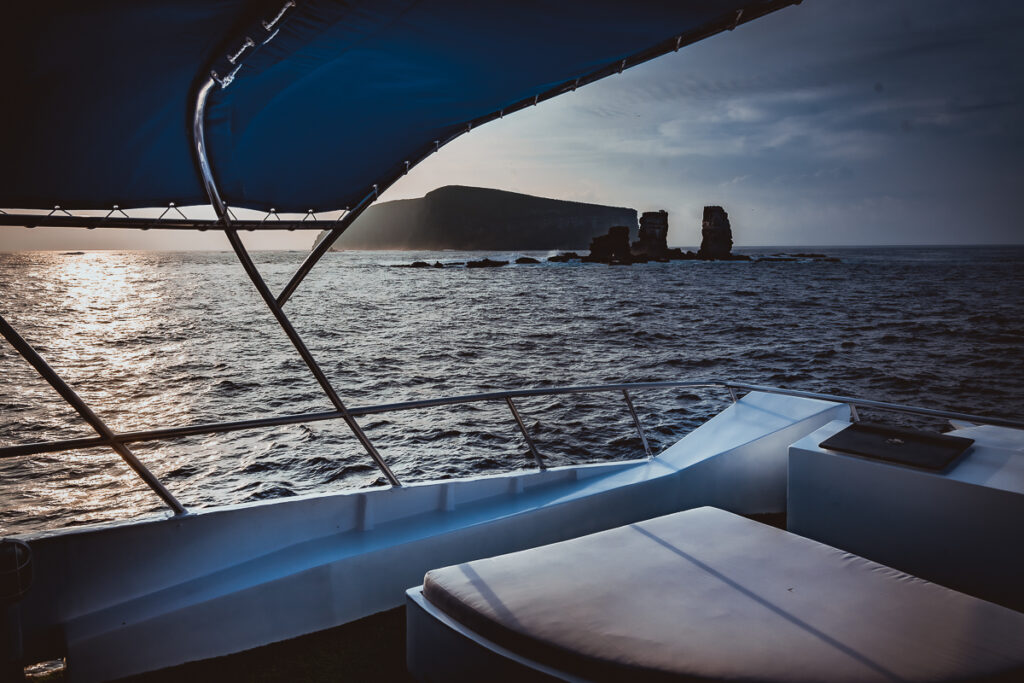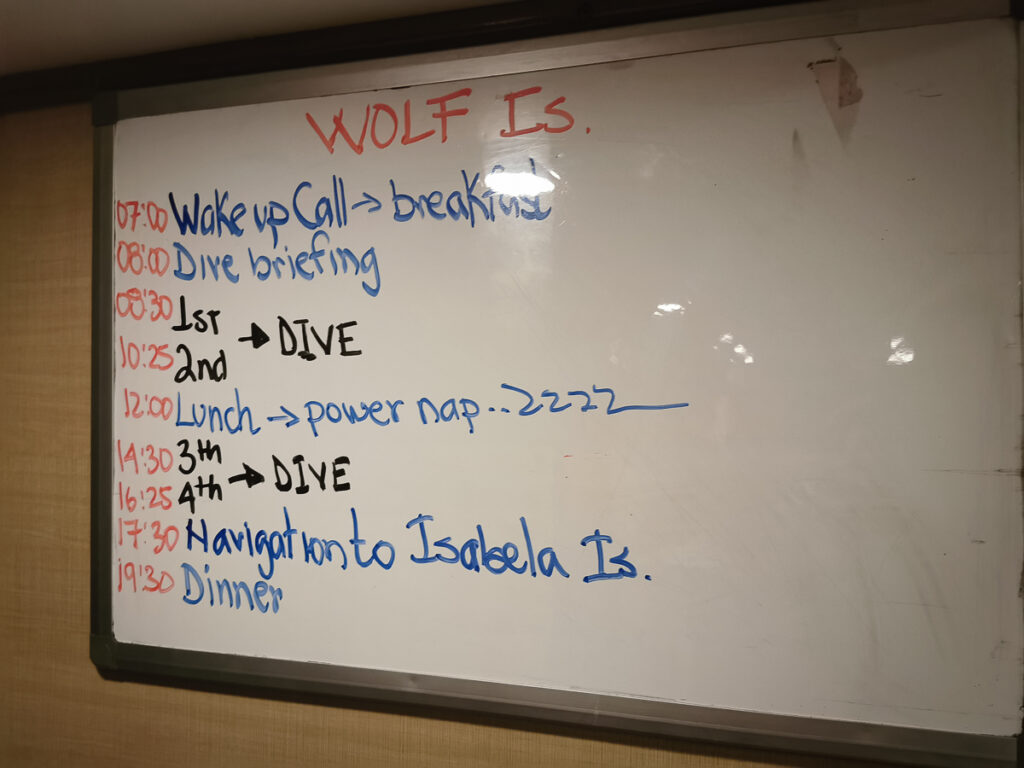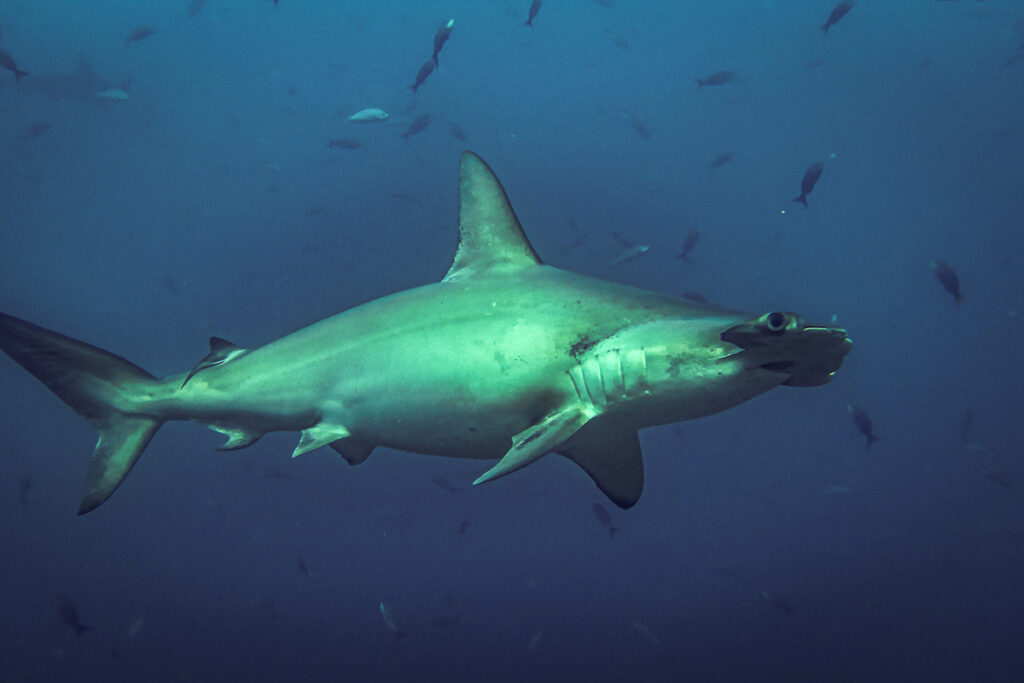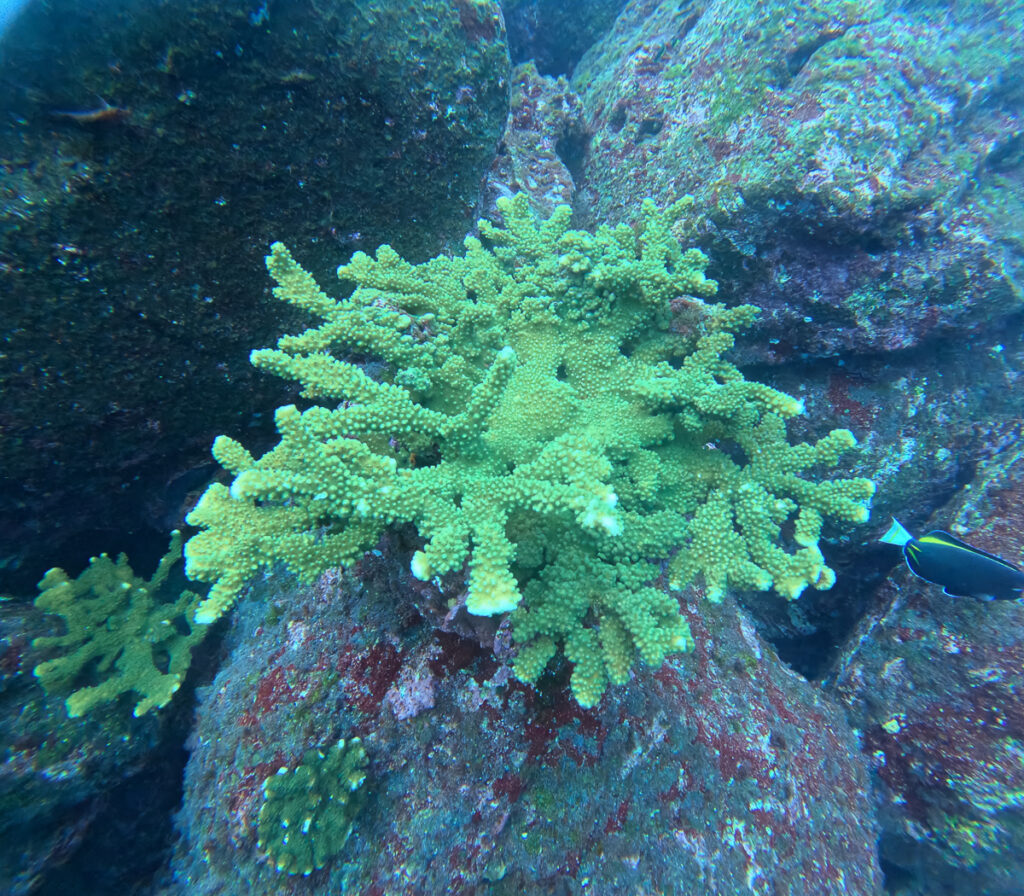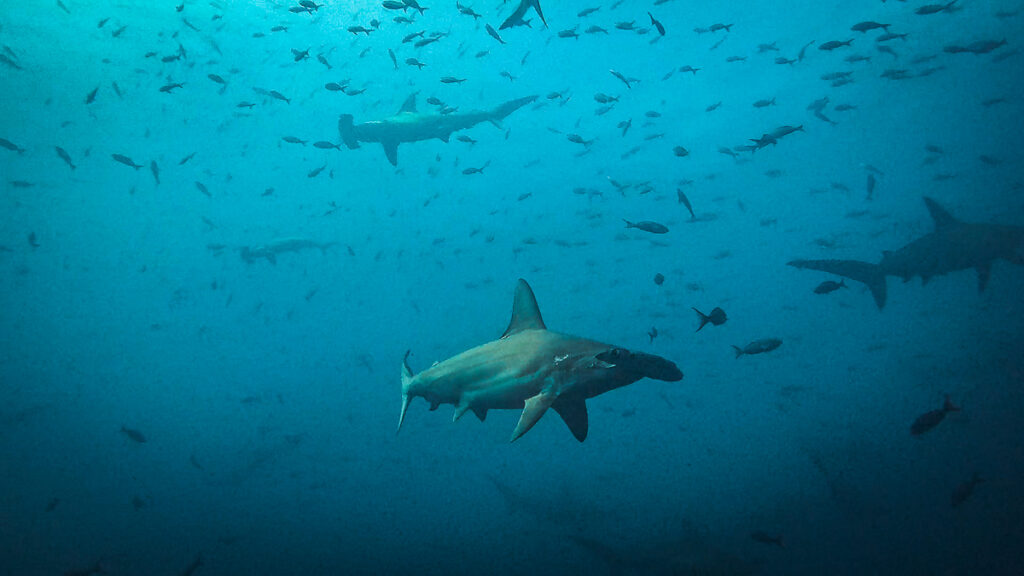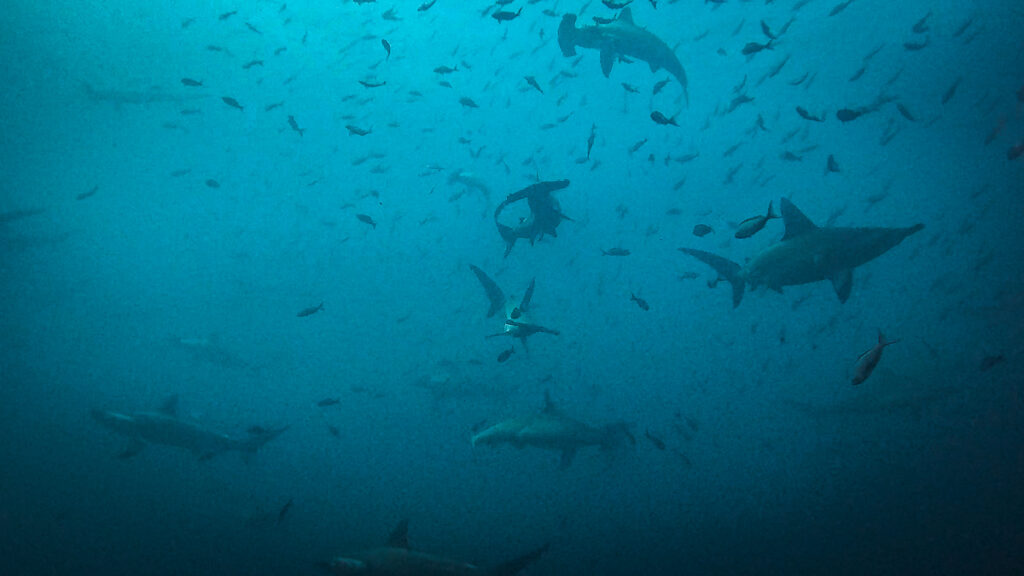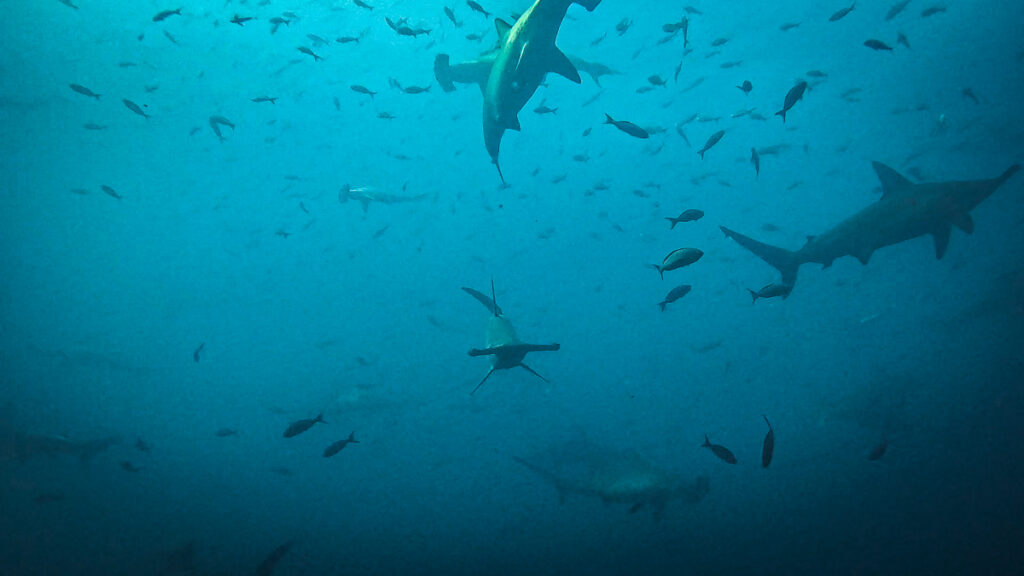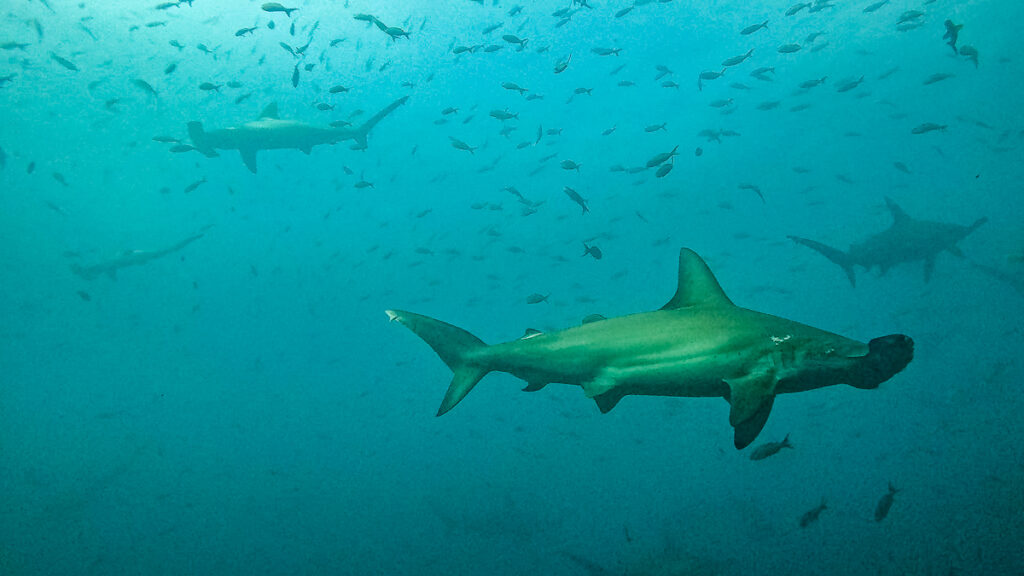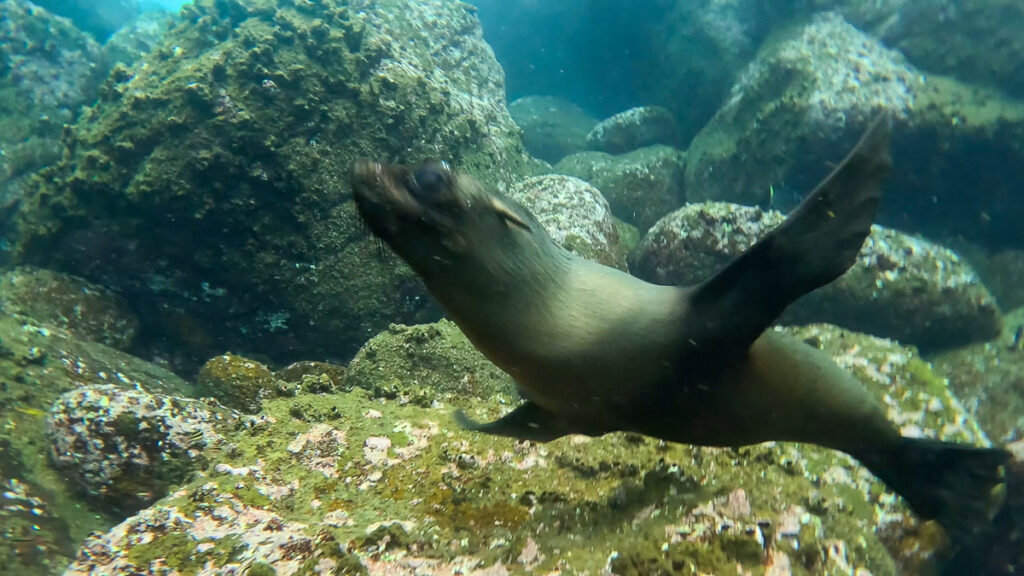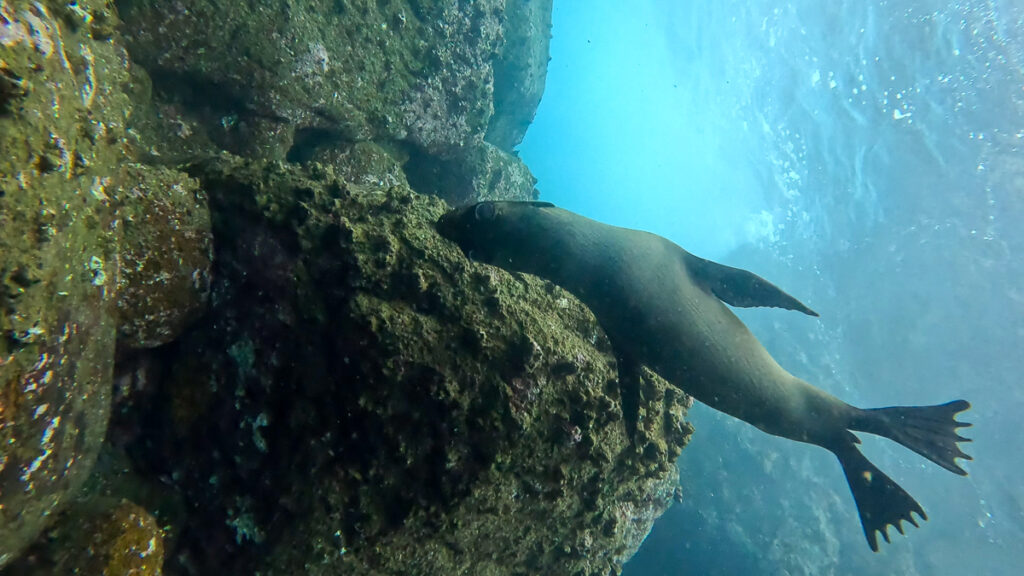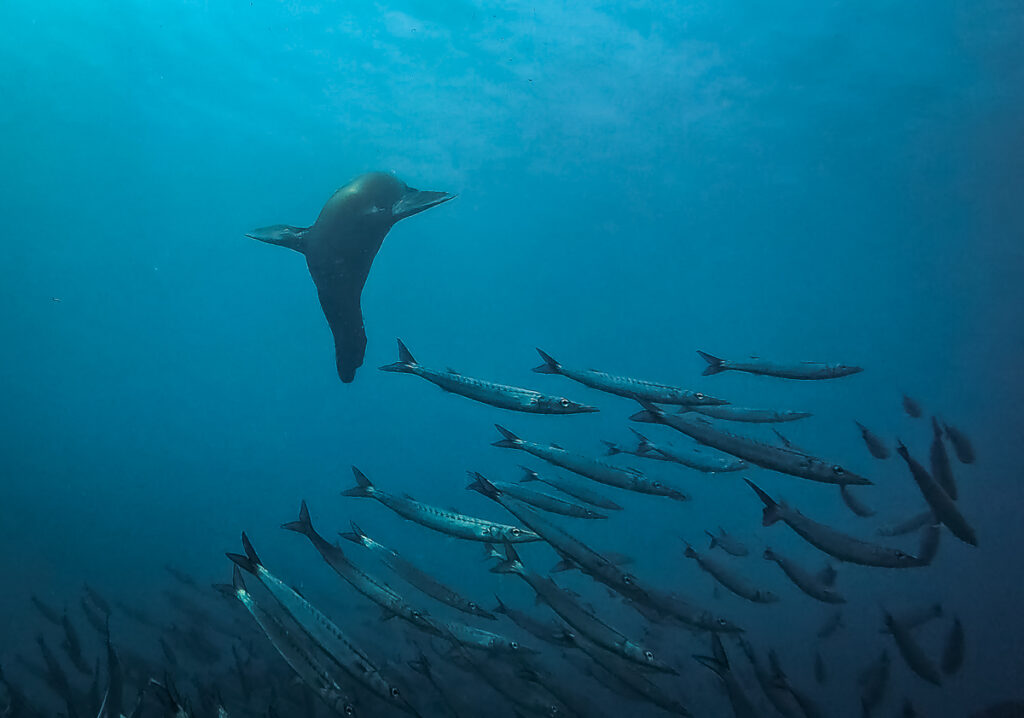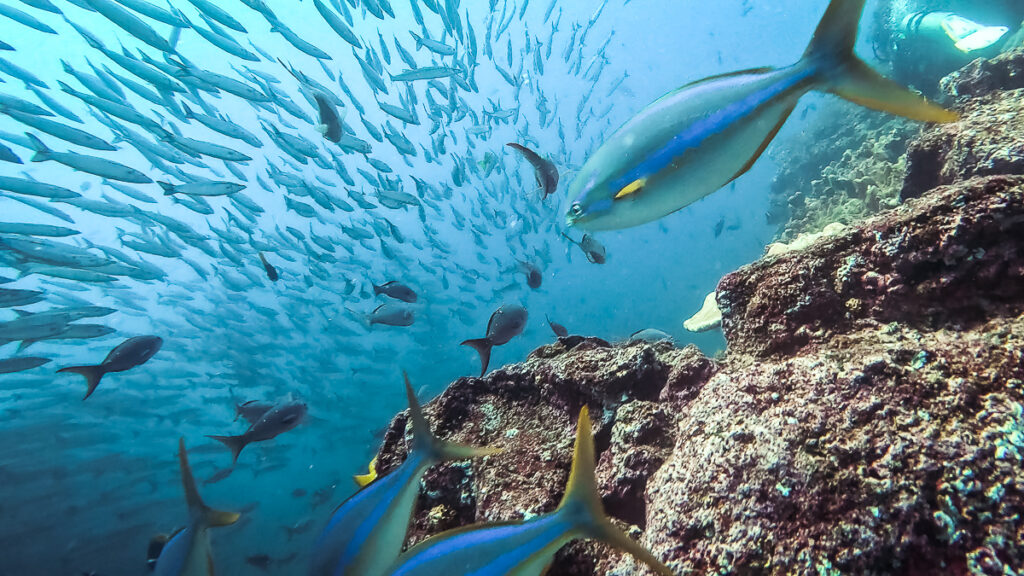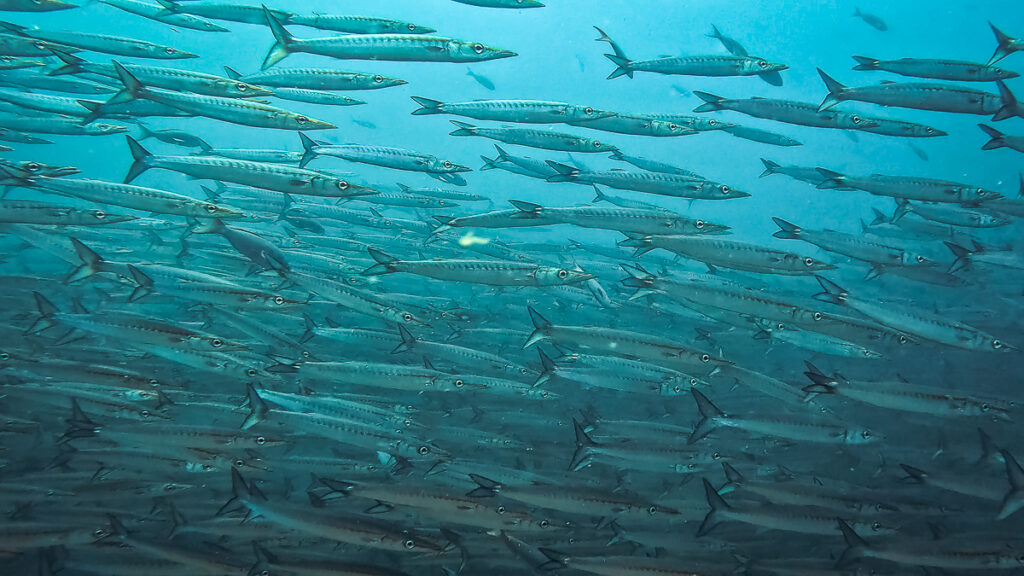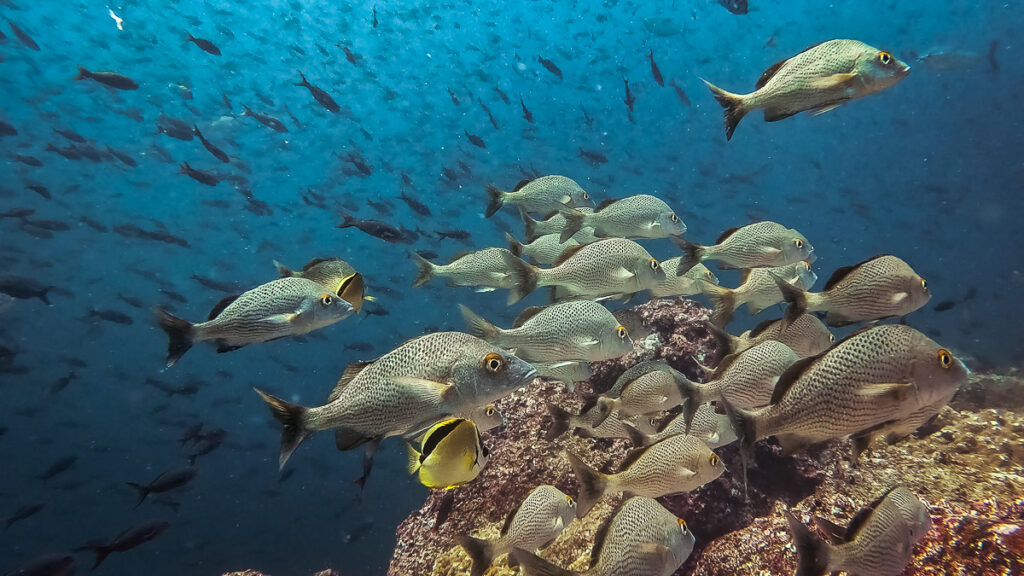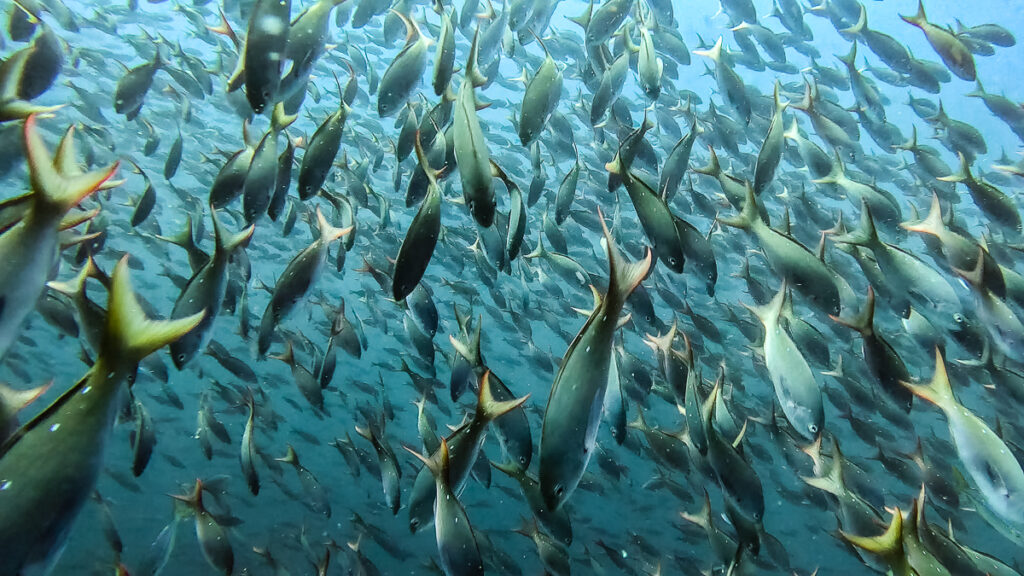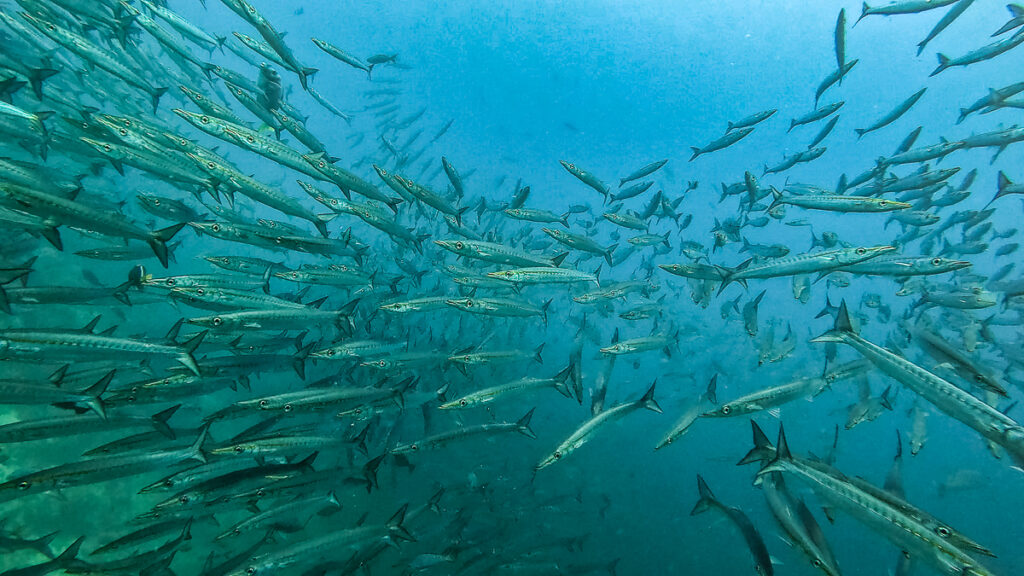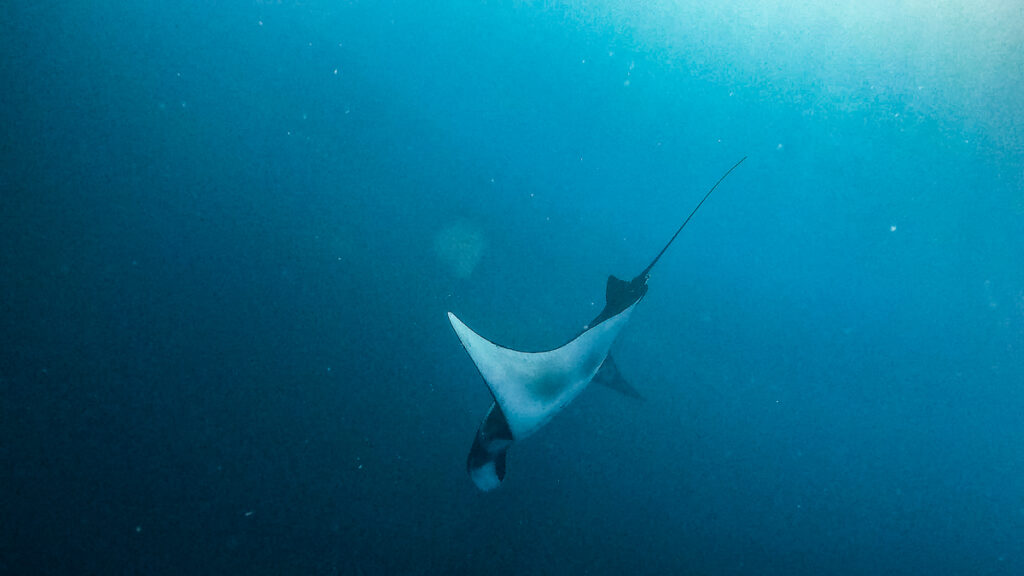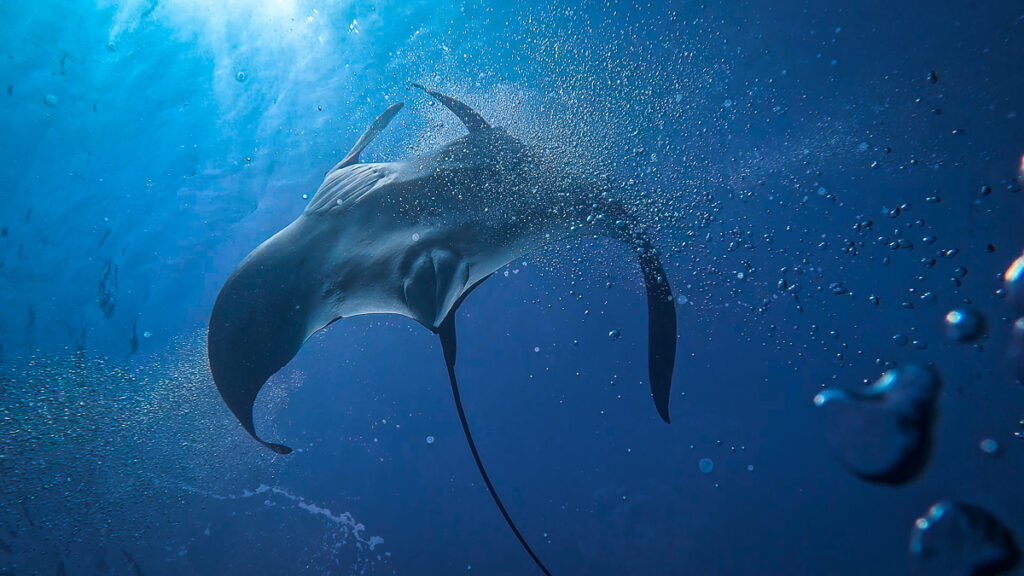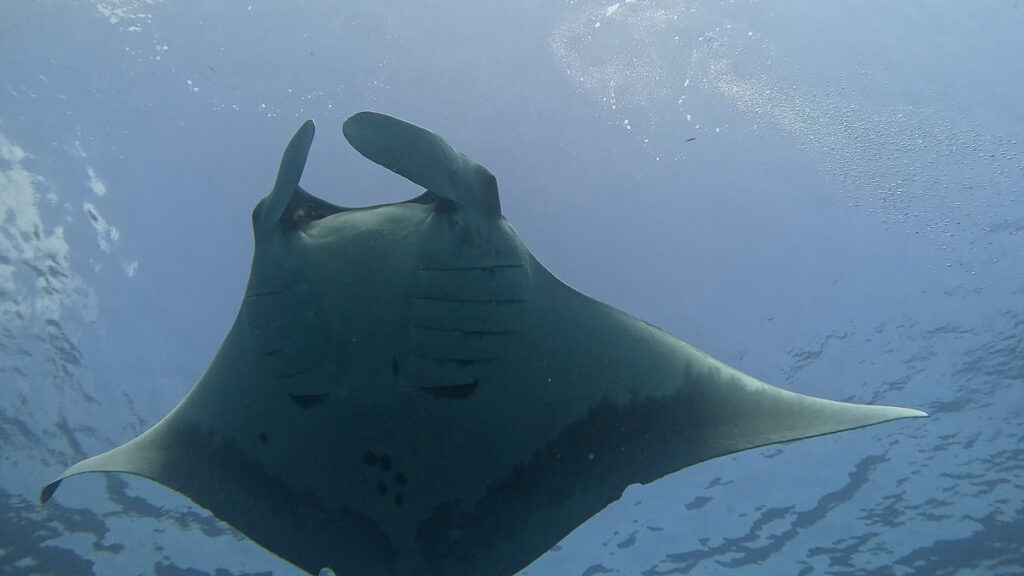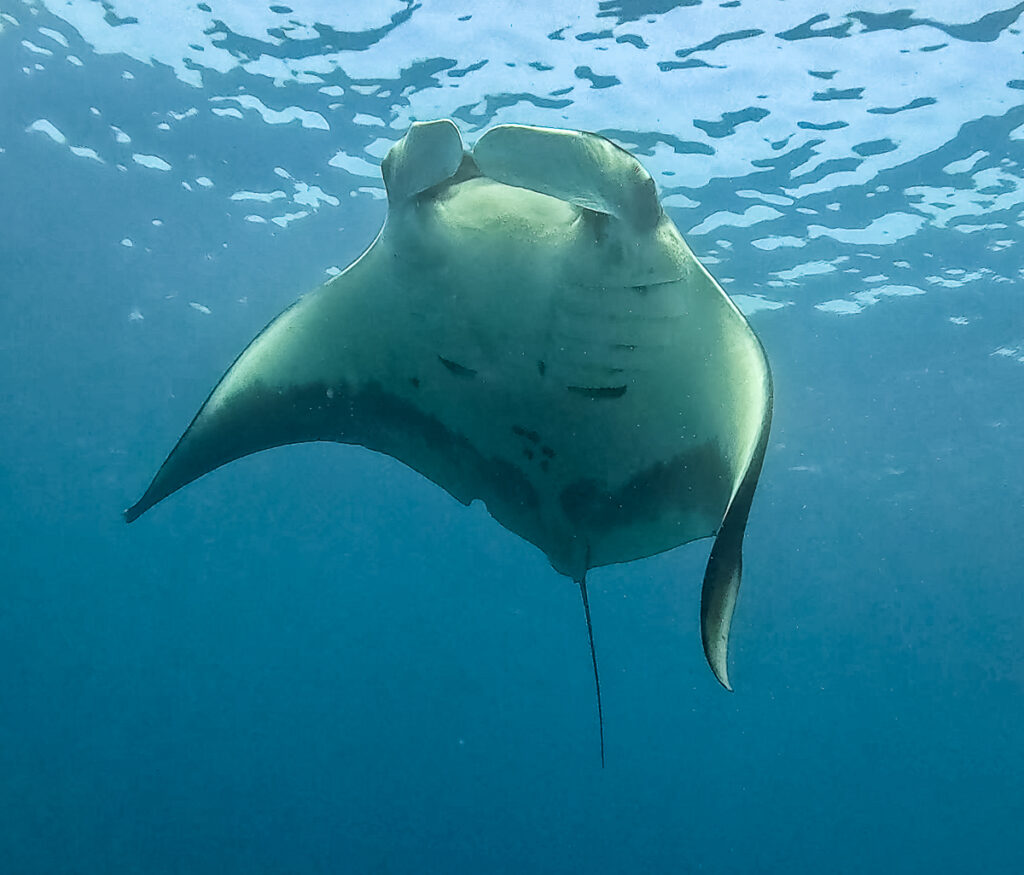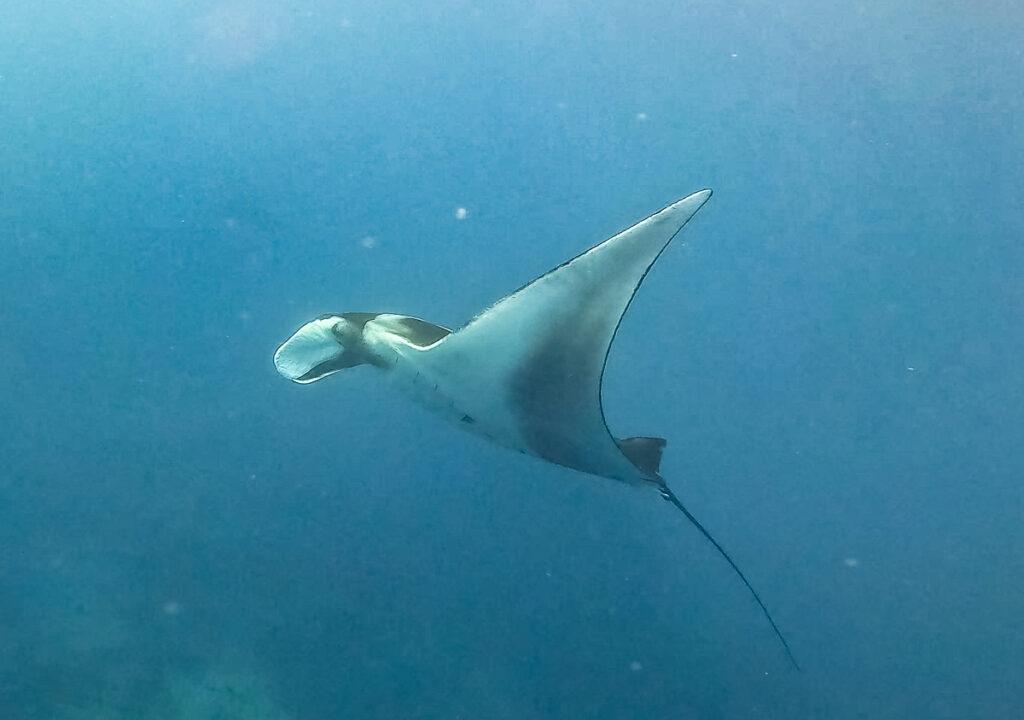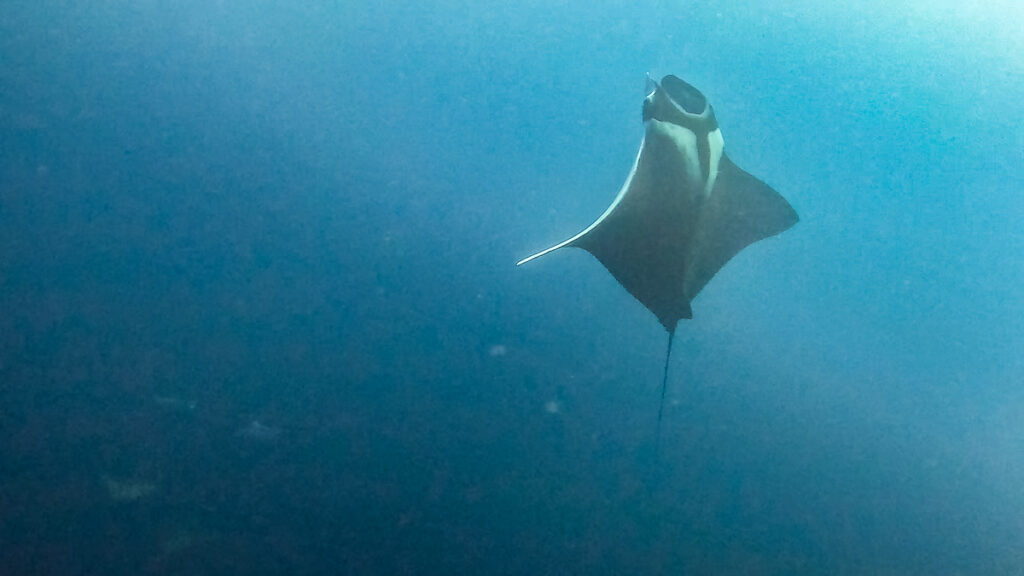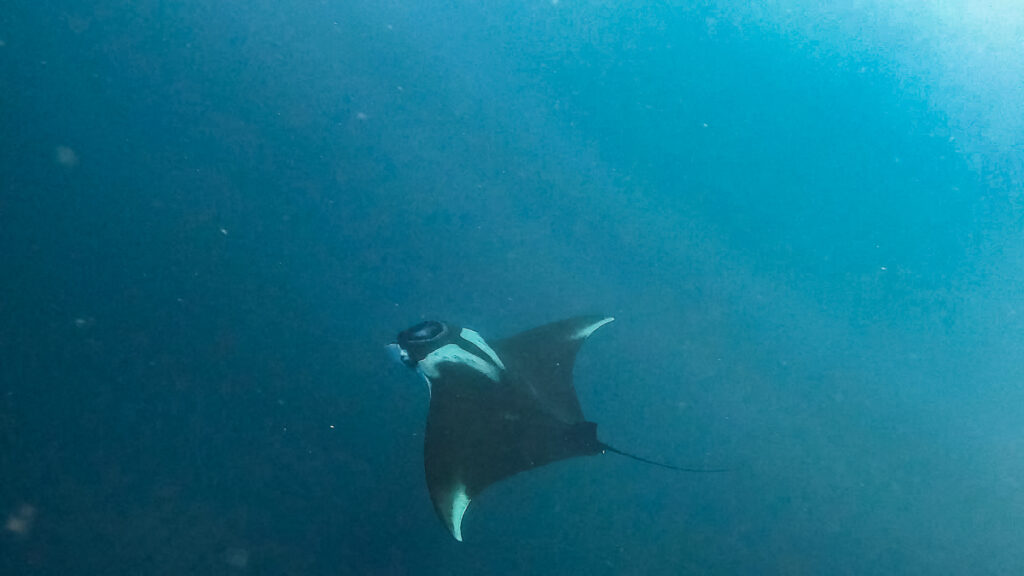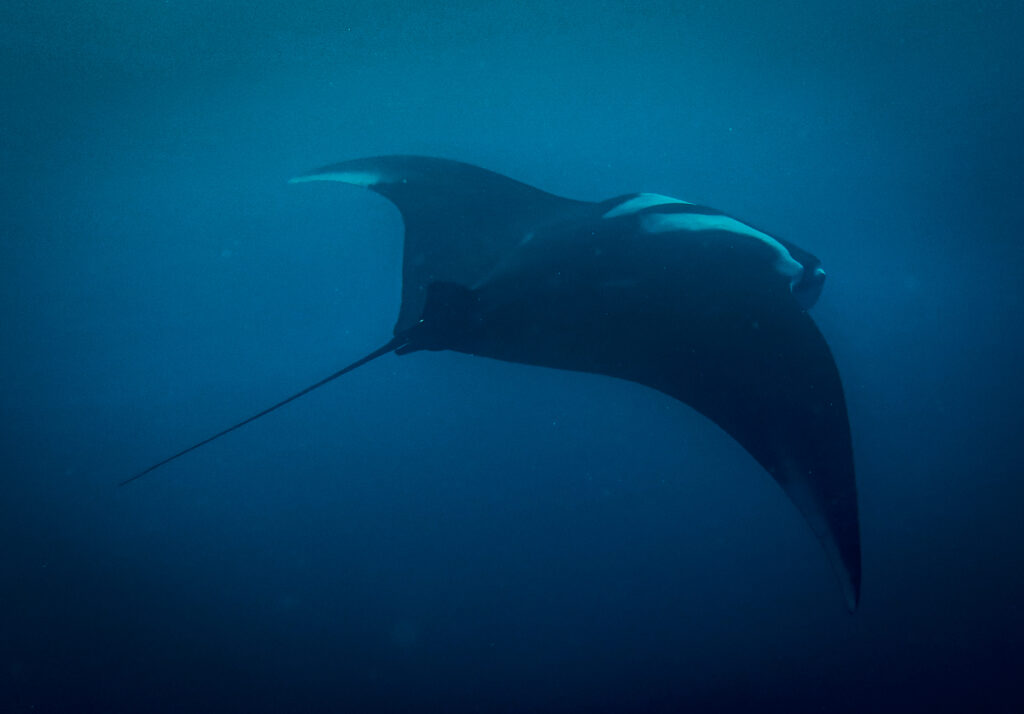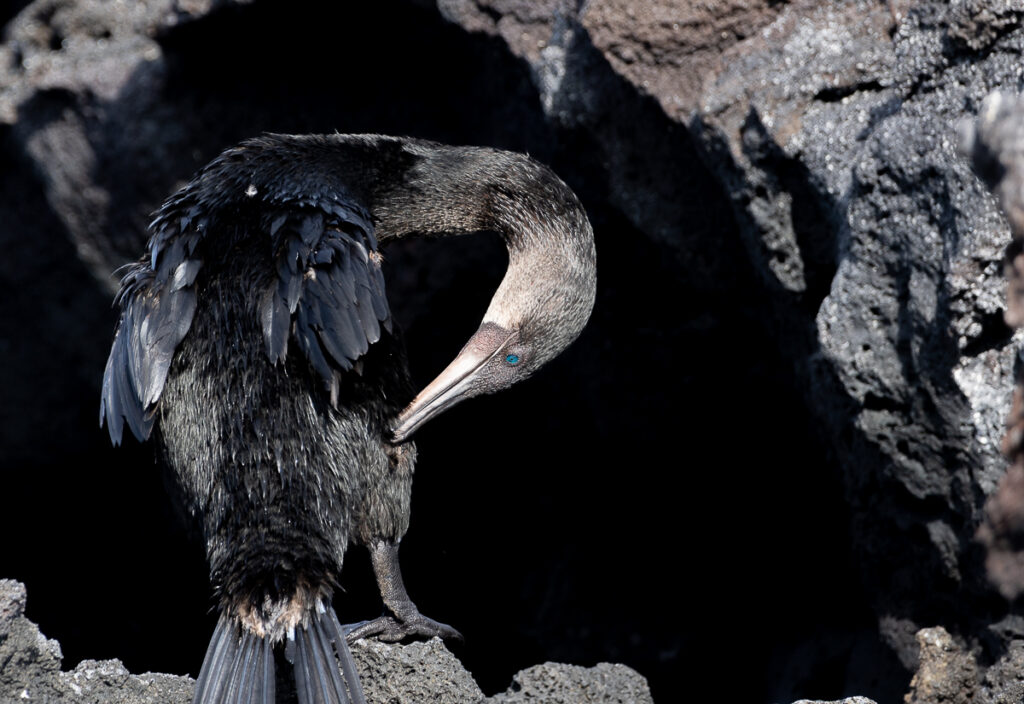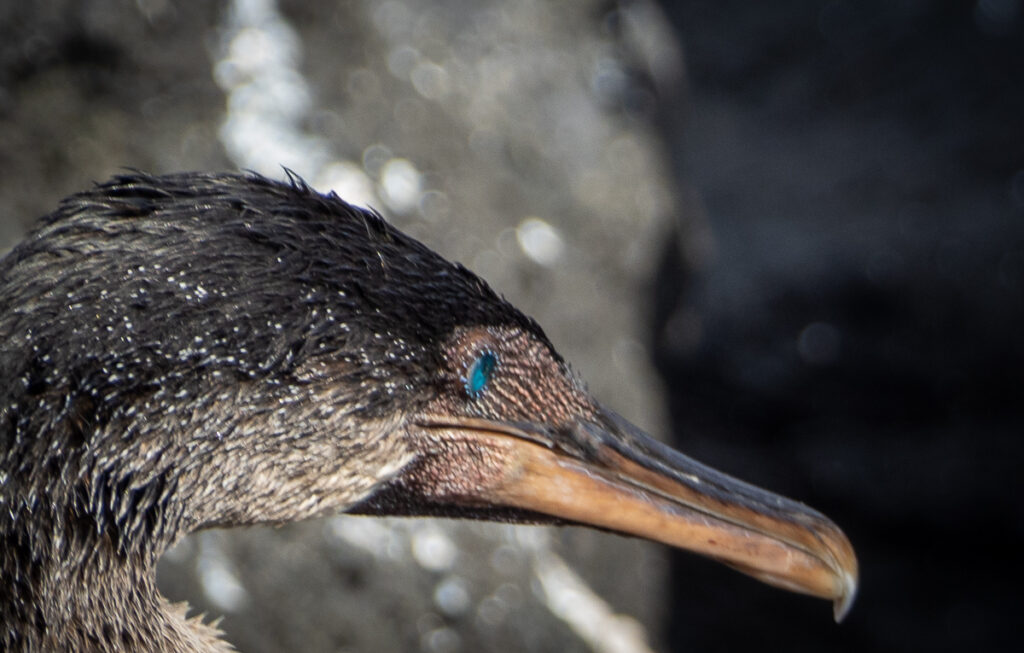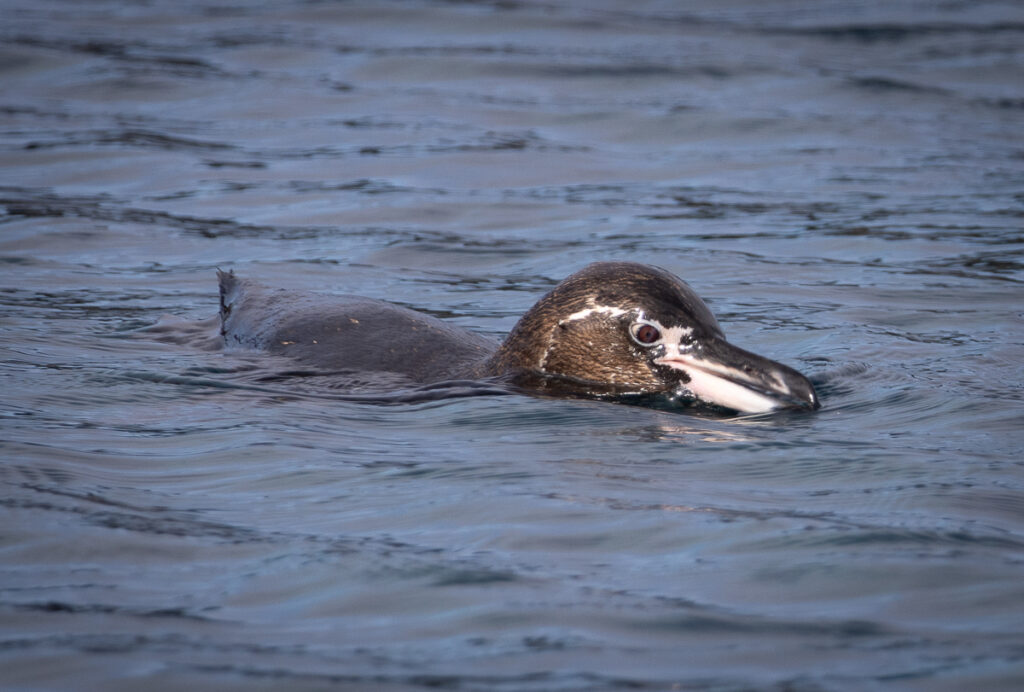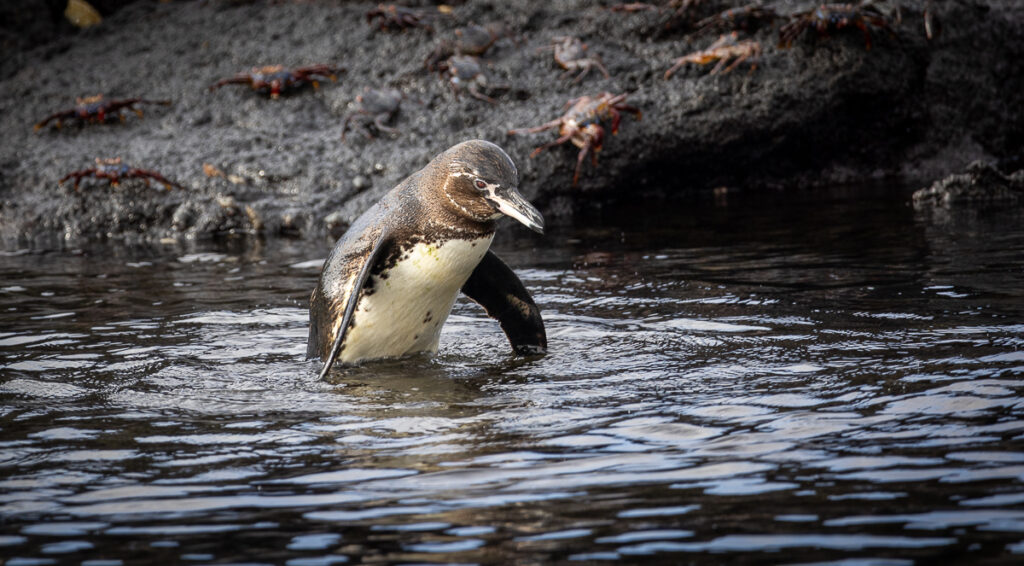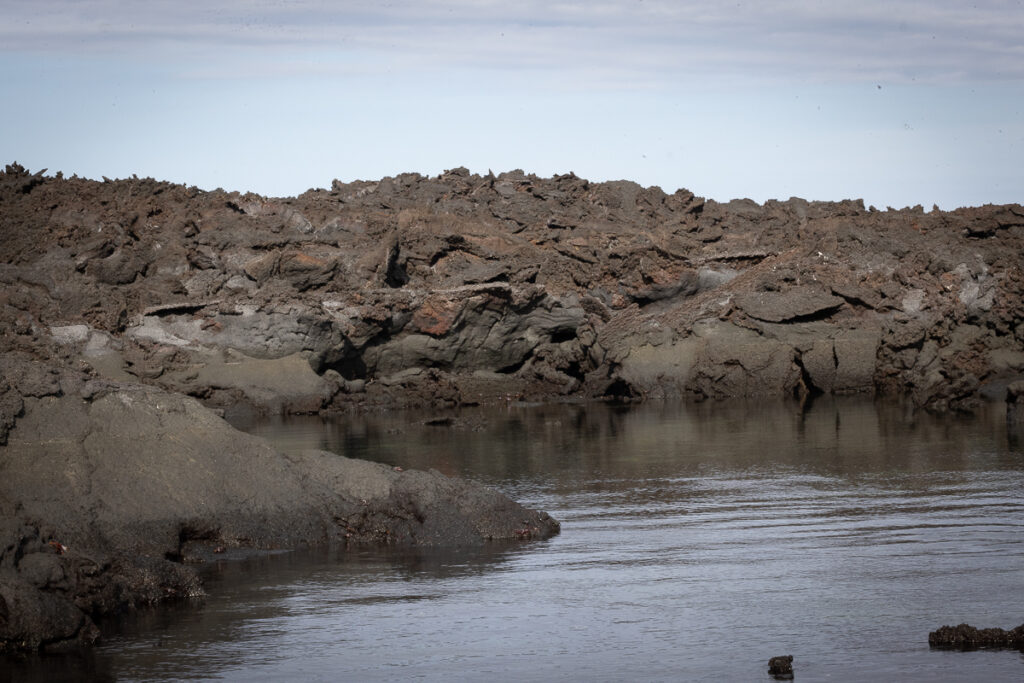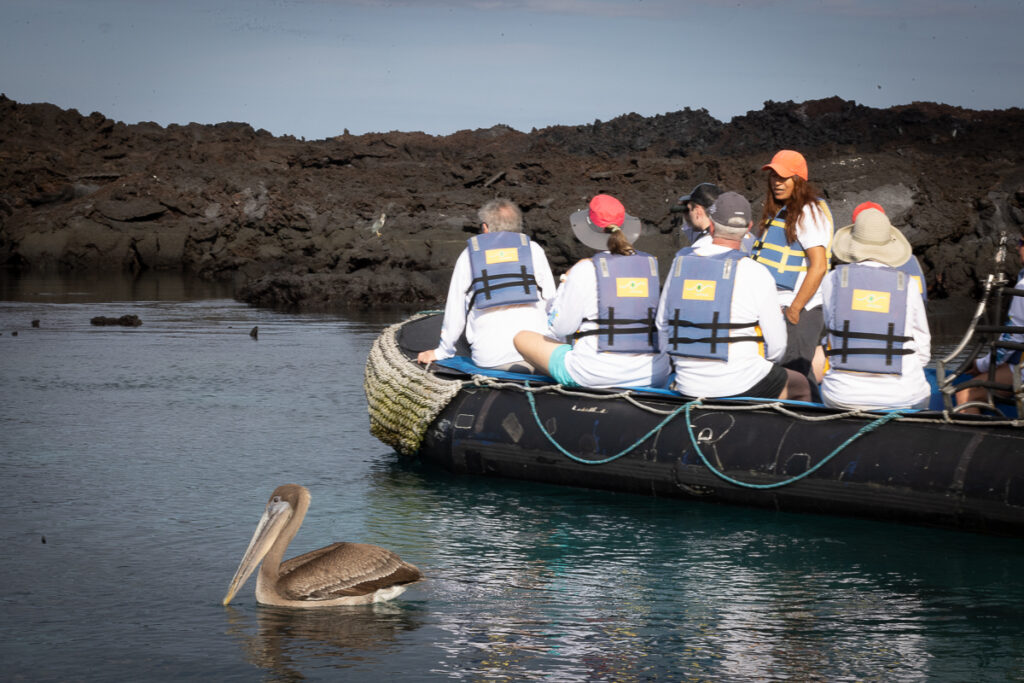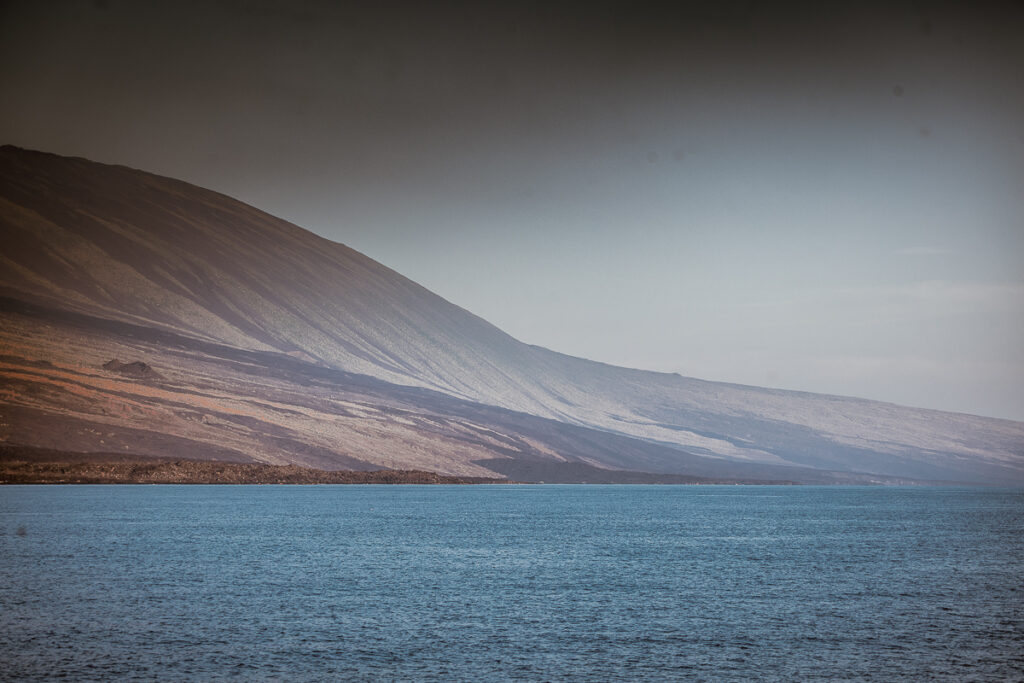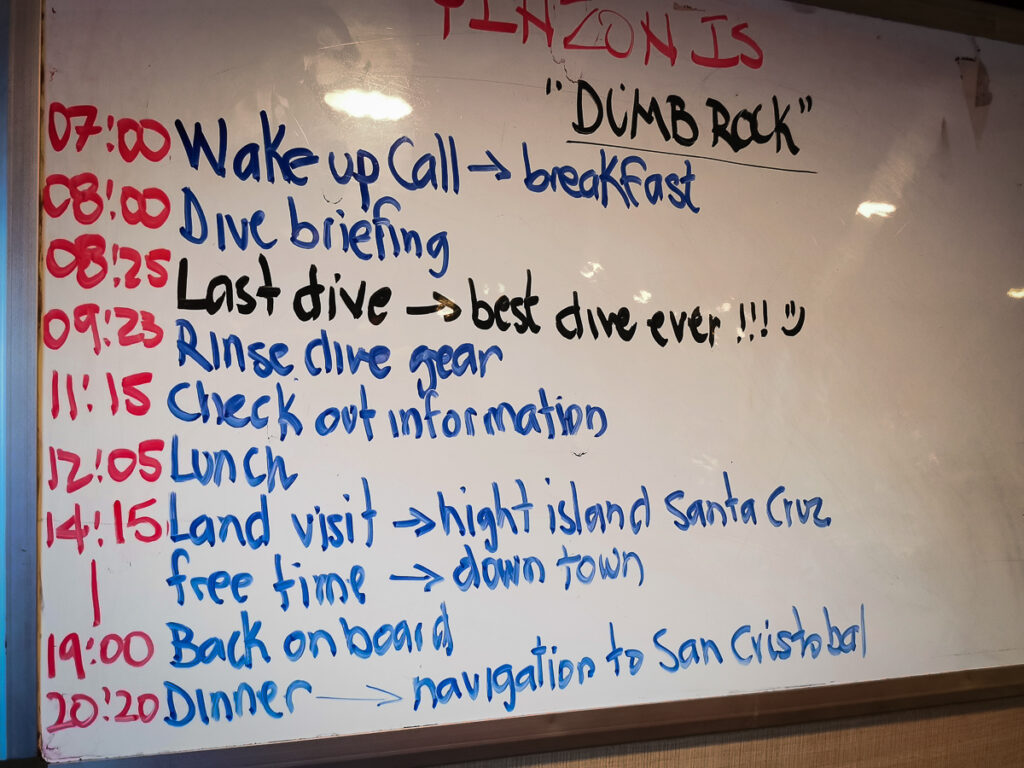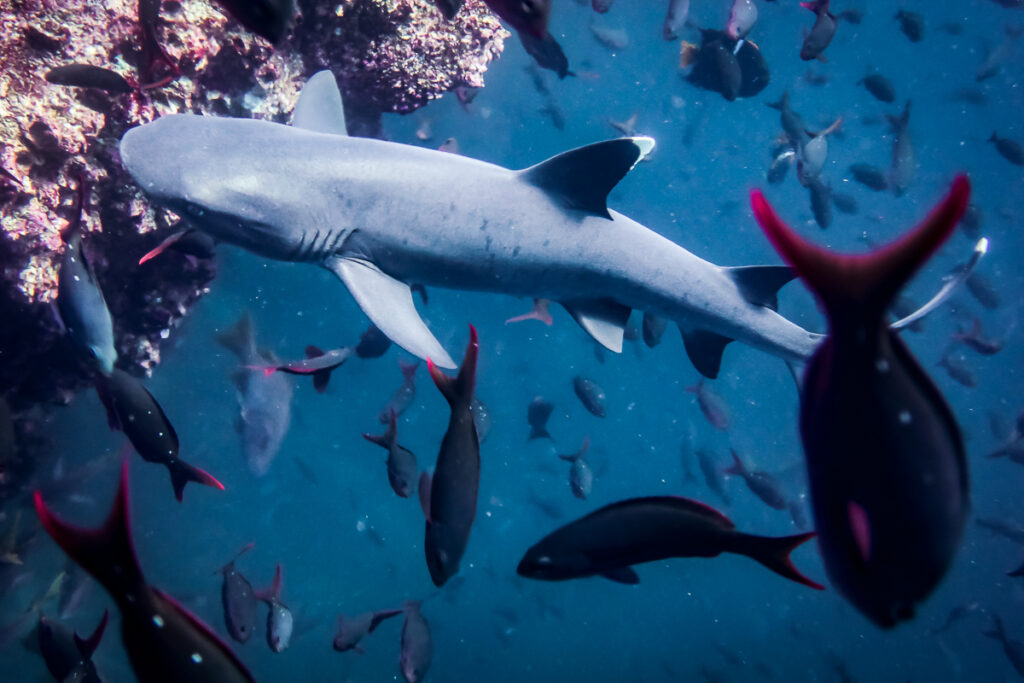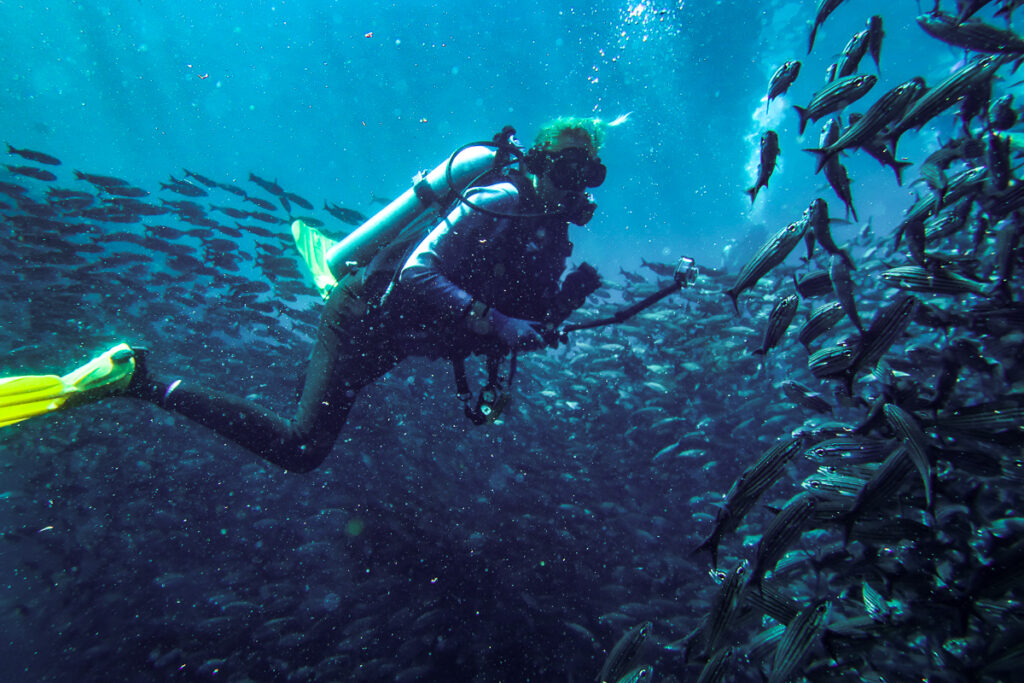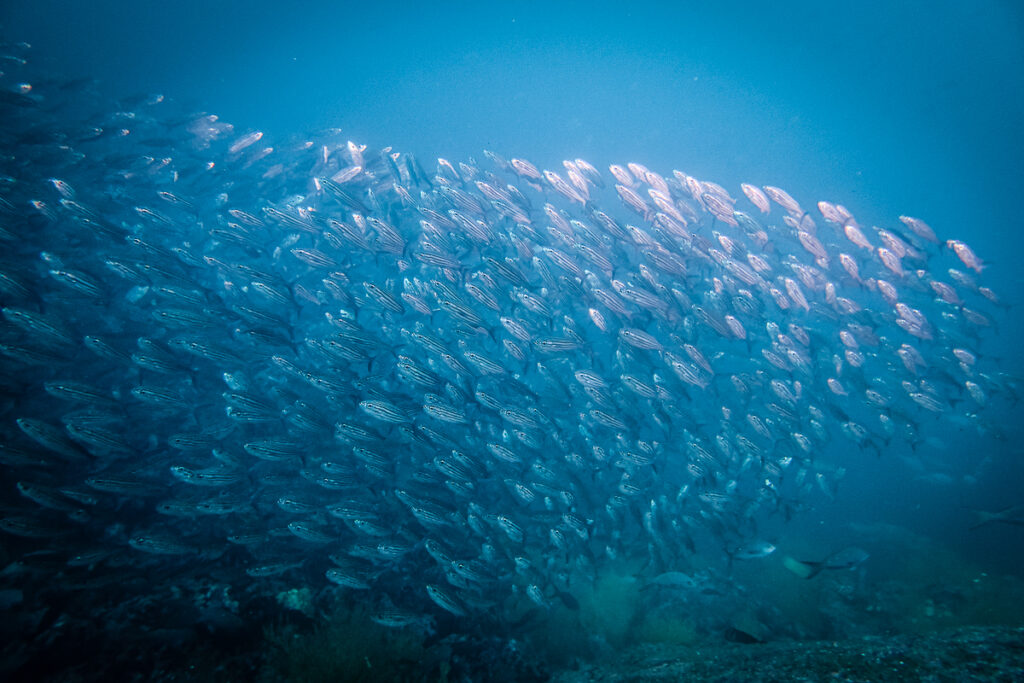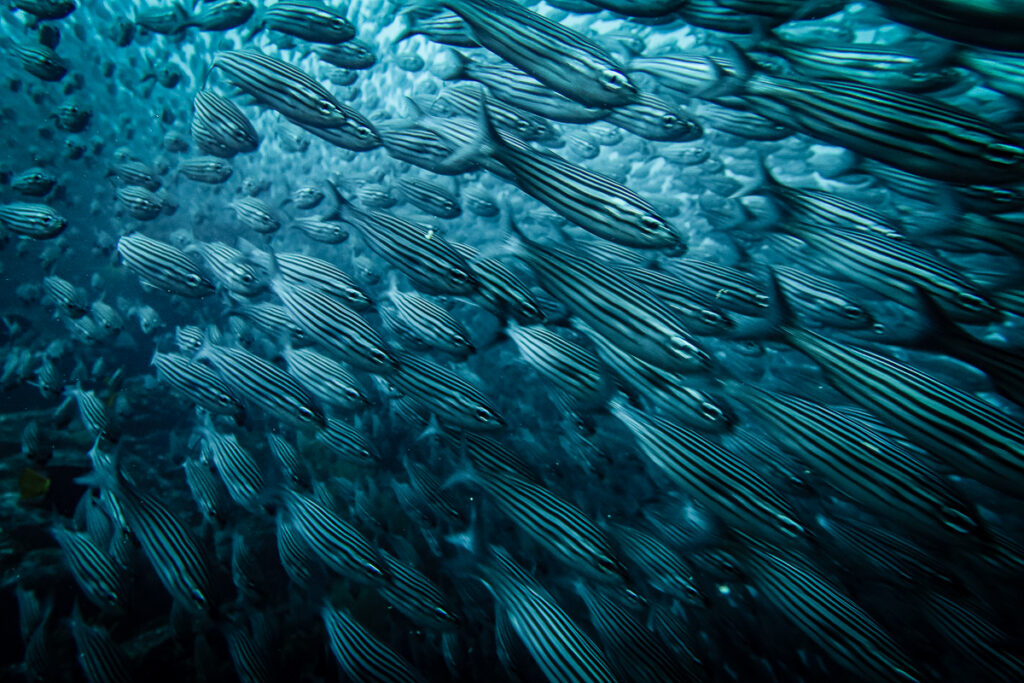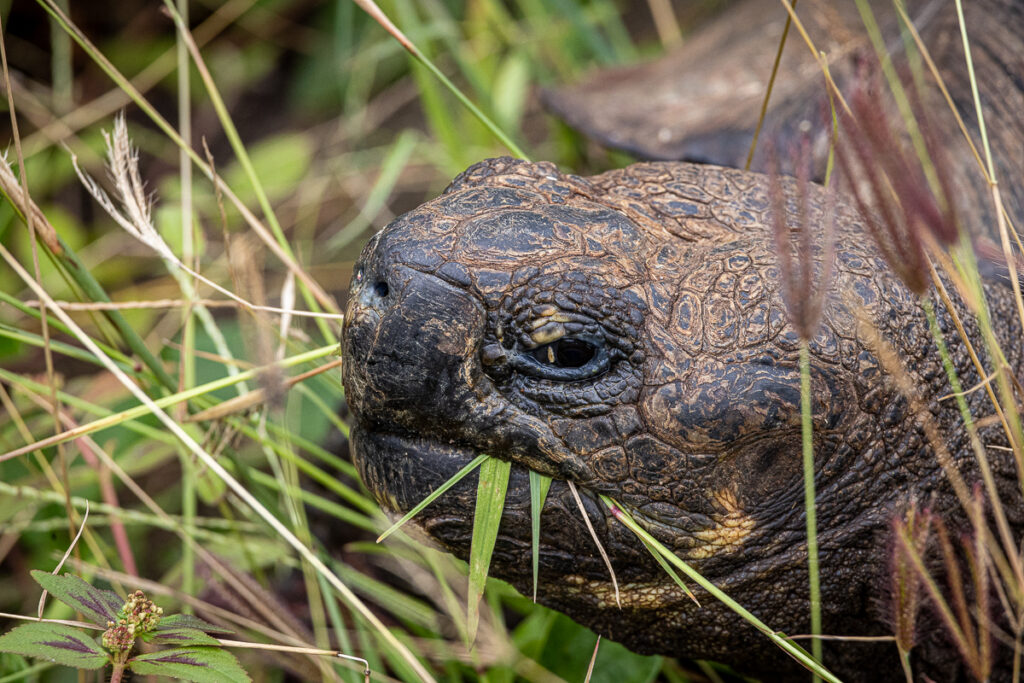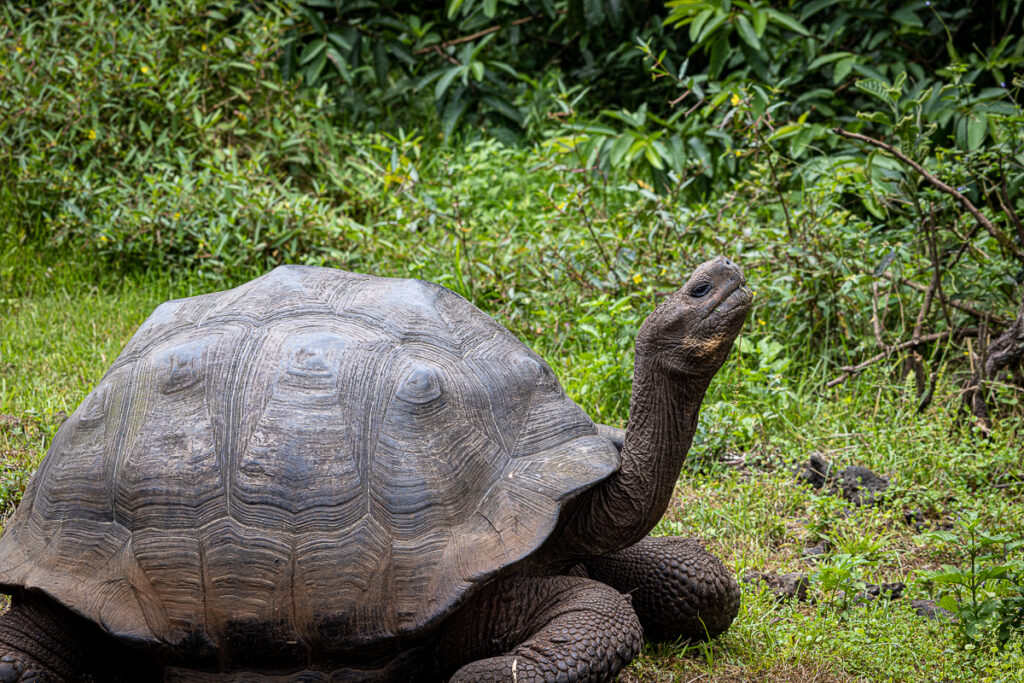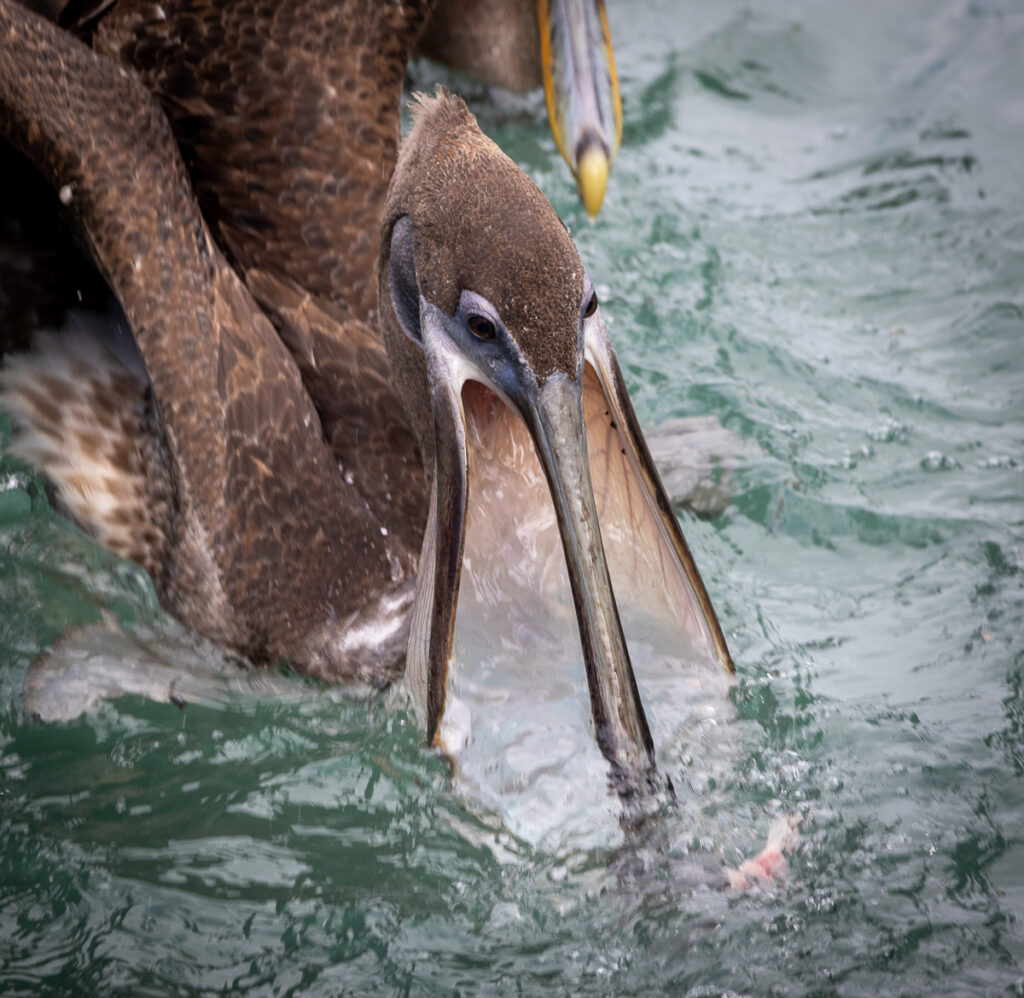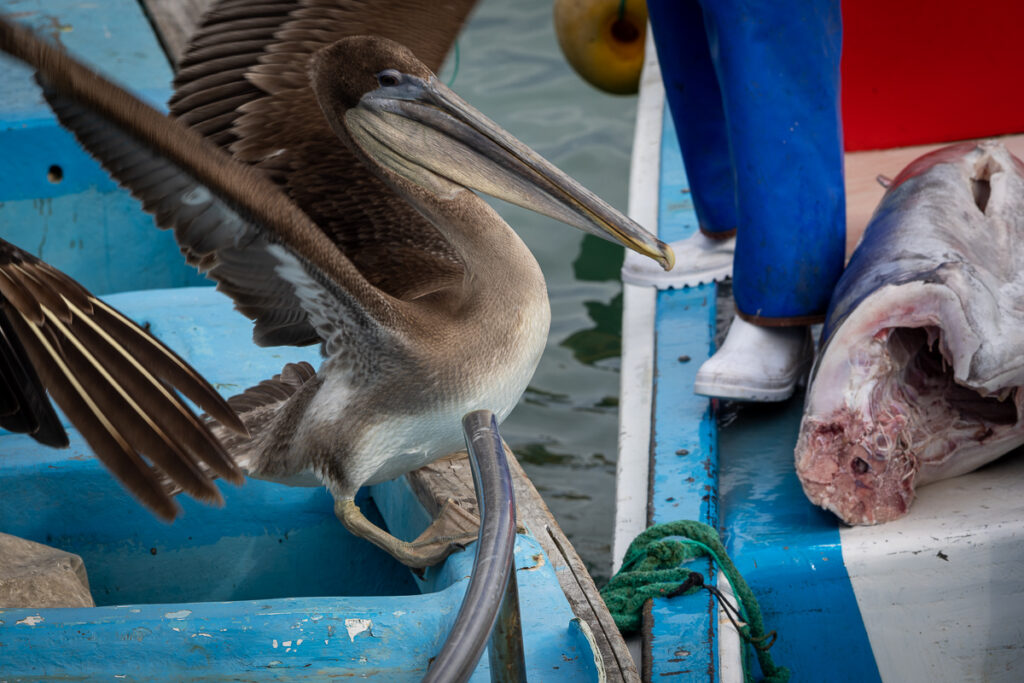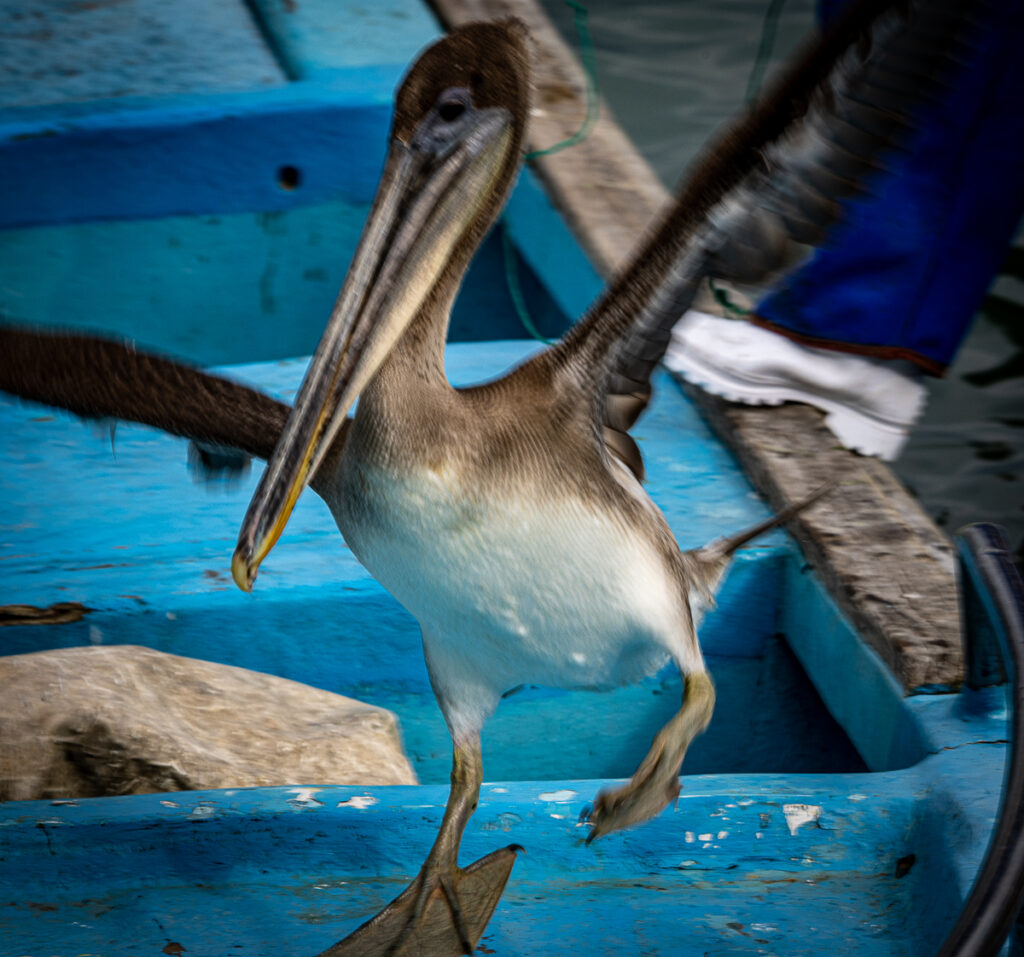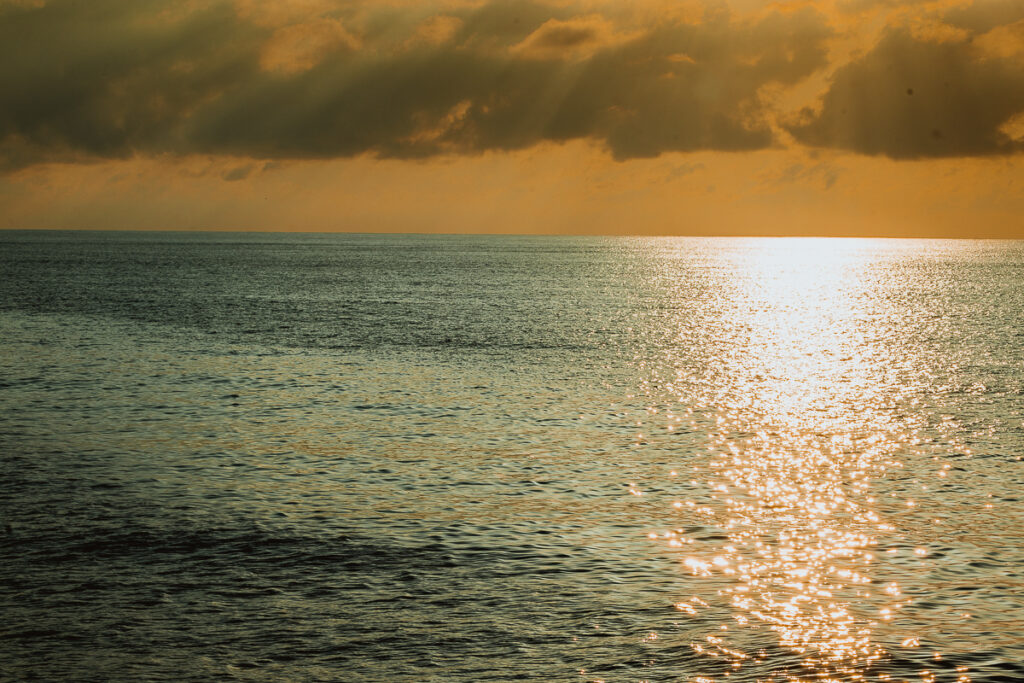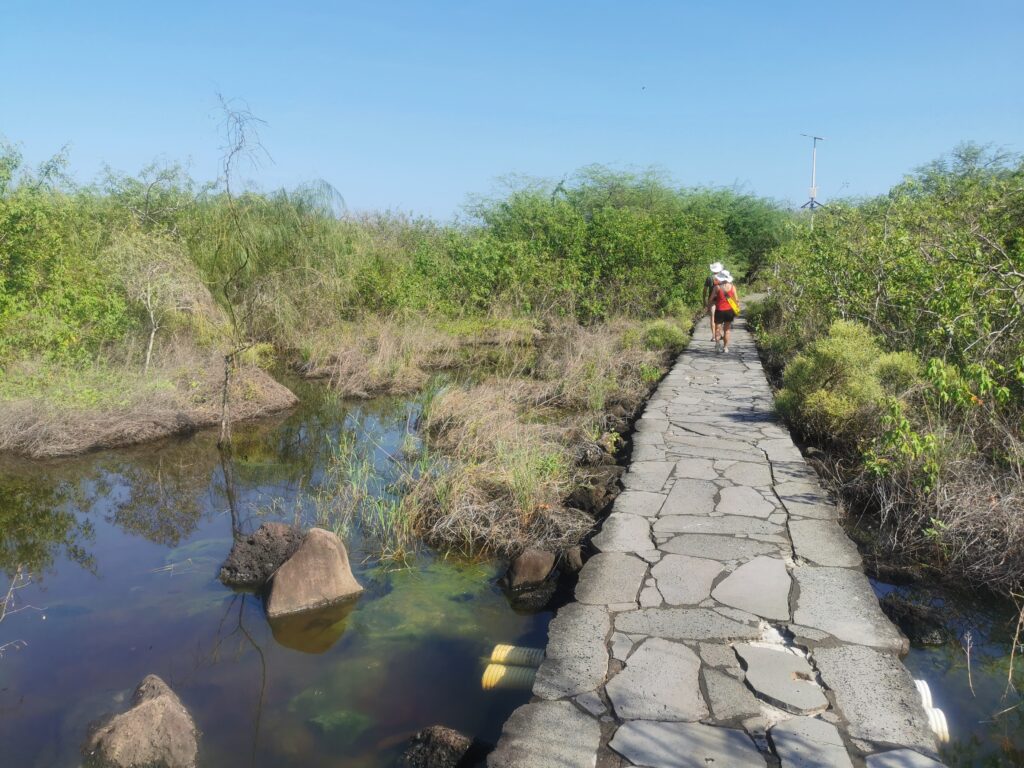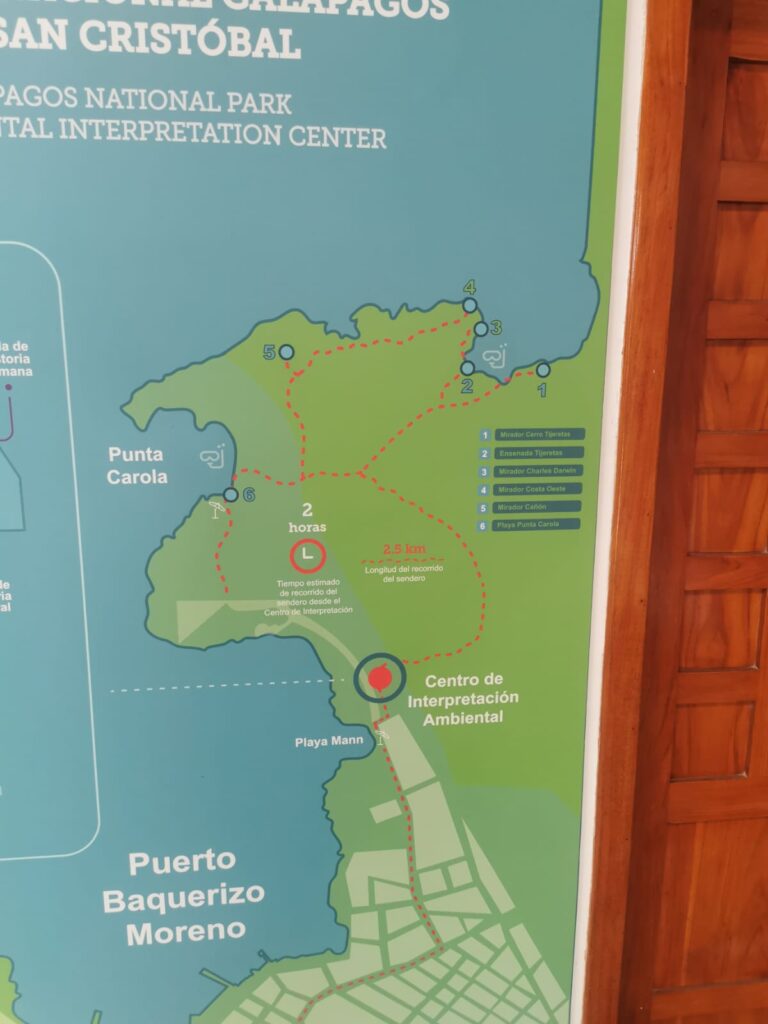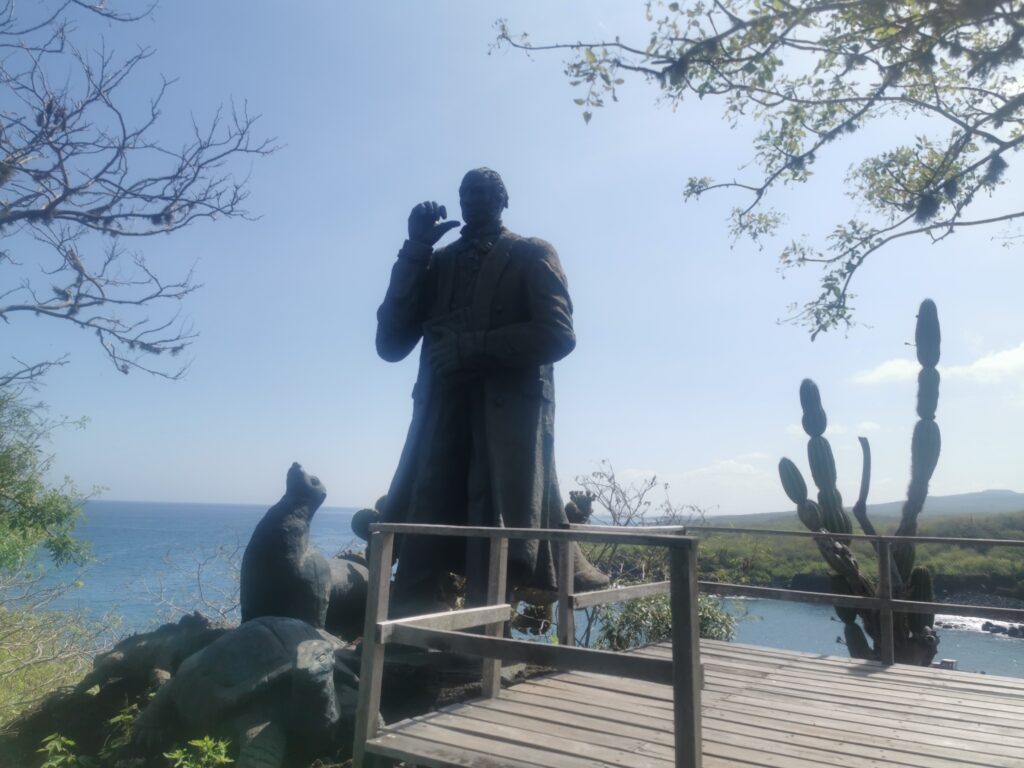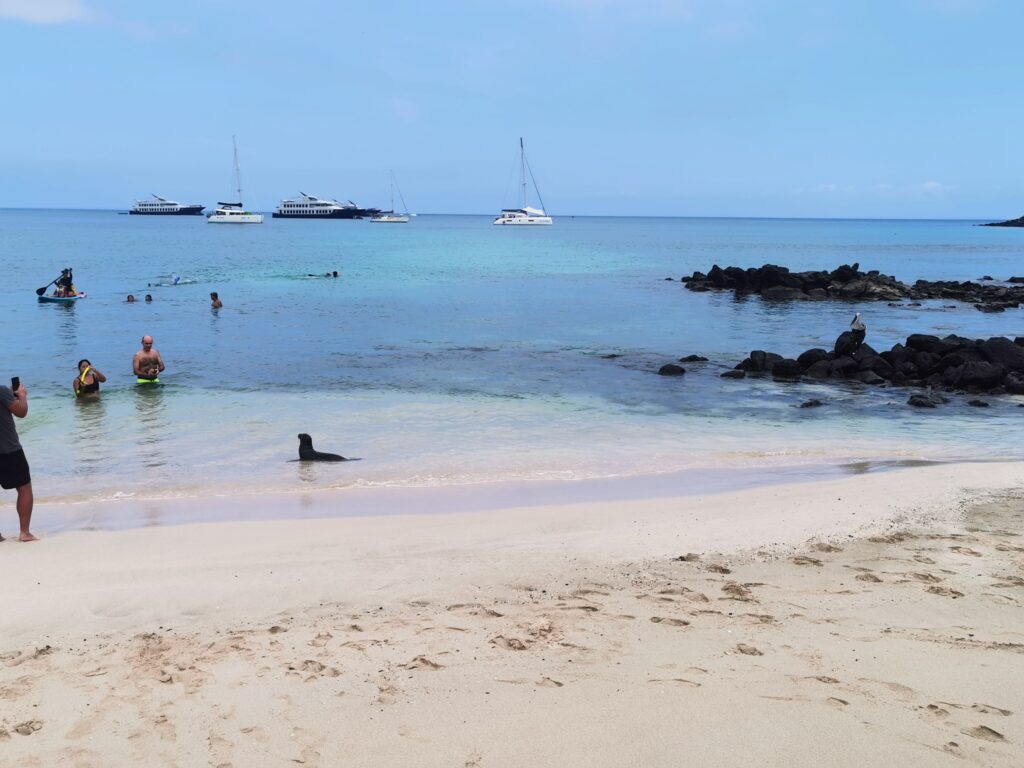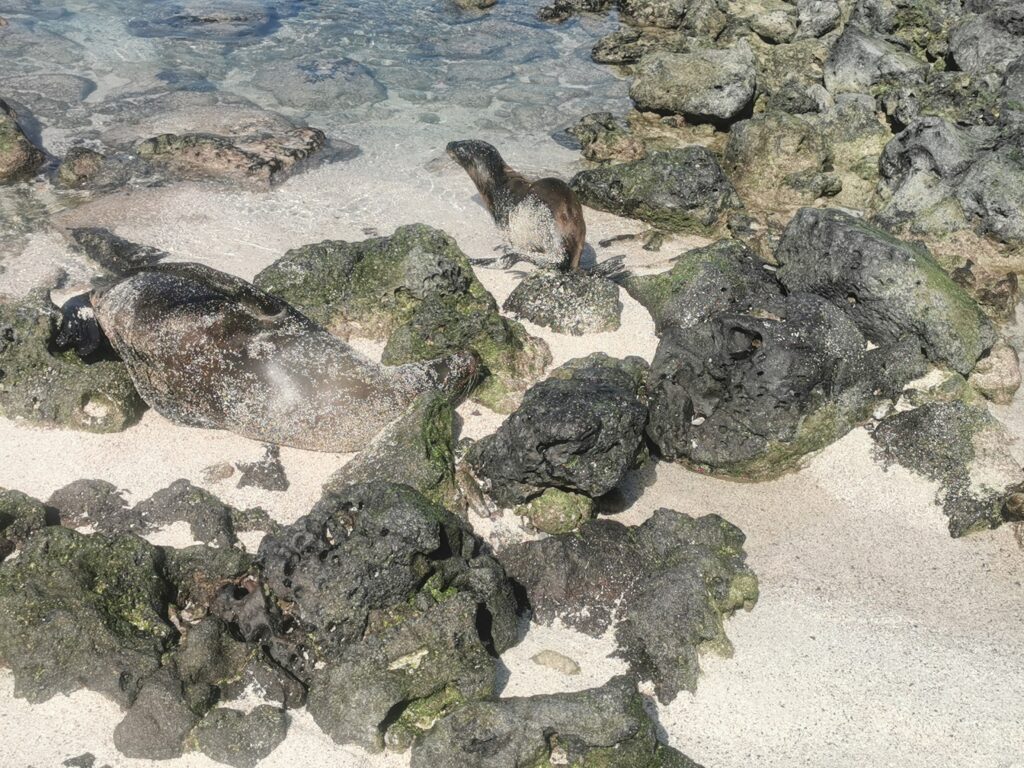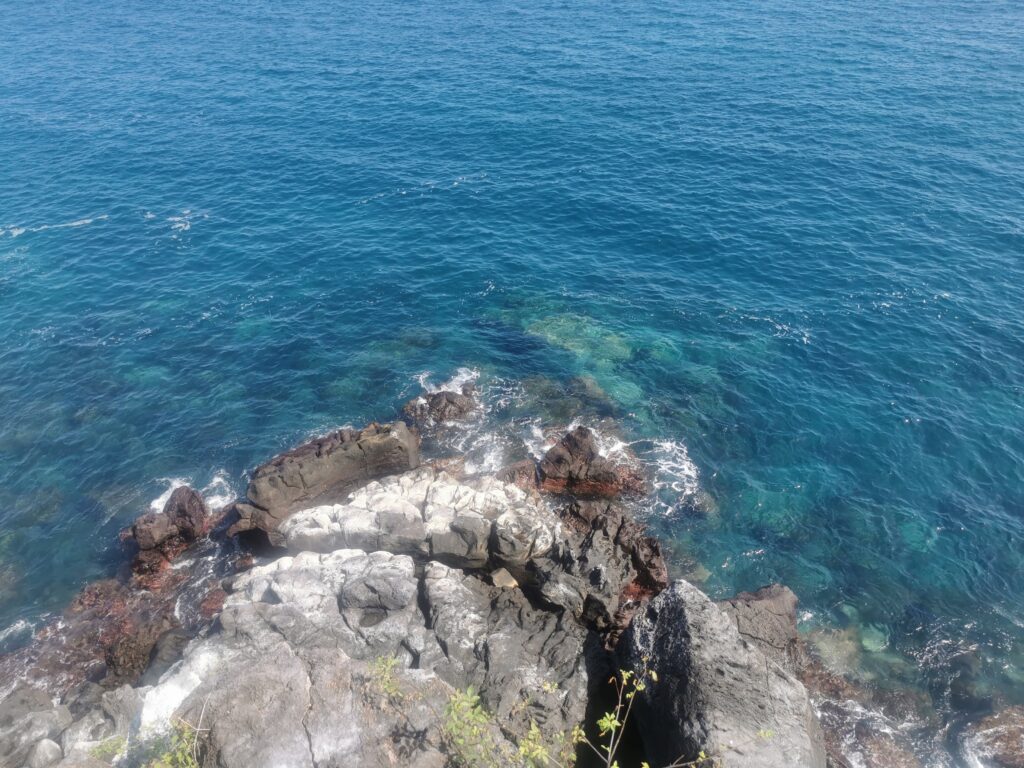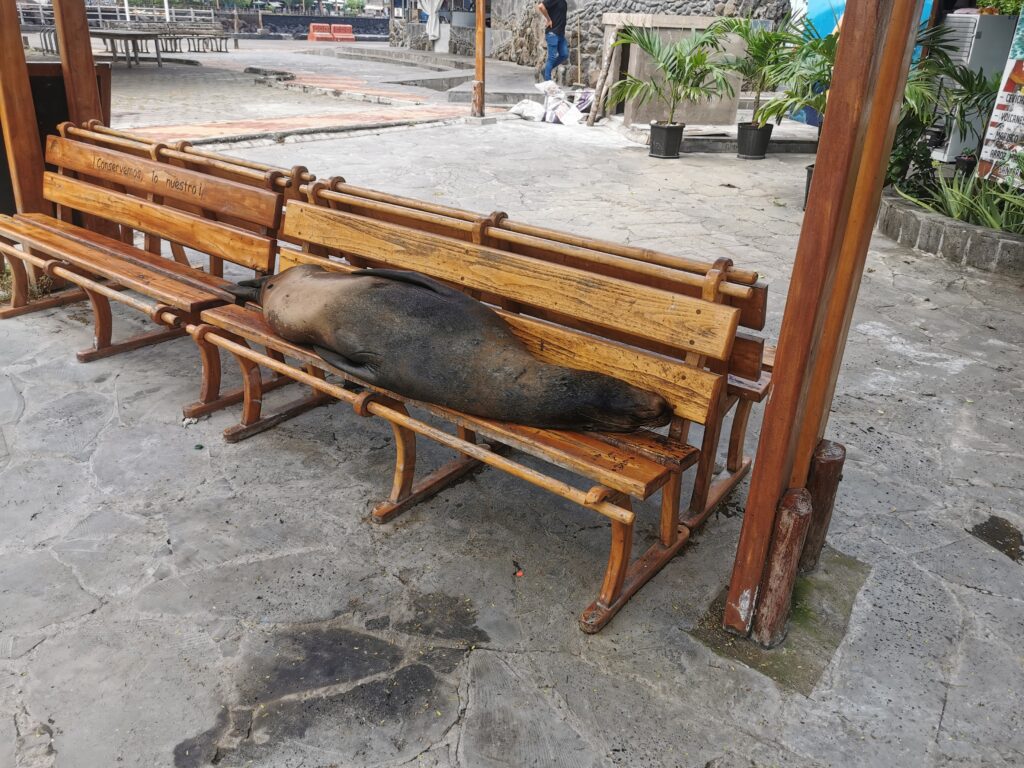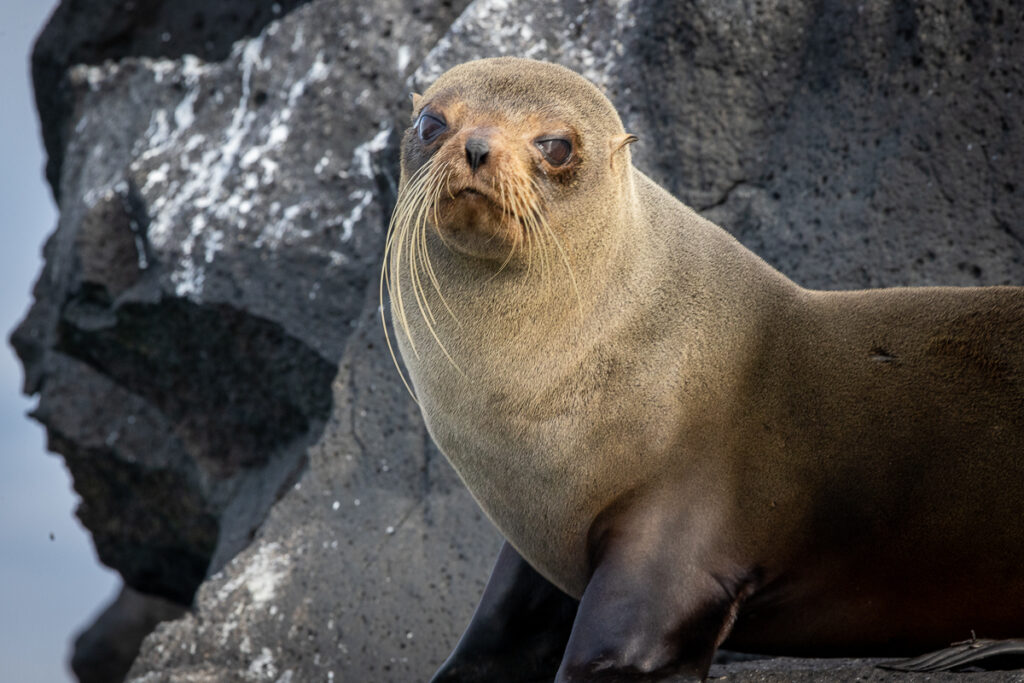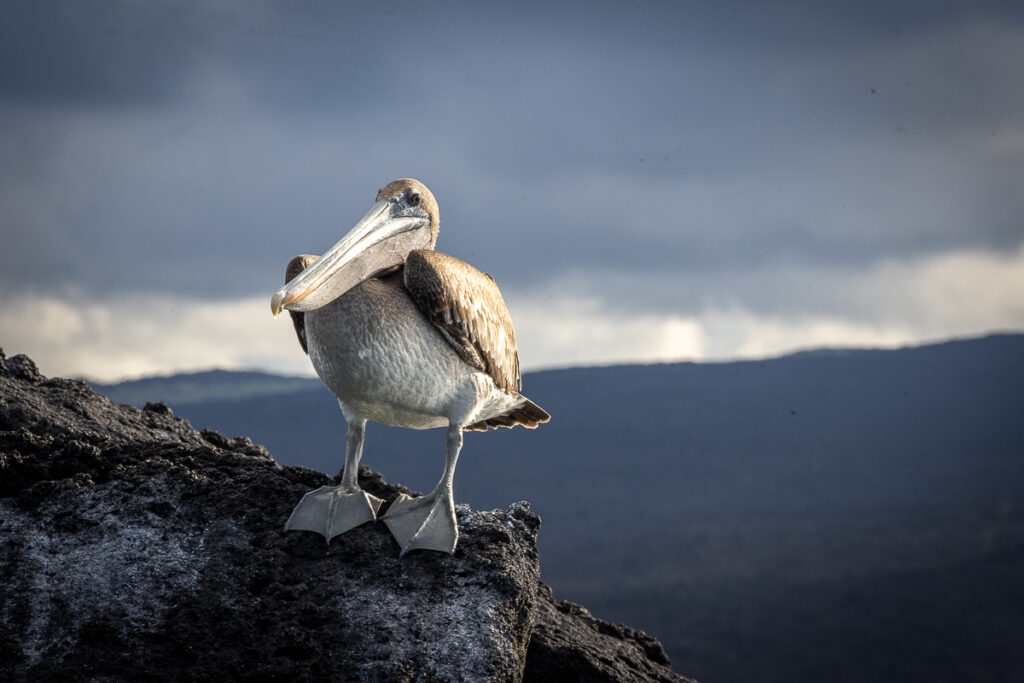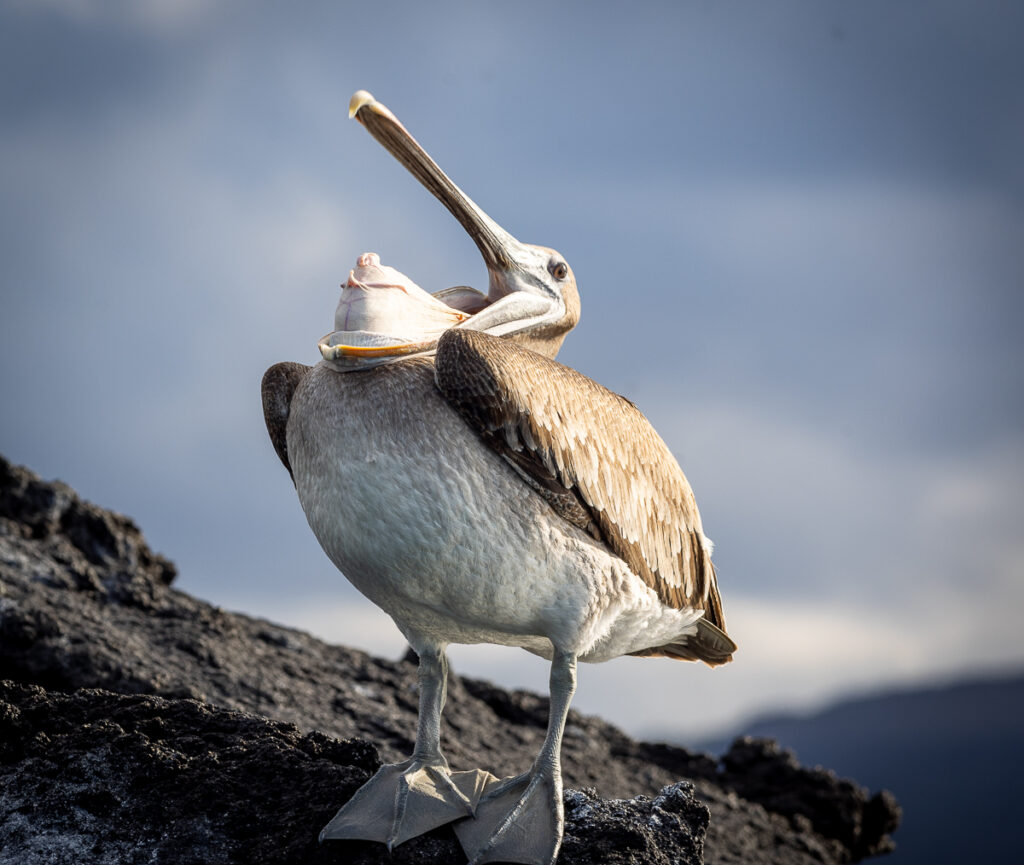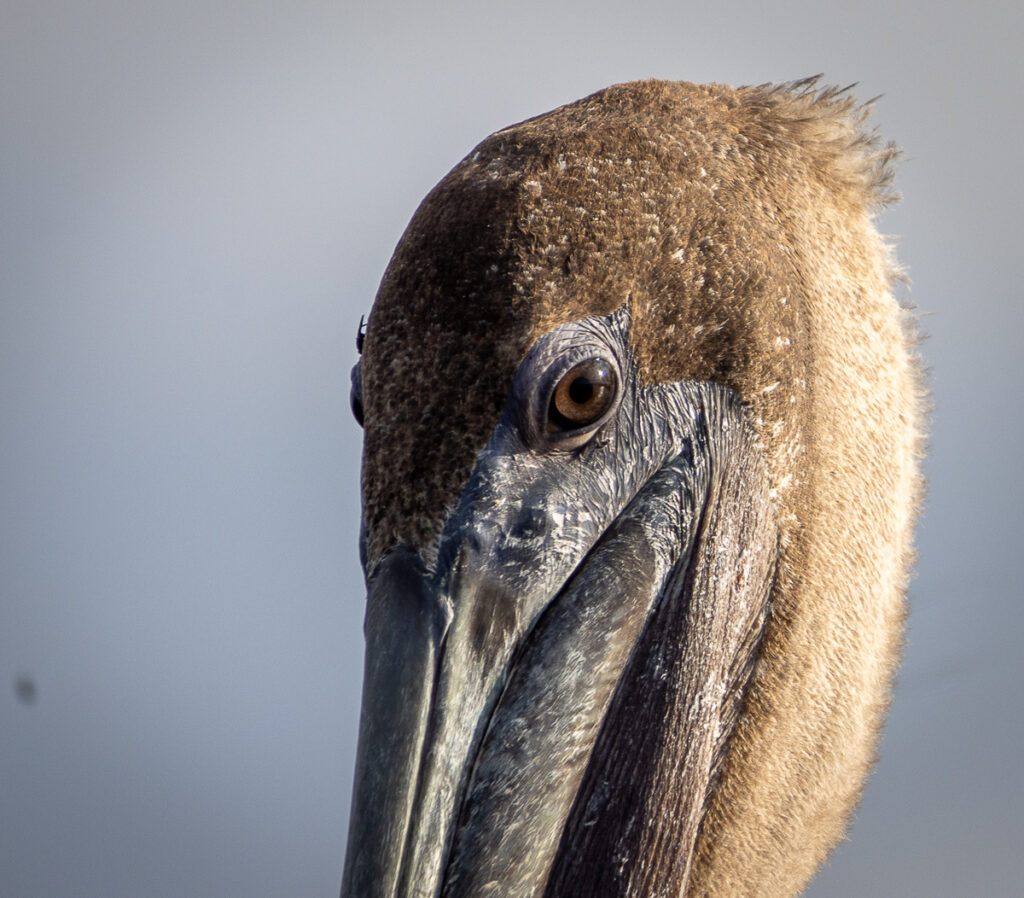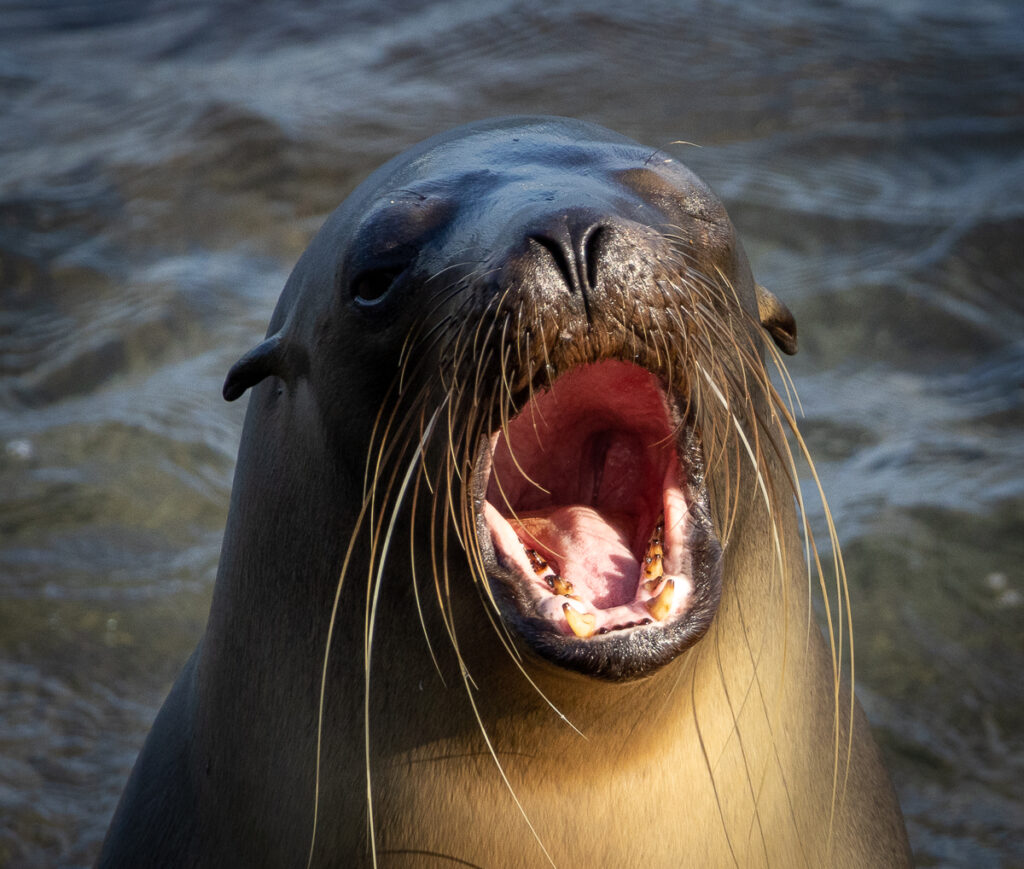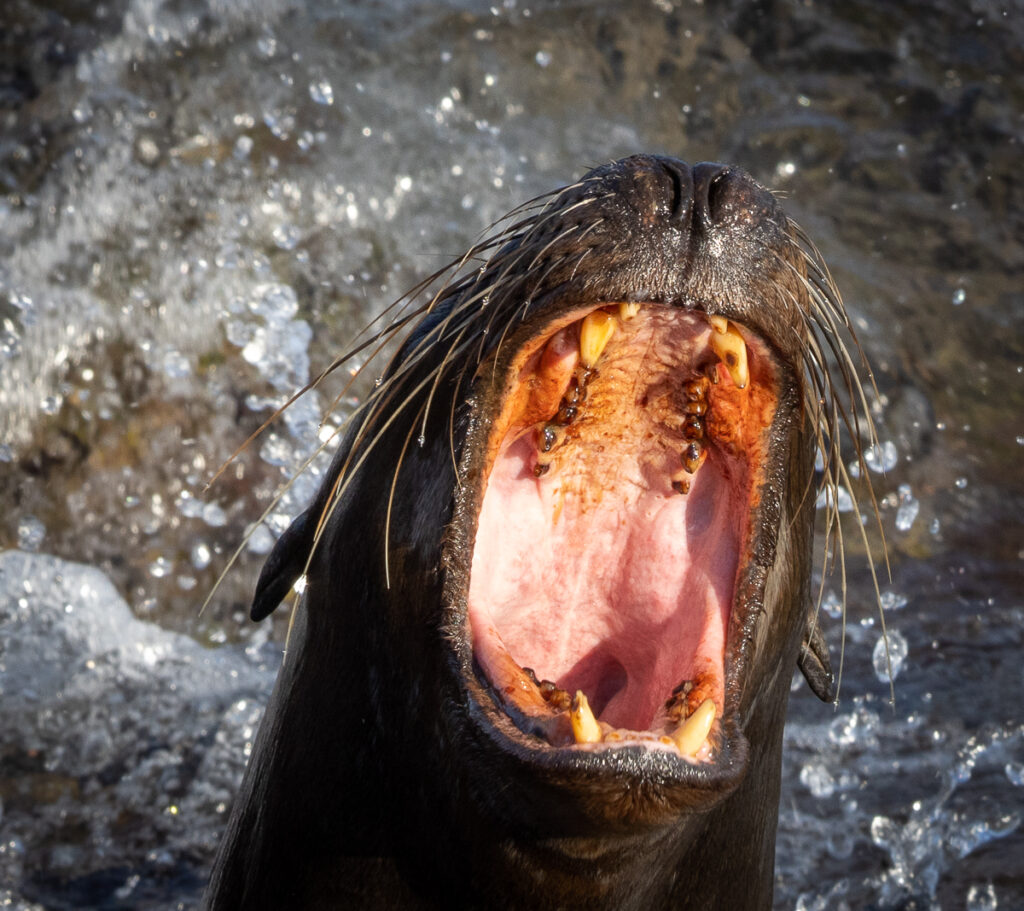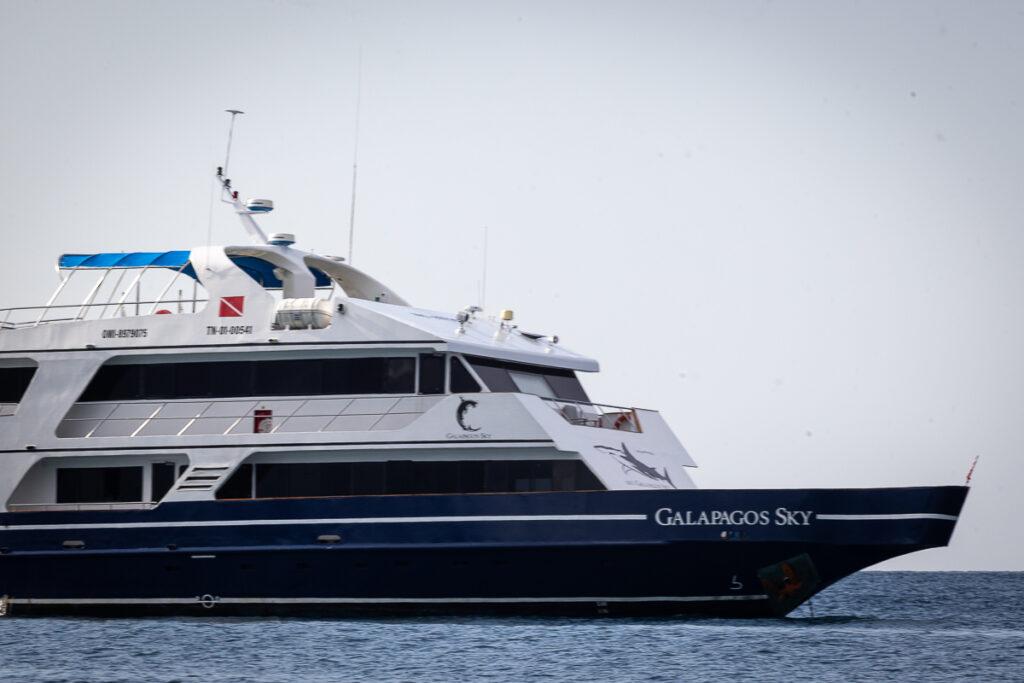The Galapagos Islands have long been on my go-to list for diving. In March 2024, I had the chance to do a liveaboard trip on the Galapagos Sky. This is my review of the Galapagos Sky diving cruise. Find out about the boat and how good the diving in the Galapagos really is.
Content of this article:
Getting on the Galapagos sky
The Galapagos Sky departs from San Cristobal, so be aware when you book your flights. There are two airports in the Galapagos. The one you need is SCY.
No international flights are getting directly to the Galapagos, so you need to fly to either Quito or Guayaquil in Ecuador. You can book the domestic flights through the Galapagos Sky, and they will assist you at the airport. Most passengers arrived on the recommended flight from Quito or Guayaquil. They were picked up at the airport and driven straight to the pier and taken on the boat.
Tip: If you organize your own flight, arrive at the airport early. You need to pay a fee for the Galapagos and do a special bag scanning for the Galapagos before check-in, so allow 30-45 minutes for that.
I spent the previous week on the Galapagos Theory, a cruise ship that offers snorkeling and adventure trips in the Galapagos. The Galapagos Sky and the Theory belong to the same company, so they organize a seamless transfer between them. It is the perfect combination, and if you can take two weeks of holiday, I highly recommend it.
My bags were taken from one boat to the next while I was taken on a morning tour of the highlands of St Cristobal.
I met the Galapagos Sky team at the pier around lunchtime.
After a short Zodia ride from the pier, we were greeted on the Galapagos Sky with cold towels and fruit juice.
The Galapagos Sky crew got straight into the serious things with the boat briefing. We were then assigned our cabins. The rest of the afternoon was spent with lunch, a dive briefing, and our first check dive. The check dive was near San Cristobal and was really just a check dive. There wasn’t much to see, and we stayed down for just 20 minutes to make sure everyone was properly weighted and had the right equipment. The “real” diving would only start the next morning.
Review of the Galapagos Sky liveaboard
The Galapagos Sky is a fantastic luxury boat. It was built 23 years ago, so it is not the newest liveaboard out there, but it has been well-designed and seems purposed built for diving. It is spacious for 16 guests and never felt crowded.
The stairs and hallways are easy to navigate with anti-slip mats and fences. You can see that a lot of thought has gone into making the Galapagos Sky a safe and comfortable boat.
The main deck has a lounge, dining area, bar, and the diving deck
Lounge/Bar Review:
The lounge area is very spacious and has a warm, inviting atmosphere achieved through the use of natural wood. Large panoramic windows offer stunning views of the Galapagos Islands while we sail.
Large and comfortable sofas are available. Power plugs are conveniently located under the sofa, making it a great place to work or review your diving pictures. This area is thoughtfully designed with two TVs, used primarily for the daily dive briefings.
Adjacent to the lounge is an indoor bar. The bar doesn’t disappoint, providing full-service offerings throughout the day. The bartender skilfully prepares a wide range of cocktails. A word of caution: consuming alcohol before diving activities is prohibited. The bar menu includes a variety of regular drinks that are included in the Galapagos Sky experience. A selection of wines and premium spirits is available for purchase. However, the inclusive drink selection is so comprehensive that there’s hardly a need to explore premium options. Besides the drinks, a selection of snacks such as cookies and chips are perpetually at hand.
Dining Area Review:
The dining area aboard the Galapagos Sky, located right next to the lounge, presents a buffet setup for breakfast and lunch. The space accommodates five tables, each seating four people. During our voyage, guests often switched tables, providing a wonderful opportunity to meet and dine with different passengers each evening. In the dining area is also the tea and coffee station.
Top Deck review:
The top deck has the deluxe cabins, the bridge, and another seated area.
The seated area at the back of the boat is shaded with 2 large sofas and was a great place to read a book while looking at the landscape. There is a second bar there but it wasn’t used much. This area was the most popular area of the boat and often had a few people sitting around in between dives
Review of the Sundeck on the Galapagos Sky liveaboard
The sundeck of the Galapagos Sky liveaboard was my favorite area of the boat. It provides an expansive and versatile outdoor retreat. Spanning a generous area with a 360-degree panoramic view. The deck has been thoughtfully designed and is divided into two zones. One half of the deck is shaded, providing a cool respite from the sun. The other half of the deck is exposed to full sunlight and caters to those who wish to soak up the warmth and get a bit of a tan.
The sundeck is furnished to ensure that everyone can find their comfortable spot. It offers eight sun loungers for those who want to soak up the sun. In addition, there are two hammocks that sway gently in the breeze, and two daybeds that provide the perfect spot for an afternoon nap or leisurely lounging in the sun. You will also find several chairs scattered throughout, ensuring that there is always enough seating for every guest.
I often used to be alone on the sundeck, making it a personal haven for peace and reflection.
Review of the cabins on the Galapagos Sky liveaboard
There are 2 types of cabins onboard. The deluxe cabins on the top deck have a panoramic window of the sea. The beds can be pushed together or used as 2 single beds.
Tip: It is worth upgrading to the deluxe cabin but you need to book early as those cabins are often fully booked
I stayed in a standard cabin located on the lower deck. There are four cabins below the deck. The standard cabin won’t win any beauty prizes, but it is comfortable. It is equipped with two twin beds that can’t be joined. It has a lot of wood, giving it a warm feeling. There are 2 porthole windows. They can’t be opened and don’t really have a view of the surrounding landscape as the windows are slented but they do provide sunlight into the cabin.
My cabin was located at the front of the boat. Usually, this can be problematic as the front tends to move more than other parts of the boat. However, during this trip, I wasn’t bothered by it as the boat wasn’t moving excessively and the water around the Galapagos is usually calm.
There is a cupboard with a safety deposit box. The cupboard is short so there is no space to hang dresses, but there is a lot of space for other clothes.
In addition, there are many drawers under the bed to store more belongings.
Tip: there is only one electrical plug in the room so if you need to charge more than 1 device, you might want to bring an adaptor. The Power is 110 V, US type plug so bring a travel adaptor if you come from Europe
The bathroom is quite spacious for a liveaboard with a separate shower. The toilet has a normal flushing system. The water pressure is good and there was always enough hot water. Shower gel, shampoo, and conditioner are provided.
Review of the food on the Galapagos Sky liveaboard
On the Galápagos Sky liveaboard, diving is obviously the main draw, but the food definitely holds its own as a major highlight of the trip. The meals onboard blend local flavors with dishes from around the world in a really satisfying way.
Breakfast is a buffet with a good variety. Every day, you can expect four hot options that change, alongside staples like fruit, cheese, bread, granola, and cereals. You also get two types of fresh juice. It’s a great setup that caters to all kinds of tastes, using fresh and appealing ingredients.
Lunch follows the buffet style too, offering a hearty selection of both meat and vegetables. The effort to use fresh, often locally sourced ingredients is clear and makes each meal feel special and delicious.
Dinner is a more structured affair, a sit-down meal with four courses: an appetizer, a soup, a main dish, and dessert. You get to pick your main dish during lunch, which is a nice touch. The quality of food is surprisingly good for a liveaboard, with attention paid to the quality of ingredients and how the food is presented. Despite all the activity from diving, you might find yourself a bit heavier by the end of the trip, but it’s worth it because the food is great. The only thing I didn’t understand was how they could serve octopus to a group of divers. I was, however, happy to see that everyone at my table refused to eat the octopus :-). I would rather see them in the sea than on my plate.
Review of the Galapagos Sky Crew: Passionate and Knowledgeable:
During my journey, I had an amazing experience with the crew of the Galapagos Sky Dive Boat. They were passionate about the Galapagos Islands and their expertise in ensuring an unforgettable diving experience was remarkable. The crew, including two experienced dive masters, had an in-depth knowledge of the marine life and ecosystems, and they were enthusiastic about sharing their insights with us. Their professionalism and expertise instilled confidence, making it possible for us to fully immerse ourselves in the wonders of the underwater world.
They were one of the most proactive crews I have ever seen on the dive deck. Every staff member was on hand to assist us with our wetsuits before and after the dive. They would help us put on the wetsuit (which can be quite tricky with a 7mm wetsuit) and carry out all the necessary checks for us. After the dive, we were greeted with a hot drink, a hot towel, and some snacks which made us feel truly pampered.
It’s worth noting that many of the crew members have been working on the Galapagos Sky for over 10 years. The boat has a great atmosphere, and the crew is well-organized.
The boat captain is also an avid diver, and having a captain who understands divers’ needs makes a difference.
Review of the diving organization on the Galapagos Sky
Galapagos National Park and Galapagos sky diving rules
There are more than 80 dive sites in the Galapagos reserve marine. It is a mix of walls, pinnacles, blue water dives, and even caves.
As the Galapagos Islands are a marine conservation area and national park, specific rules must be observed while diving here. Liveaboards are only allowed to dive certain sites and all the sites must be pre-booked before the trip. The boats don’t have much flexibility to adjust the planning depending on the weather or the sea conditions.
The Galapagos National Park issues every vessel in Galapagos an annual permit. This permit is set with the itinerary for the year that tells us which day(s) a boat can be at any site, how many dives they can do there, how long they are allowed to dive and how deep they may dive. All of this is carefully coordinated to ensure that the vessels are in different locations for less impact on the marine life and a better experience for the diver/visitors. Galapagos takes great care to reduce the impacts of tourism. Galapagos Sky is fortunate to have Cabo Douglas (marine iguanas) and Punta Vicente Roca (in their permit. Not every scuba liveaboard have those dive sites on their itinerary.
Tip: When booking a Galapagos cruise, check the itinerary because not all the boats have a permit to dive the best dive sites.
Because of this permit system, we were the only boat at all the dive sites we covered during the week. This is truly a luxurious experience to dive into world-class dive sites without any crowd. If you have dived in Egypt, the Maldives, or Indonesia, you know how crowded some of the popular dive sites can be.
It is not allowed to approach less than 2 meters from the animals. The exceptions are the dolphins and sea lions that might want to interact with you and come very very close. I had sea lions coming right in front of my mask!
Tip: Having a dive computer is mandatory, so make sure you bring one.
The maximum depth is 30 meters, and the maximum dive time is 50 minutes, which felt short as most of the dives were shallow, so we could have done longer dives. I would usually surface with 100-140 bars remaining. Buddy teams need to go up as soon as the first buddy is low on air so make sure you have a buddy with an air consumption similar to you
A safety stop is mandatory for 3 minutes at 5 meters
For safety, the Galapagos Sky provides Nautilus GPS trackers to every diver. They will be able to find you if you drift into the ocean. They also provided an SMB and a diving horn so you can feel safe.
Zodiac diving
All the dives are from pangas (Zodiac boats). We were separated into two groups. There were only 10 divers during my trip so the group size was small. At maximum capacity, the boat can hold 16 divers, and each group would have 8 divers
The crew took care of all the equipment, so we only needed to bring our masks to the Zodiac. We had to enter the ZOdiac carrying our tank on our back. I was a bit worried about that, but it was easier than it looked. The staircase to get to the Zodiac is large and easy, and they have 3 people helping you step into the Zodiac, so you feel stable at all time
The Zodiac is well-designed and comfortable. The crew assisted us in getting back into the zodiac and lifting our tanks out of the water after the dive, which was also very easy. They would then unload all the equipment back onto the boat and rinse our cameras and wetsuits. It was truly a 5-star diving service.
Some of the dives are done with negative entry backrolls, so make sure you master that before your trip to the Galapagos.
Tip: The current and swell can be strong and require intense finning. Bring some diving socks to avoid blisters.
Review of the dive deck on the Galapagos Sky
The dive deck is spacious and well-organized. With 10 divers, it felt spacious. At the beginning of the cruise, you will be assigned a space with a storage box underneath a seat.
Towel service is well-organized. Diving towels with your cabin number will be dried off for you, so you can have a plush and warm towel waiting after every dive. Additionally, fruits, cakes, or snacks are offered after every dive, and after the coldest dive, hot chocolate or hot tea is even provided. It’s a great way to warm up!
Dive briefing and diving groups
The Galapagos Sky offered 3 to 4 dives a day. No night dives are offered. The dive time was usually 9 am, 10:45 am, 2:45 pm and 4:30 pm. It could change a bit depending on the navigation time between dive site
The dive briefings were informative. They included well-drawn maps of each dive site and information about the marine life we could expect to see.
Our dive guides, Quike and Natasha, were both exceptional. They possess extensive experience in the Galapagos and possess an innate ability to locate the best underwater action. On the Galapagos Sky, both dive guides take turns leading the two groups on each dive, so you get to dive with both of them.
The quality of dive guides on a trip can often make the difference between a good and a great experience. I believe that guiding a dive requires more art than science. In addition to knowledge of the dive site, you need a good instinct (and a bit of luck) to anticipate where the action will be. Quike and Natasha both possess those instincts. Quike would often lead us into the blue and uncover the action. From schooling mobulas and dancing mantas to mola mola or fighting dolphins, he has an incredible eye and is a valuable asset to the Galapagos Sky.
During our diving excursion, Quike brought his camera along and captured some stunning photos. He was kind enough to share these photos with us after the dive. Many of the photos below were taken by Quike, and we would like to give credit where credit is due. Thank you, Quike Moran, for sharing your photos with us!
Water temperature when diving in the Galapagos
I was there at the end of March which is the rainy and warmer season.
I was told that the water temperature was unusually warm. On many dive sites, we had temperatures of 27-29 degrees. Some dive Sites like Punta Vicente Rocca were, however, much colder, with temperatures of 20-22 degrees. At 25 meters depth during our Punta Rocca dive, we encountered thermoclines of 14 degrees!!
Tip: there is a huge variation of temperature during the dive site. You therefore might want to bring layers and adjust your wetsuit depending on the temperature. The crew was usually very good at predicting the water temperature for the various dive sites. I brought a 3 mil wetsuit that I used for most of the dives. On the 4 dives that were expected to be colder, I rented a 7 mm wetsuit from the Galapagos Sky. And I was happy to have 7 mm when the water temperature dropped to 14 degrees!!
When to dive the Galapagos Islands?
The Galapagos Islands experience both a wet and dry season. During our trip in March, which is considered the rainy season, we were fortunate to experience mostly sunny days with very little rain. However, during the week before our trip, on the Origin, Theory, and Evolve cruise, it rained heavily for the first 4 days, so rain can occur.
Located in the middle of the Panama Current, which flows from the north and has a water temperature range of 23 to 28 degrees Celsius, and the Humboldt Current, which is much colder at 16 to 25 degrees Celsius, the Galapagos Islands experience a range of temperatures. Additionally, the Cromwell current from the west creates a thermocline.
There is no bad time to dive in the Galapagos Islands, as the fish and hammerheads seem to always be there. We didn’t see any whale sharks during my trip, but I was told they saw one the week before, so it is possible to see them even outside of the whale shark season.
The visibility tends to be a bit better during the warmer rainy season.
Is diving the Galapagos Island good for beginners or snorkelers?
The Galapagos Sky doesn’t offer any option for snorkellers. For safety reasons, the Zodiac drivers focus exclusively on tracking the driver underwater by following their bubbles and have no time to look after snorkellers. If you are not a diver, I therefore do not recommend the Galapagos Sky. Their sister company, however, organizes amazing snorkeling and hiking trips. You can read about my review of the Origin, Theory, and Evolve here.
The Galapagos is also not recommended for new divers. The current can be strong, and some of the dives are negative entry, Furthermore, controlling your buoyancy and staying calm underwater is critical when encountering sharks or Mantas. This is why they recommend 50-100 dives experience and some current experience. It is however one of the most rewarding dive destinations for sharks and large schools of fish so it is definitely worth the extra efforts
Do you need Nitrox on a diving trip to the Galapagos?
Most of our dives in the Galapagos were between 15 and 25 meters, so using Nitrox will give you significantly more bottom time. I, therefore, recommend it on this trip. It is available for 200 USD for the trip. Everyone on our trip dived with Nitrox. The fill was consistent at 32 percent.
15-litre tanks are available for 60 dollars per week. Given the 50-minute dive limit and the generous fills ( we often started the dive with 230 bars), it might not be required.
How to know if your sunscreen is reef-safe?
Many commercial sunscreens contain harmful ingredients that can damage coral reefs. If you plan to visit a dive site, it’s best to avoid using sunscreen altogether since zodiac rides are usually short.
However, if you must use sunscreen, please make sure to choose a reef-safe option. You can identify these by checking the ingredients label for titanium dioxide and zinc oxide, which are generally recognized as safe. Unsafe ingredients to avoid include PABA and trolanlminevsalicytate. Some countries have also banned Octinoxate and Oxybenzone.
Update: Since my trip, it has now become a national park rule to use reef safe suscreen. The use of sunscreen containing the chemicals oxybenzone, octinoxate, and others harmful to marine ecosystems is regulated and restricted to sustain and protect the coral reefs.
Diving itinerary during our Galapagos Sky liveaboard
In March 2024, I went on a 7-night liveaboard cruise on the Galapagos Sky. During the trip, we visited some of the most famous dive sites in the Galapagos Islands. One of the highlights of the experience was the chance to encounter some of the ocean’s most magnificent creatures up close. These giants of the sea left us in awe. Read below for a day by day description of our trip. Each dive trip is unique but this can give you an idea of what to expect.
Day 2: Volcano hike and schooling eagle rays and Mobula rays.
The day began with a hike to the peak of Bartolome Island, which is a volcanic island. The landscape is otherworldly and the view from the top is breathtaking. The hike is easy, but it can get hot, so it’s recommended to bring a bottle of water to stay hydrated.
Tip: you can do the hikes in flip flops as there are wooden stairs to the top. watch out as some of the steps are broken. Bring mosquito repellent.
After the hike, we went on a small zodiac ride to look for penguins and Galapagos birds. This was a great way to explore some of the Galapagos sights and to warm up before the first dive.
Bartolome island dive site– La Punta.
Our dive at Bartholome Island was an unforgettable introduction to the underwater wonders of the Galápagos Islands. We descended to a sandy bottom at around 10 meters and were immediately greeted by the sight of a cleaning station. It was a hive of activity where two curious turtles seemed just as interested in us as we were in them.
We were thrilled to see about ten white-tip sharks patrolling the area. They moved gracefully through the water, adding to the excitement of our adventure. However, the real magic of the Galápagos happened when we went deeper into the blue. We found ourselves surrounded by a massive school of mobulas, eagle rays, and golden rays. They danced around us, creating shadows and light that mesmerized us in the vast openness of the sea. A playful sea lion added to the magic of the scene.
Just when we thought the dive couldn’t get any more spectacular, four hammerhead sharks made their grand entrance. They returned a few times throughout the dive, obviously attracted by the huge amount of schooling fish.
For a first dive in the Galápagos, it set an exceptionally high bar, offering a glimpse into a world where nature’s marvels know no bounds. The dive at Bartholomew Island was, without a doubt, extraordinary.
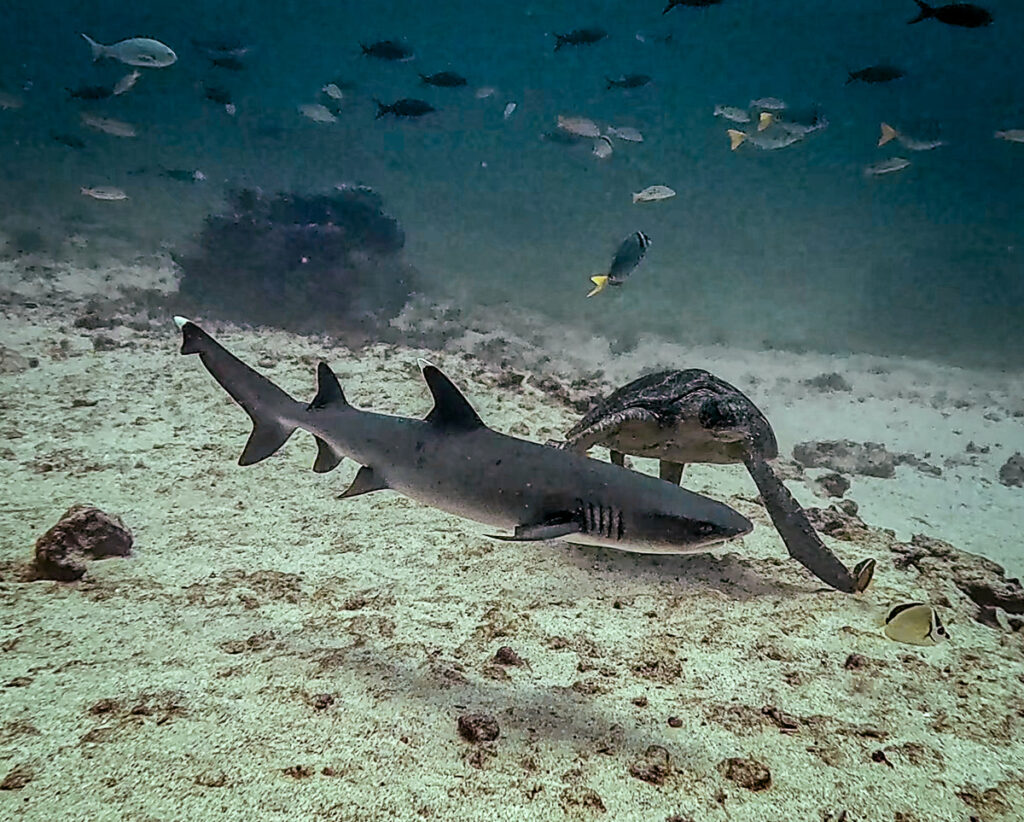
Cousin rock dive site
Our next dives took us to the nearby Cousin Rock, a site that is known for its distinctive underwater topography and the presence of black corrals
Cousin Rock is a reef that lies beneath the sea. It is a vast plateau with shallow waters at 2 meters and deeper reefs over 80 meters. Cousin Rock has a complex landscape that creates habitats for marine life. One side of the rock descends into a dramatic wall, while the other side slopes gently. The rock is covered in black corals that radiate a vibrant green hue underwater, which adds a surreal quality to diving.
The currents were almost non-existent during our dives, allowing us to explore the site serenely. A few white-tip sharks patrolled the edges, and Pacific green sea turtles slept in the alcoves carved by the cliff’s face.
The ocean was teeming with life. A vast number of fish thrived in the blue waters, creating a bustling city of movement and color. Small barracudas held their ground near the reef’s edge, while tunas and jacks performed their ritual of the hunt beyond them. It was a mesmerizing dance of predator and prey.
Day 3: Cold water, mola mola, hunting sea lions and too many turtles
Fernandina dive site
We went on two dives, at Fernandina. This dive site is famous for the presence of marine iguanas. The dive site had a lot of big rocks, and the water wasn’t very clear, with a surge in the water. We didn’t get to see the marine iguanas, but some of us saw a Sunfish and a penguin. There were also some playful sea lions and turtles around, which was nice.
Punta Vicente Roca dive site
Diving at Punta Vicente Roca offers a unique and breathtaking underwater experience that showcases the Galapagos Islands’ dramatic cliffs, diverse marine life, and volcanic formations. Located on Isabela Island, Punta Vicente Roca is known for its rich biodiversity and the opportunity to encounter unique marine species. This place is known for spotting Mola Mola, so we quickly went down to 30 meters hoping to see them. Right away, we saw two Galapagos sharks and a marble ray. Then, a Mola Mola passed by, which was really cool. Molas are 500000 years old! And they look very different from anything else!
The temperature down there was a whopping 14 degrees! It was so cold, and it was crazy how within 2 meters, the water temperature dropped from 24 degrees to 14 degrees!! I had never experienced such strong thermoclines before.
Tip: Make sure you wear a thick wetsuit for this dive as it can get really cold
The mola mola didn’t stay for very long but neither did we. After seeing the mola cruising by, we started to ascend to warmer water.
As we started going back up, we swam through a massive group of Salema fish and saw over 15 turtles getting cleaned. These graceful creatures glided through the water with ease, their serene presence adding a sense of tranquility to the dive. Then, things got really exciting when three sea lions came down to hunt, making all the fish scatter. A flightless cormorant also the fray, which was an amazing spectacle.
When we surfaced, whales were breaching in the distance. The dive quickly turned into a whale-watching trip and for 30 minutes, we went looking for them in the zodiac. There were 3 or 4 Bryde’s whales and many molas and mobulas jumping out of the water. What a great way to end the day.
Day 4. Darwin arch – Between the dolphins and the hammerhead sharks
Darwin Arch dive site
Darwin is considered to be the most famous and best dive site in the Galapagos. It is a small rocky island located 180 kilometres north of Isabella Island, which took us the entire night to navigate to. The island is full of birds and is situated next to a small rock that used to be an arch. Many people still refer to it as the Darwin Arch, even though it collapsed in 2021, leaving behind some pillars. During our visit, we were able to do four dives on the northeast corner of the Arch.
As we descended into the crystal-clear waters around Darwin’s Arch, the excitement within me started to build up. This iconic dive site is well-known for its incredible biodiversity, and I was eager to see what was waiting for me below. Although there was very little current during our dive, we could still feel the surge in the shallower area. The landscape around Darwin Arch is striking, with large rocks cascading down to the sea and interspersed with sandy areas.
The following is a corrected version of the original text:
The large rock formations created balcony-like platforms for us to enjoy the show happening out in the blue. Within one minute of our first dive, we saw our first hammerhead shark. Their distinctive silhouettes and graceful movements created a surreal underwater spectacle. We continued to see them, as well as Galapagos sharks, throughout all of our dives. Though these creatures were big and impressive, they seemed uninterested in us. We even saw a school of about 25 hammerheads swimming by. Swimming alongside these majestic creatures, I marveled at their sheer numbers and the harmony of their synchronized swimming.
The diversity of marine life at Darwin’s Arch was astounding. Schools of colorful reef fish swam among the coral formations, creating a vibrant and lively underwater environment. With their sleek bodies and piercing eyes, Galapagos sharks patrolled the area, adding a touch of mystery to the scene. Sea turtles, seemingly unperturbed by our presence, gracefully swam by, while playful sea lions darted in and out.
I saw the biggest tuna I had ever seen. It was interesting to observe that the schools of fish didn’t seem to care about the hammerheads, but would flee as soon as the tuna appeared. An eagle ray also came to check us out, and the amount of fish around us was truly incredible. It is definitely one of the most fish-filled places I have ever dived in.
Throughout the day, we spotted dolphins and silky sharks near our boat. On our last dive, we even heard dolphins singing underwater, which was beautiful. Then, they came near the surface and we saw that two of them seemed to be either fighting or playing, but it was hard to tell. Either way, it was a fantastic way to finish a wonderful day of diving at Darwin.
As the sun was setting, our boat cruised by the collapsed arch, giving us a great view before we headed off towards Wolf Island. We wrapped up the day with a captain’s cocktail, celebrating with champagne and toasting a great day and the awesome crew on the Galapagos Sky.
Day 5 – Wolf Island: Shark day!
On the fifth day of our adventure, we woke up at Wolf Island, eager for more excitement. I woke up before sunrise and witnessed the magnificent view as the sun rose above the towering cliffs of the island, surrounded by thousands of birds beginning their day. It was a busy scene, with frigatebirds and red-footed boobies effortlessly flying around, making me wonder how they manage not to collide. What a serene and stunning way to start the day!
Wolf dive site
We did 4 dives along Shark Bay. It is a bay along the southeast coast of Wolf Island. The current was coming southeast, so the best place to dive was that corner, as this is where most fish congregate.
The dive site is mostly a slope from the shore made of large volcanic rocks. The rocks create many sheltering places for fish and critters and are good places for corals to grow. This is where I saw some of the nicest corals I have seen during my week diving in the Galapagos.
But most people don’t dive in Wolf for the corals. They dive looking for hammerheads. Hammerheads circle back and forth between Darwin and Wolf Islands and the Cocos Islands.
There are 3 cleaning stations. Descending into the depths of Wolf Island, I felt a sense of anticipation and excitement. This remote and isolated island is renowned for its thrilling dive experiences. As I ventured deeper, the first glimpses of hammerhead sharks appeared in the distance. These iconic creatures, with their distinctive silhouettes, were a sight to behold.
But the hammerheads were not the only stars of the show. With their sleek bodies and piercing eyes, Galapagos sharks patrolled the area. Their presence added to the adrenaline rush of the dive as I cautiously observed their graceful movements.
Tip: Look into the blue, as this is where most of the action is. Don’t forget to look up, too, as dolphins and whale sharks sometimes pass by.
We also encountered a few playful sea lions. It was fun to interact with them by the cliff even if the swell was big.
Towards the end of our third dive, we finally saw what we were hoping for: a school of about 30 hammerheads swimming towards us. It was an incredible sight to see these powerful, big sharks up close.
Day 6: Cape Marshall: Majestic Oceanic Mantas, barracudas, and fish hunting.
After a 160-kilometer nocturnal voyage, we woke up to a splendidly sunny morning on Isabela Island. Our dive site was shadowed by the imposing Wolf Volcano, and it was a dramatic landscape of black lava stones that have remained untouched by vegetation since the volcano’s eruption in 2022. We had an amazing day of three remarkable dives. The waters were teeming with an abundance of marine life, including swirling schools of grunts, yellow snappers, chromis, and surgeonfish, surpassing any I had previously encountered. The dive site slopes down from the shore with large rocks. At 15 to 20 meters, some areas become sandy bottoms with small rock seamounts.
Beneath us, the occasional hammerhead shark made an appearance. The highlight, however, was the encounter with four oceanic mantas, with two approaching closely, their movements a mesmerizing dance of curiosity. Their graceful maneuvers in our presence were one of the world’s greatest spectacles.
As we were enveloped in this undersea ballet, mobula, and eagle rays glided by, adding to the spectacle.
Then, a formidable yellowfin tuna made its presence known, masterfully hunting amidst the fish, a vivid display of the ocean’s raw beauty and hierarchy. The salema fish movement was like thunder underwater. A sea lion, along with bluefin trevallies, soon joined the fray, weaving through the chaos. Our path also crossed with a school of over a thousand barracudas, while white tip reef sharks lurked in abundance.
tip: don’t hesitate to go in the blue for part of the dive as the action can happen there too
Our final dive of the day culminated amidst a ball of salema fishes in the shallow area, a fitting close to an extraordinary day underwater.
Cape Marshall is often overshadowed by the famed Darwin and Wolf dive sites but for us, it truly delivered an unparalleled spectacle.
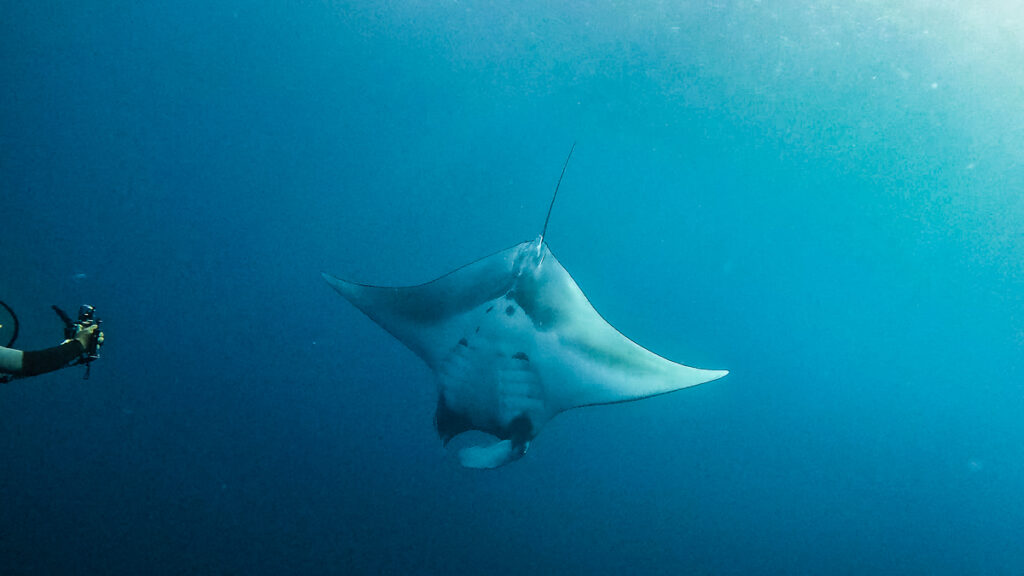
After our underwater adventures, a zodiac ride along the coast allowed us to search for Galapagos birds, from an adorable penguin to the iconic blue-footed boobies, herons, flightless cormorants, and pelicans.
Day 7: Fish Balls and Giant Tortoises
Pizon dive site
Unfortunately, it was already the last diving day of the trip, and we had only one dive today in order to allow a 24 hours interval before the flight.
We visited the Pizon Dive Site, located in the channel between Pinzon Island and a smaller rock affectionately termed Dumb Rock. Starting from Pinzon Island, we descended to a sandy bottom at approximately 15 meters depth. While the area promised sightings of batfish and octopuses for those keen on macro life, we found little. However, moving towards the Dumb Rock pinnacle, we encountered a richer marine life including jacks, tunas, and a pair of eagle rays, in addition to two turtles.
The undeniable highlight of the dive was the immense school of Salema fish—thousands and thousands of them! Swimming through this dense aggregation felt like entering a dark cave.
Tip: Bring a torch as it gets very dark inside the fish ball. The experience was further enhanced by the passage of a few turtles and a sealion diving amidst the fish ball, marking a memorable conclusion to our diving journey.
In the afternoon, everyone went to tour Santa Cruz Island in search of the giant tortoises, marveling at creatures that reach up to 150 cm in length and weigh as much as 250 kg. A brief trip by in town allowed for shopping
Tip: don’t miss the old fish market area. Fishermen boats come there with their catch and it is fun to see the 20 or 30 pelicans trying to get a piece!
Day 8: departure time
On the last morning, we went to visit the San Cristobal Interpretation Center before the flight. It serves as a comprehensive facility for learning about the natural and human history of the Galapagos islands. It’s a good stop for visitors who wish to gain a deeper understanding of the Galapagos Islands, their unique ecosystems, and the conservation efforts to preserve this remarkable archipelago. The center explains the volcanic origins of the islands, the arrival of species and their evolution, and the history of human settlement and impact. It also highlights the ongoing conservation work and challenges faced by the islands.
The 3D Map of the Galapagos was interesting from a diving point of view as it shows how deep the ocean is near some of the islands. Around the North of Isabella, the sea goes down to 3000 meters, and this is probably why there are so many big pelagics in that area, like mola molas and hammerhead sharks.
Behind the Interpretation Center is a trail that is a unique chance to explore nature in the Galapagos without a guide. The rest of the group had an 11 am flight and had to leave for the airport, but as I had decided to stay for an extra night in San Cristobal, I had time to hike this trail.
All the trails are very easy as the road has been paved. It takes about 2 hours if you don’t stop but if you want to snorkel or enjoy the beach, allow more time.
Tip: there is no signage on the trails so it is easy to get lost. Make sure you take a copy of this map if you go on your own.
Frigatebird Hill (Cerro Tijeretas): . The trail leads to the highest viewpoint offering panoramic views of the island and the sea. It’s named after the frigatebirds that are often seen hovering in the sky above. The hill is an excellent spot for bird watching, especially during the mating season when male frigatebirds inflate their red throat pouches to attract females.
Punta Carola Beach: This is one of the most beautiful beaches in San Cristobal, known for its calm waters and excellent snorkeling opportunities. I went for a walk on the beach and I saw at least 10 basking in the sun and sea lions frolicking in the surf.
Ensenada Tijeretas: This is a perfect spot for snorkeling and swimming alongside sea lions, sea turtles, and tropical fish. There is a platform that allows you an easy access to the sea
Tip: Bring your snorkeling gear and a towel and a lot of water as it gets hot on the trail
In conclusion of my review of the Galapagos Sky liveaboard
The Galapagos Sky trip was an amazing experience, and I now understand why it’s considered one of the best diving destinations in the world. I’ve been on over 30 liveaboard cruises, and this scuba diving expedition exceeded all my expectations. I had an up-close encounter with so much marine life, from schooling hammerheads and oceanic mantas to a school with over one thousand barracudas, fighting dolphins, and a mola mola. It’s also the best place in the world to see hammerhead sharks! Although it may not have the corals or critters of Indonesia, the number of fish here is unmatched.
If you are a diving enthusiast seeking an unparalleled underwater adventure, I wholeheartedly recommend embarking on the Galapagos Sky Diving liveaboard. The boat is super comfortable, the food great and the crew exceptional.
If you have time, I also recommend spending more time in the Galapagos before or after your diving cruise. You can combine your diving trip with an exploration trip on the Galapagos Origin, Theory, and Evolve, One of the most luxurious ways to see the Galapagos over the water in a small boat. It is very easy to combine the 2 trips as the boats belong to the same company and they will transfer you seamlessly from one boat to the next. You can read my review of that trip here.
Another option for a pre-or post-trip trip is to spend a few days at Enchanted Lodge Galapagos. You can read my review of the lodge here.
To book your trip on the Galapagos Sky, check their website here.

